Ohio State Highway Patrol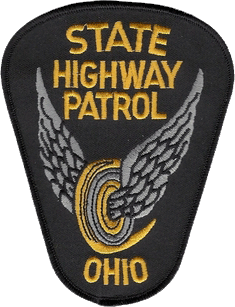
Ohio State Highway Patrol
Since 1917, various members of the Ohio legislature had introduced bills to create a statewide police force. Many people, especially members of labor unions, opposed these bills, fearing that the Ohio government would use this police force to end strikes. Finally, in 1933, the Ohio government created this statewide police force, which is known as the Ohio State Highway Patrol (OSHP).
The legislation creating the OSHP limited the patrolmen to enforcing motor vehicle laws on Ohio’s roads. A provision of the bill explicitly banned the OSHP from policing strikes and other forms of labor unrest. Initially, the OSHP consisted of sixty officers. The officers had to be between twenty-four and forty years of age. More than five thousand men applied to be one of the first sixty officers.
The OSHP established six district offices across Ohio, with three OSHP substations in each district. The district offices were in Toledo, Ravenna, Sidney, Delaware, Cambridge, and Chillicothe, while the substations were located in private homes across the district. The first patrol officers rode motorcycles, including in the dead of winter, to enforce the law. During its first year of existence, the OSHP accomplished much.
First, the OSHP succeeded in creating a statewide radio network, allowing law enforcement officials to communicate with each other across Ohio. For the time, it was the most comprehensive radio system in the United States. The OSHP also cited more than 120,000 drivers and made 4,233 arrests. In response to the OSHP’s early success, the Ohio legislature increased the number of patrolmen to 120 in 1935.
In 1941, the Ohio legislature authorized three hundred patrolmen. That same year, the OSHP began to patrol additional routes besides state highways. The OSHP now had responsibility over all Ohio roadways except for those in municipalities. At this time, the OSHP also became responsible for all driving tests, which a new driver had to take to prove that he or she was competent to drive a motor vehicle. To assist patrolmen in enforcing traffic laws as well as to assist officers in searches for missing persons, the OSHP began to use airplanes in 1948.
In 1950, the OSHP also began to patrol Lake Erie and other waterways. Use of radar for speed enforcement and "Intoximeters" for drunk driving offenses began in 1952. Since the mid-twentieth century, the OSHP has continued to expand in size and in responsibilities.
In 1968, the Ohio General Assembly removed any limitations on the maximum number of OSHP patrolmen. Rather, the General Assembly established a new requirement that the OSHP should have at least 880 officers. 27 were motor vehicle inspectors.
On March 23, 1981, OSHP Troopers were finally given the right of search and seizure within its jurisdiction as any other police officer. In the early 1990's, the OSHP unveiled its 1-800-GRAB-DUI program. This was a toll-free telephone number to report intoxicated drivers. To encourage participation, highway signs and license plates of OSHP patrol cars appeared throughout the Buckeye State. In just under a year, over 18,000 calls to the GRAB DUI phone line were recorded During the last decades of the twentieth century, the OSHP also became an important agency in stopping the illegal drug trade.
The main goals of the OSHP throughout the last half of the twentieth century and the first years of the twenty-first century, however, continued to be the enforcement of traffic laws on Ohio’s roadways and to ensure that Ohio’s drivers were safe and qualified to drive motor vehicles. To illustrate this point, in the first nine months of 2005, the OSHP made 757,441 traffic stops.
The OSHP operates with over 1300 uniformed officers and over 1000 support personnel throughout 54 Posts, four Turnpike Installations and administrative offices throughout the state.
1934 saw the introduction of the new state highway patrol's license plates for both automobile and motorcycles as it was late in 1933 before a fleet could be properly assembled and deployed. In fact they went "all out" and had agency-titled license plates from 1934 until 1942 before opting to run absolutely no license plates at all on their vehicles for decades thereafter.
The 1934 car plates were made of embossed steel. They measured 5 3/4" x 13 3/4" and colored white over maroon. The title HIGHWAY (over) PATROL occupied the left and center part of the plate followed by a number up to two digits. OHIO-1934 occupied the bottom center of the plate between the lower mounting holes. Deployed numbers went from number 4 to number 27 that year, as numbers 1 thru 3 went to the Governor and two other state officials.
The title HIGHWAY PATROL was only used for 1934. All subsequent OSHP license plates used STATE PATROL instead and the plates were the same format and color scheme as civilian license plates of the day.
A large debt of gratitude for the photographs and information seen on this page goes to Justin Kleinfelter and Lenny Fetterman. Two gentlemen who are as impassioned about the history preservation of this subject matter as I am.
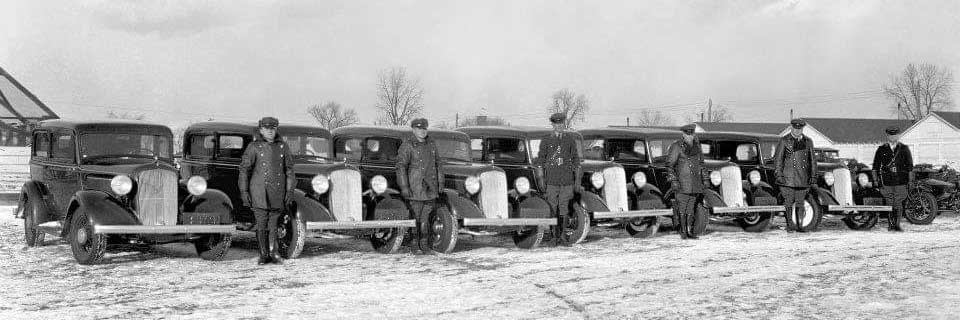 The beginning of it all- 1933
The beginning of it all- 1933
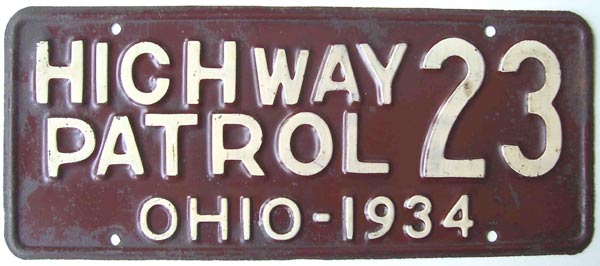 1934 issue. Embossed steel.
1934 issue. Embossed steel. 
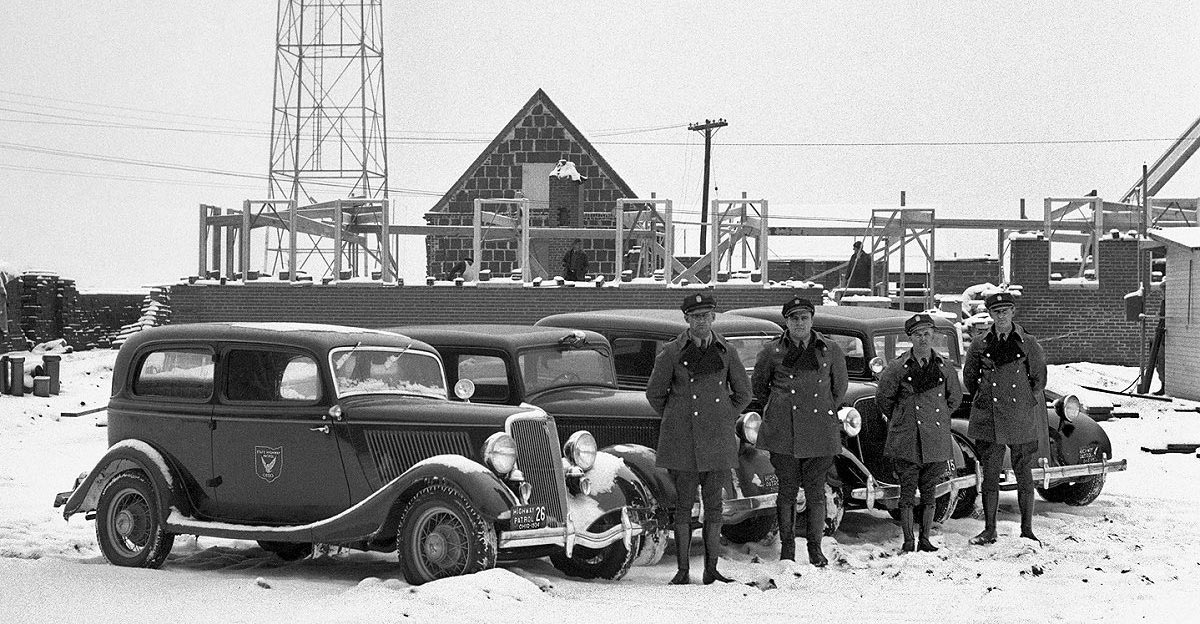
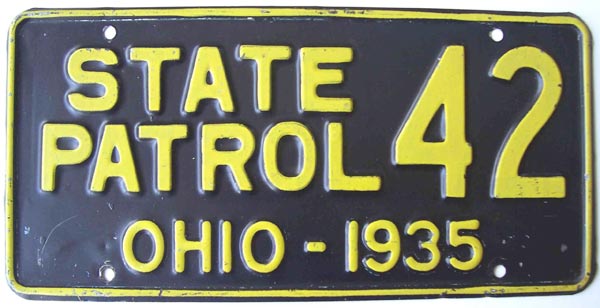 1935 issue. Embossed steel.
1935 issue. Embossed steel. 
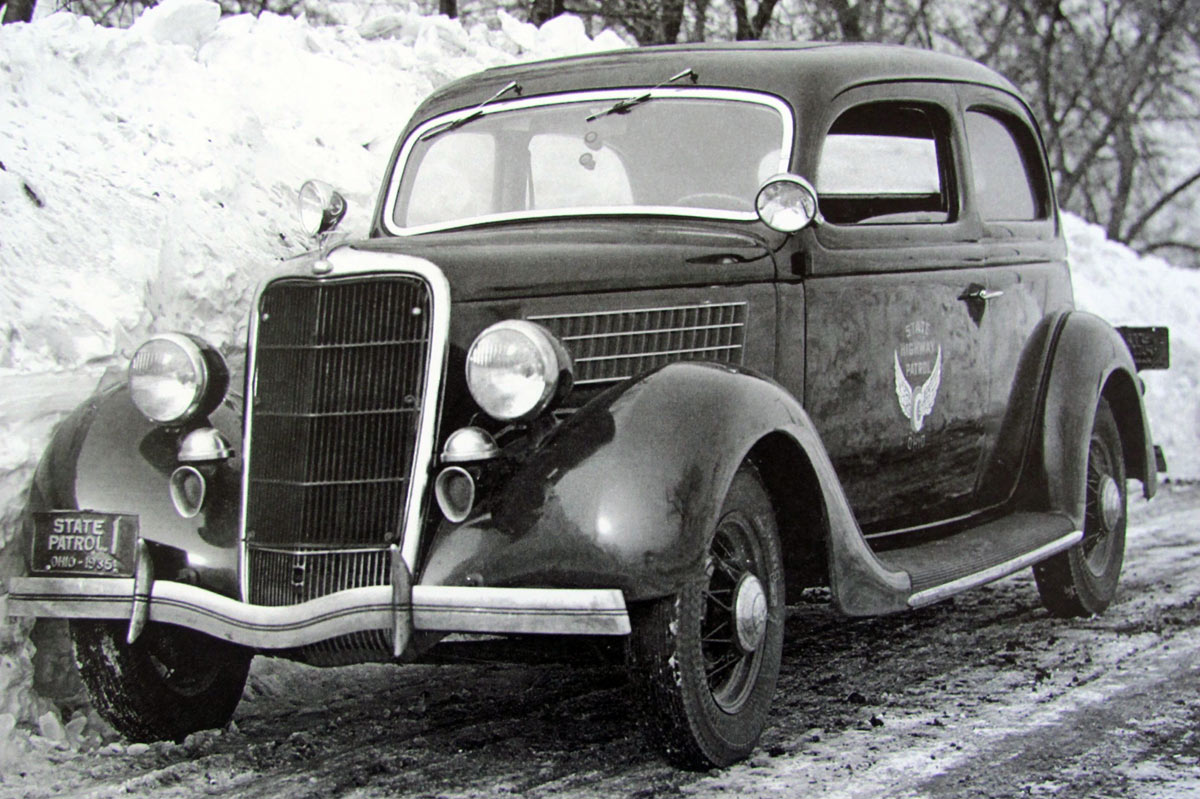
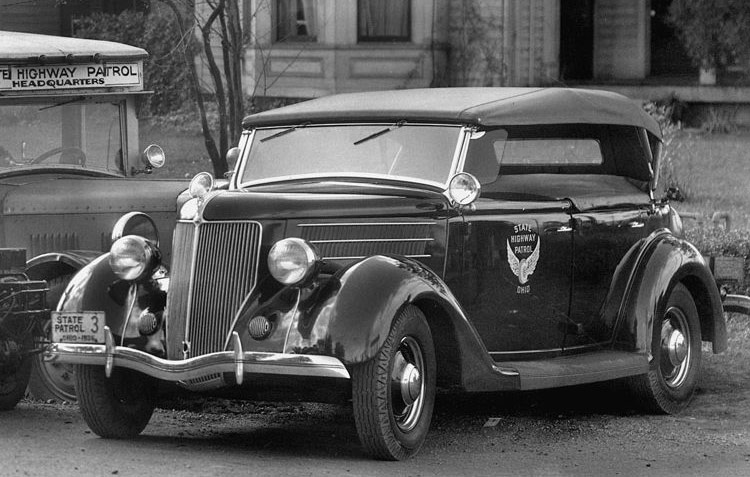

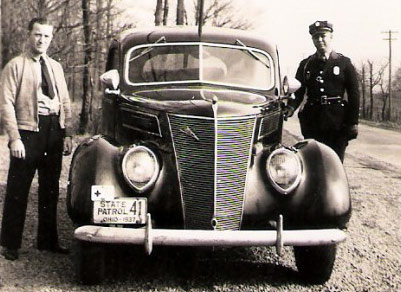 1937 issue. Maroon over white (Courtesy Justin Kleinfelter)
1937 issue. Maroon over white (Courtesy Justin Kleinfelter)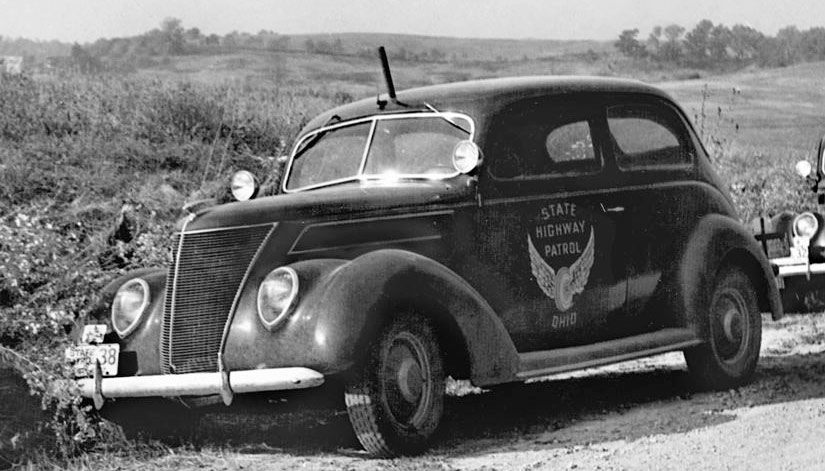
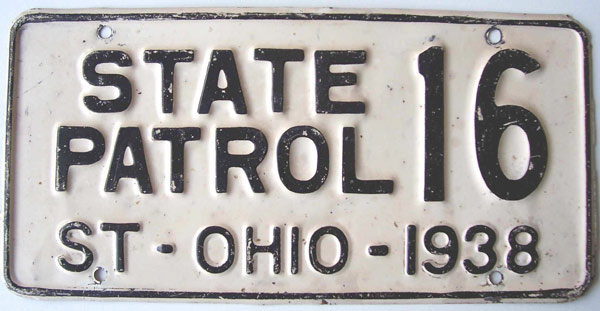 1938 issue. Embossed steel
1938 issue. Embossed steel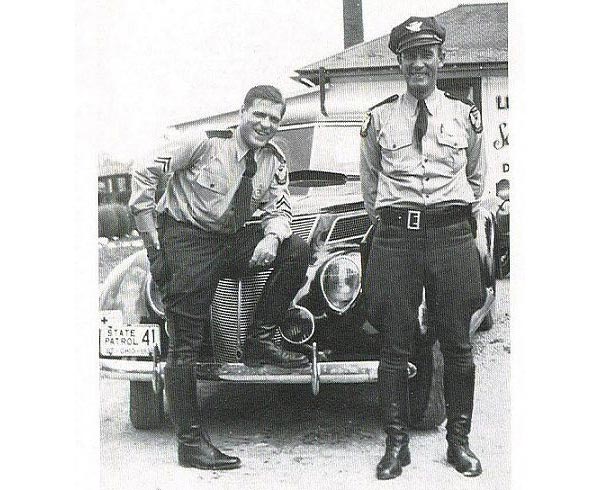 Enjoying the job...
Enjoying the job... 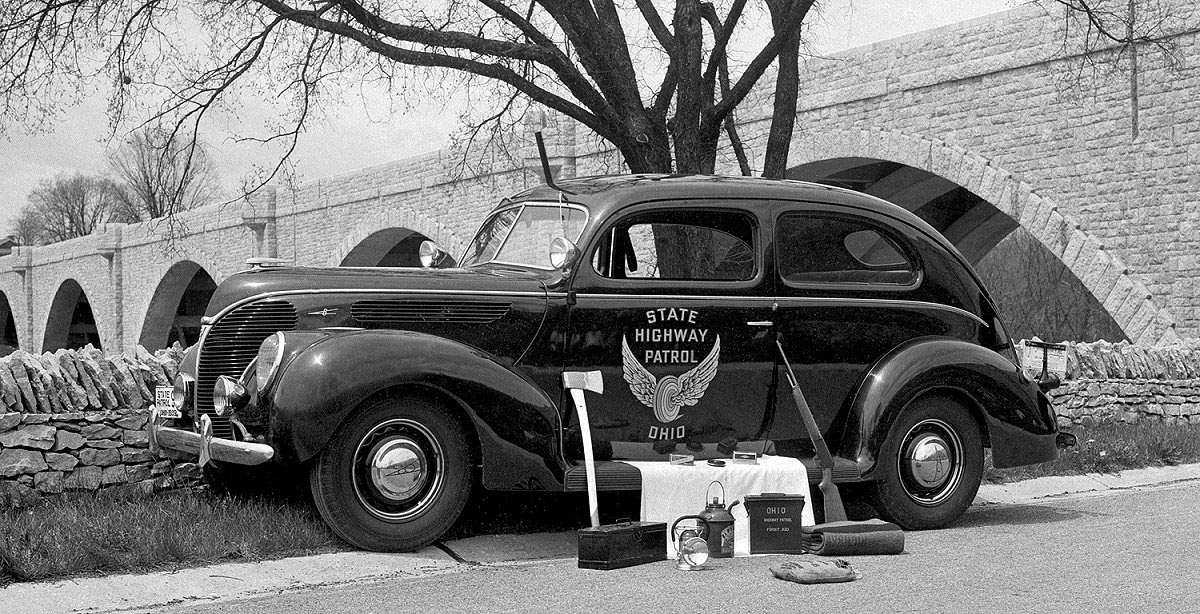
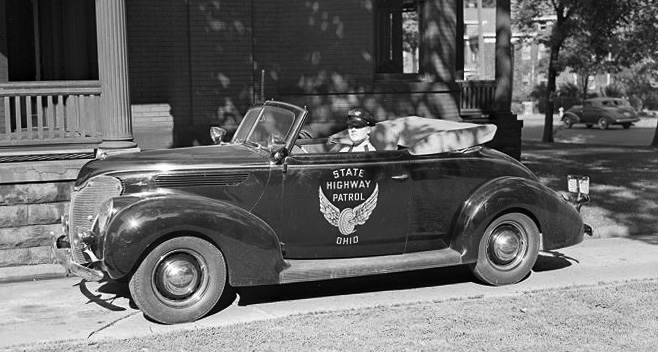
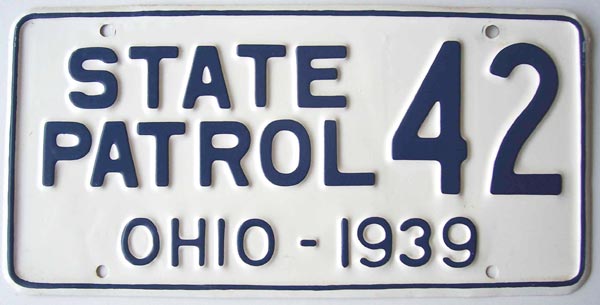 1939 issue. Embossed steel
1939 issue. Embossed steel
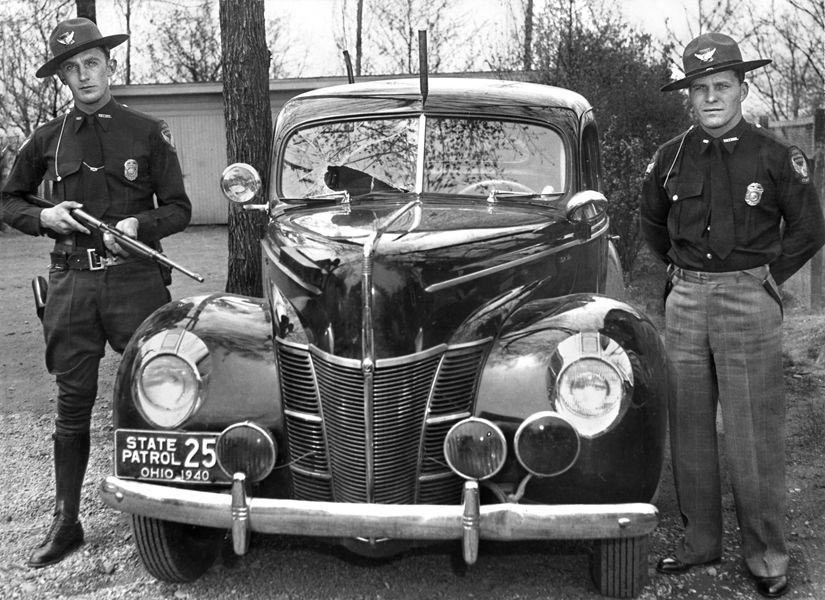
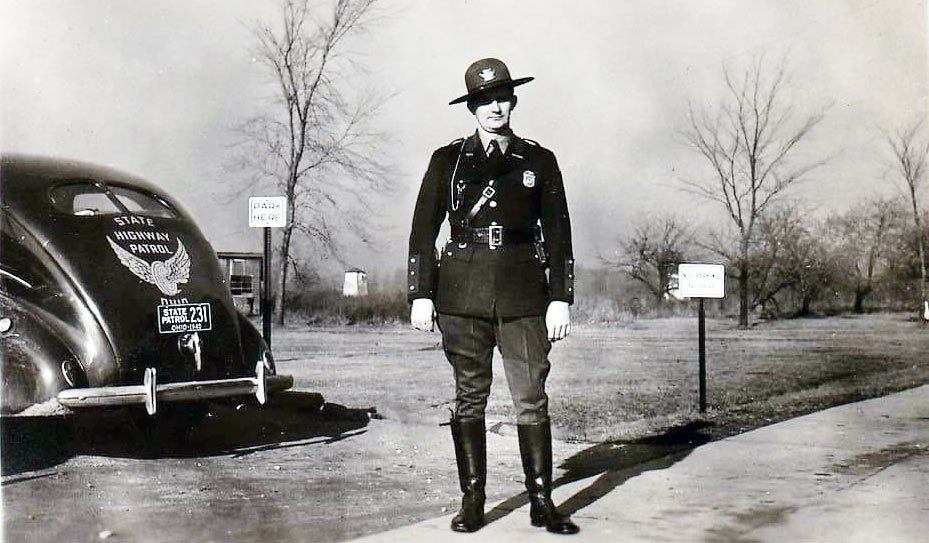
 1941 issue. Embossed steel
1941 issue. Embossed steel
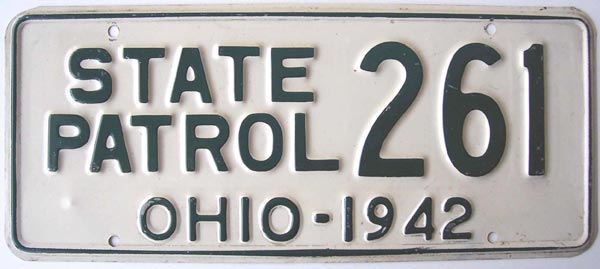 1942-1944 issue. Embossed steel
1942-1944 issue. Embossed steel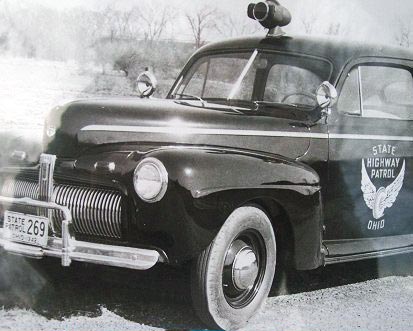
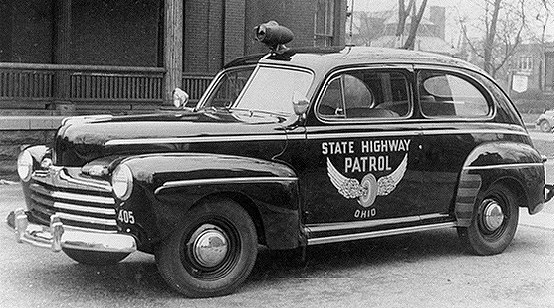 1946 Ford. NO LICENSE PLATES. Car number (405) painted onto car.
1946 Ford. NO LICENSE PLATES. Car number (405) painted onto car.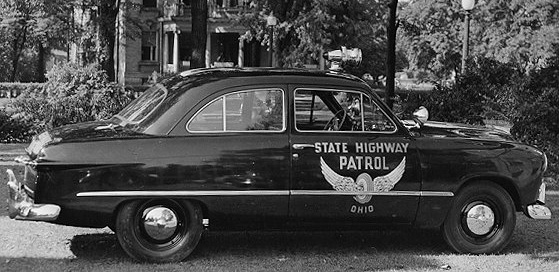 1949 Ford. NO LICENSE PLATES. Car number painted onto car.
1949 Ford. NO LICENSE PLATES. Car number painted onto car.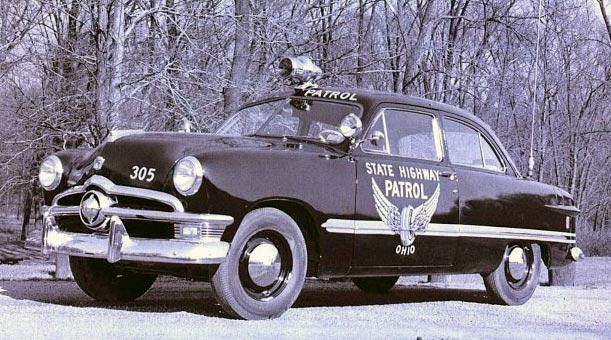 1950 Ford. NO LICENSE PLATES. Car number (305) painted onto car.
1950 Ford. NO LICENSE PLATES. Car number (305) painted onto car.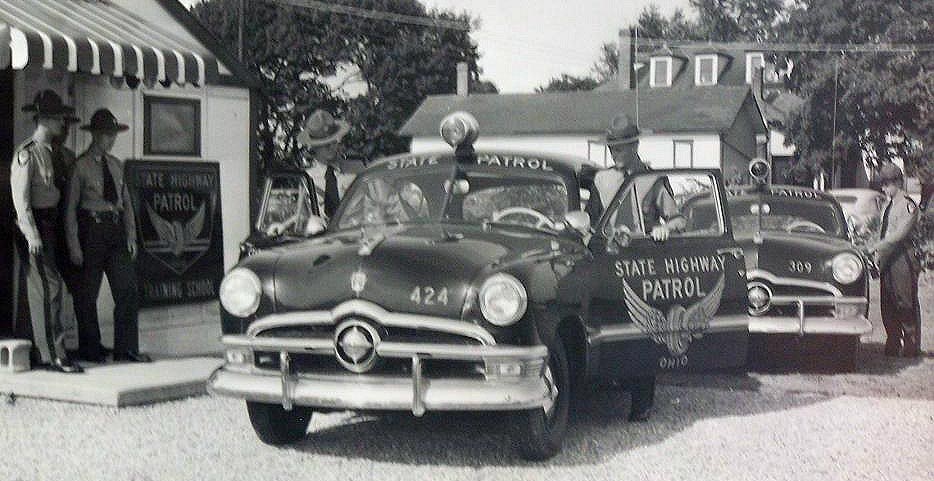 OSHP recruits at the test track (1950).
OSHP recruits at the test track (1950). 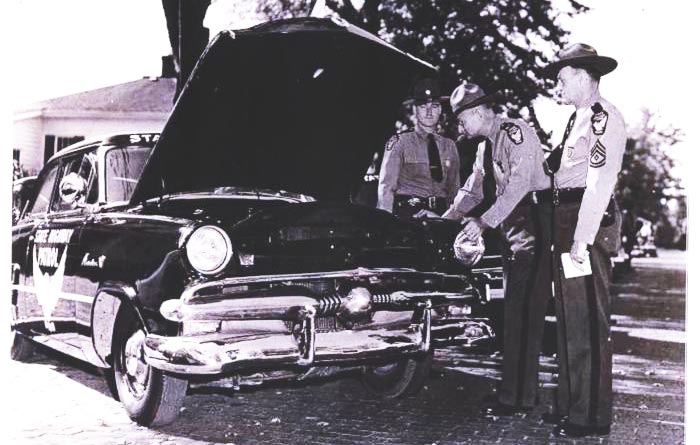 Inspection 1954. NO LICENSE PLATES ISSUED OR USED
Inspection 1954. NO LICENSE PLATES ISSUED OR USED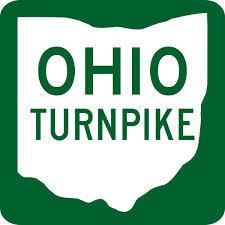 The postwar boom in the late 1940's and early 1950's, meant increased enterprise in Ohio. Farmers and manufacturers needed a fast and dependable way to transport their products to market. Motorists demanded speedier routes to distant cities, shopping centers and recreational sites. Existing roadways were choked with traffic. A dramatic solution was needed.
The postwar boom in the late 1940's and early 1950's, meant increased enterprise in Ohio. Farmers and manufacturers needed a fast and dependable way to transport their products to market. Motorists demanded speedier routes to distant cities, shopping centers and recreational sites. Existing roadways were choked with traffic. A dramatic solution was needed.
Ohio’s leaders envisioned a nonstop superhighway across the state, superior to anything that had ever been built. In 1949, the legislature authorized creation of the Ohio Turnpike Commission. To fund the new superhighway, the Commission issued $326 million in revenue bonds. The Turnpike would be the biggest construction project in Ohio’s history at that time.
Ground was broken on October 27, 1952. At peak construction, 10,000 workers were on the job using more than 2,300 bulldozers, graders, loaders and other road building equipment. Building the 241-mile highway took only 38 months.
On October 1, 1955, the massive project was completed. Opening Day traffic totaled 44,000 vehicles. The Ohio Turnpike was in business. In 1956, the first full year of operation, some 10 million cars and trucks used the Turnpike. In 2012, that number had climbed to more than 49.8 million vehicles.
In June of 1955, the Ohio Turnpike Commission was given assent to contract patrolmen to police the new highway. In July of that year, the state legislature authorized the increase from 650 to 700 OSHP officers to handle the needs of the new Turnpike. With this, a dedicated segment of the Ohio State Highway Patrol were paid, equipped and deployed by the OTC solely for traffic enforcement and assistance for this highway and known as District 10 with three posts: Hiram, Castalia and Swanton. Their patrol vehicles were painted green and sported the livery OHIO TURNPIKE PATROL with an arguably crude rendition of the OSHP "winged wheel" emblem at the base of the front door of the patrol cars.
Unlike their "non-Turnpike" OSHP counterparts, Ohio Turnpike Patrol cars displayed Turnpike prefixed license plates. The plates were in the same color scheme as regular "civilian" license plates that were issued annually at that time but had the prefix TP. Patrol vehicles had a number issued in the TP 2000 series, while Turnpike Administration used plates in the TP 1000 series.
The first year of issue for OSHP Turnpike license plates was 1956 and there is little information about OSHP "Turnpike Patrol" cars after 1961, but it is believed that from that point on, regular OSHP patrol cars were used rather than having the added expense of distinctively different patrol vehicles.
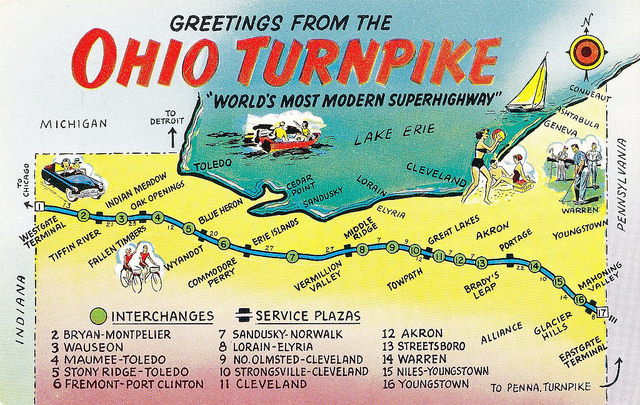
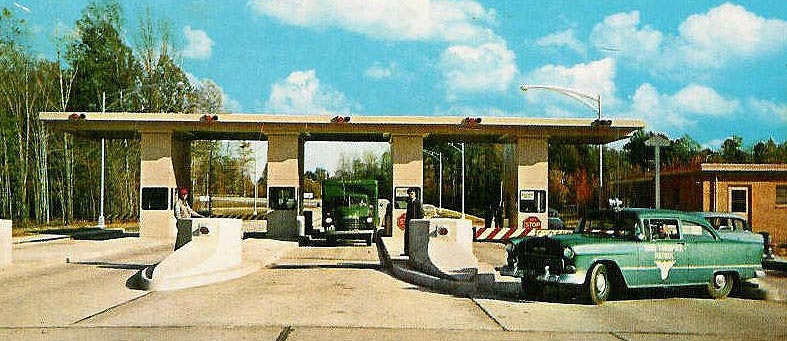
 Brand new OSHP Chevrolet Turnpike Patrol cars (1956) with TP 2000 series license plates.
Brand new OSHP Chevrolet Turnpike Patrol cars (1956) with TP 2000 series license plates.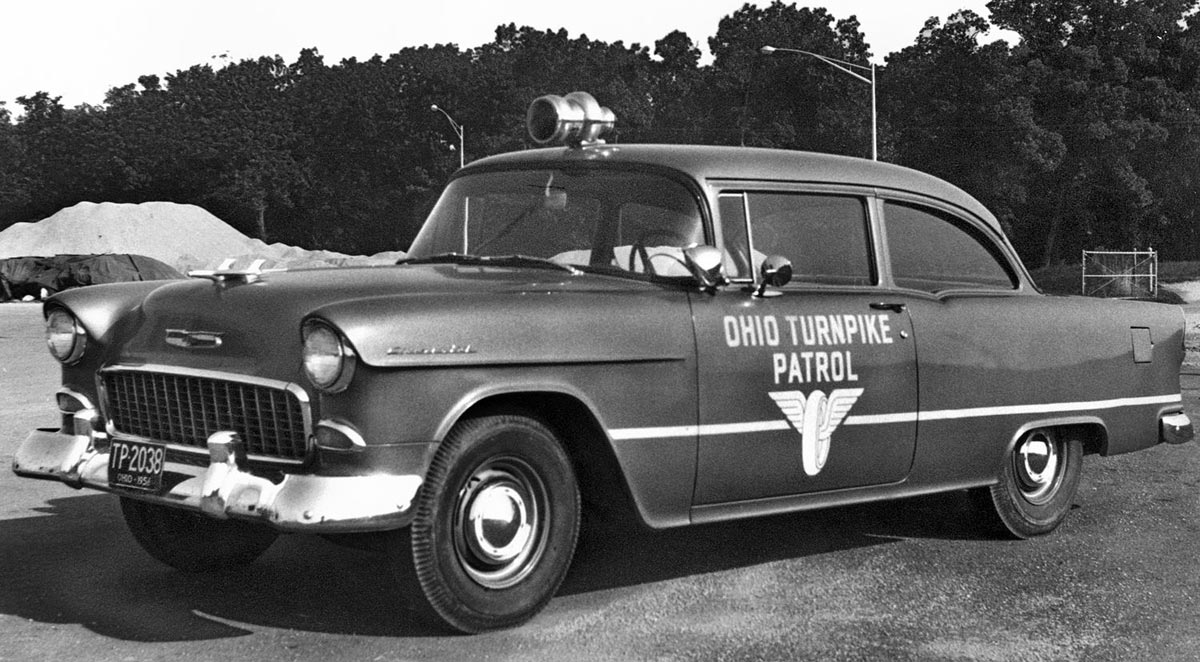 Ohio Turnpike Patrol car- 1956. TP 2000 series license plate in white over dark green
Ohio Turnpike Patrol car- 1956. TP 2000 series license plate in white over dark green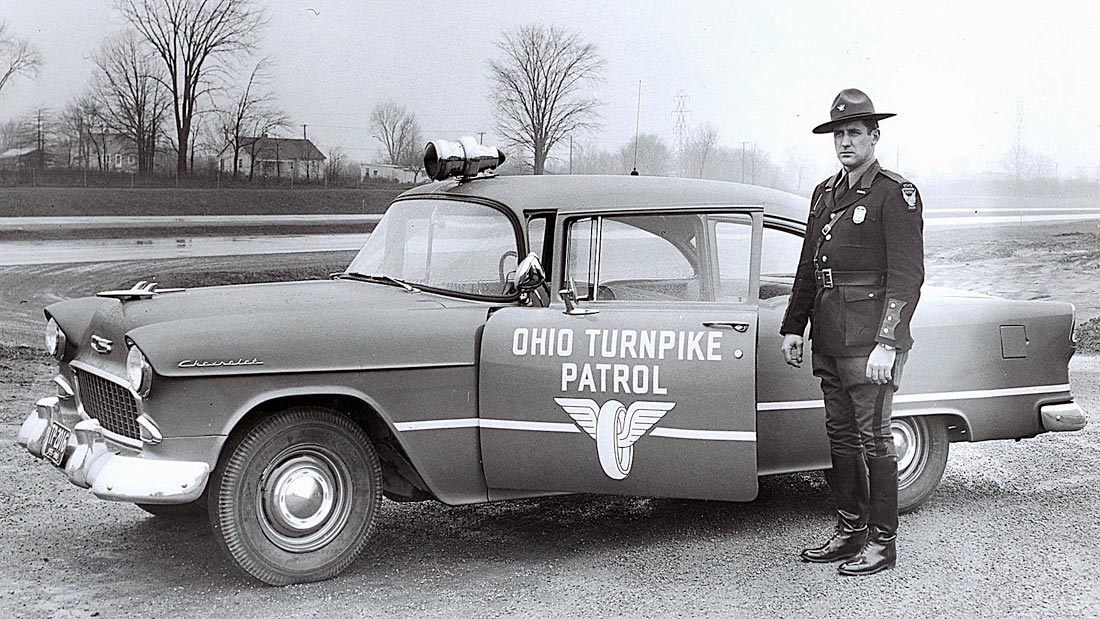 Ohio Turnpike Patrol car- 1956. TP 2000 series license plate in white over dark green
Ohio Turnpike Patrol car- 1956. TP 2000 series license plate in white over dark green Ohio Turnpike Patrol car- 1956. TP 2000 series license plate in white over dark green
Ohio Turnpike Patrol car- 1956. TP 2000 series license plate in white over dark green Ohio Turnpike Patrol car- 1957. TP 2000 series license plate in white over maroon.
Ohio Turnpike Patrol car- 1957. TP 2000 series license plate in white over maroon.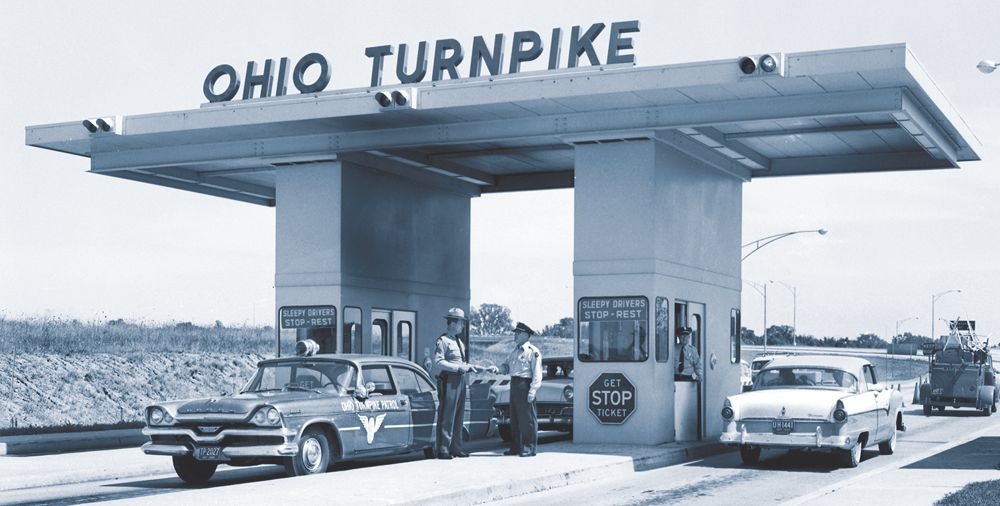 1957
1957 Keys to the new fleet 1957
Keys to the new fleet 1957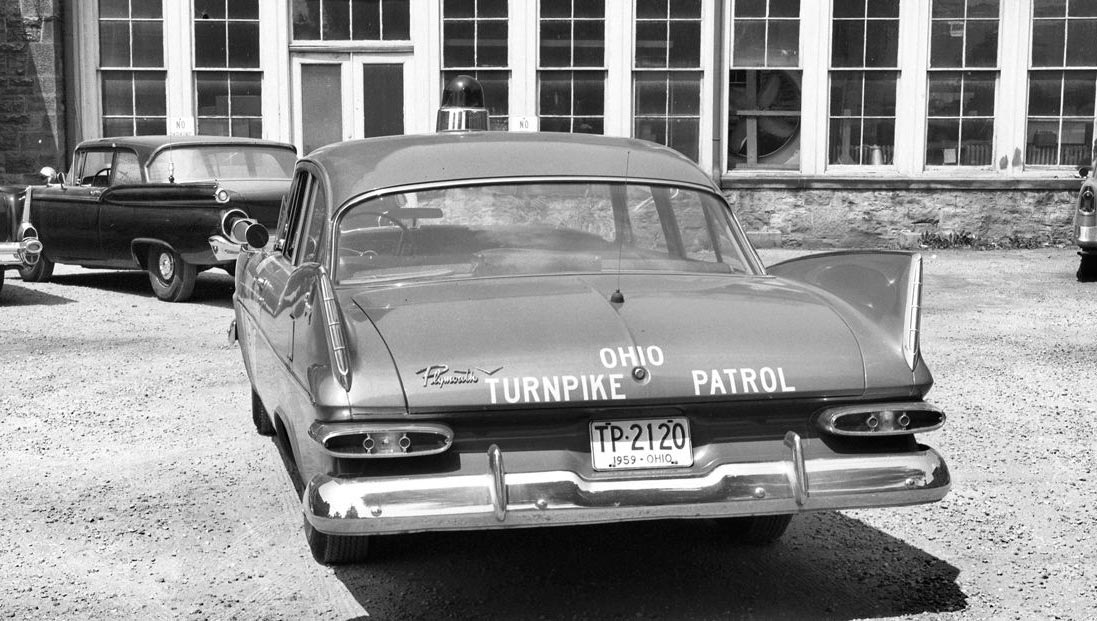 Ohio Turnpike Patrol car- 1959. TP 2000 series license plate in red over white
Ohio Turnpike Patrol car- 1959. TP 2000 series license plate in red over white 1960 Ohio Turnpike Patrol issue. Embossed steel.
1960 Ohio Turnpike Patrol issue. Embossed steel.
In 1958, the Ohio State Highway Patrol celebrated the milestone of their 25th Anniversary. As one commemoration of this occasion, the Patrol commissioned special license plates to be run of the front and rear of all their marked patrol vehicles.
The plates were made of navy blue steel with and embossed border. The inside of the border was occupied by a large reflective white decal with the inscription "1933 1958 Ohio Highway Patrol 25th Silver Anniversary- A QUARTER CENTURY OF SERVICE". Most of the inscription done inside a blue ribbon motif. Although it's been said that these plates were run front and rear on OSHP cars in 1958, the only period photos seen as of this date show the plate on the front of the vehicle.
The patrol car number is sometimes etched onto the backside of these plates, but this may have been more of an anomaly than common practice.
When the 25th Anniversary was over by early 1959, the plates were usually retained by the assigned patrolman as a souvenir.
There would be no other OSHP license plates issued for the next two decades.
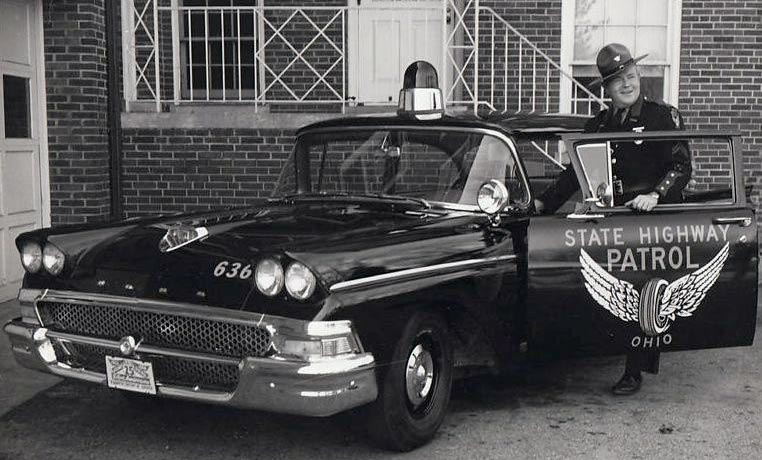
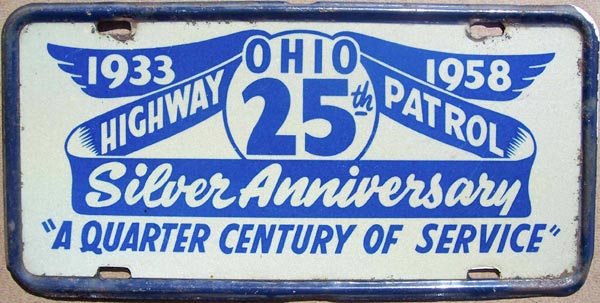 1958 Silver Anniversary issue.
1958 Silver Anniversary issue. 

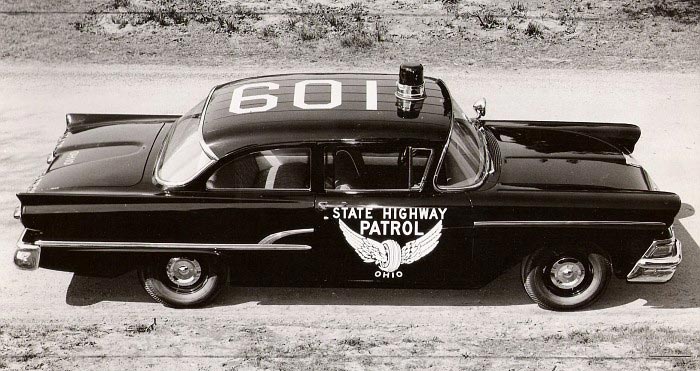 1958 Ford. NO LICENSE PLATES. Car number painted onto car.
1958 Ford. NO LICENSE PLATES. Car number painted onto car. NO LICENSE PLATES. Car number painted onto car.
NO LICENSE PLATES. Car number painted onto car.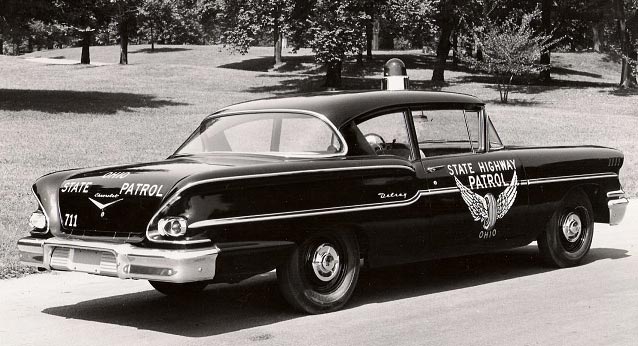 1958 Chevrolet. NO LICENSE PLATES. Car number painted onto car.
1958 Chevrolet. NO LICENSE PLATES. Car number painted onto car.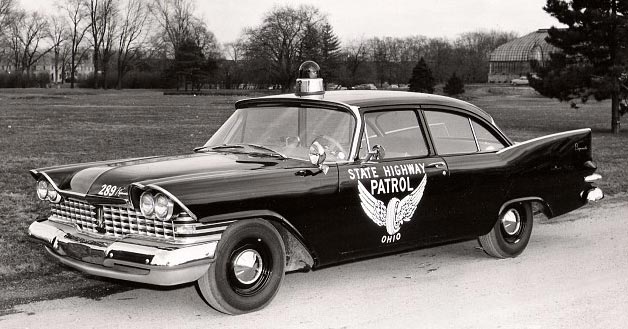 1959 Plymouth. NO LICENSE PLATES. Car number painted onto car.
1959 Plymouth. NO LICENSE PLATES. Car number painted onto car.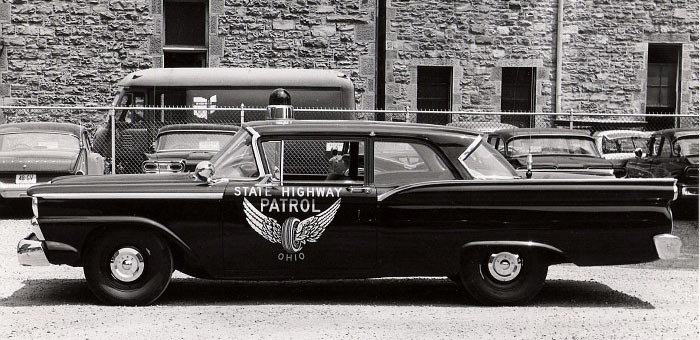 1959 Ford. NO LICENSE PLATES. Car number painted onto car.
1959 Ford. NO LICENSE PLATES. Car number painted onto car.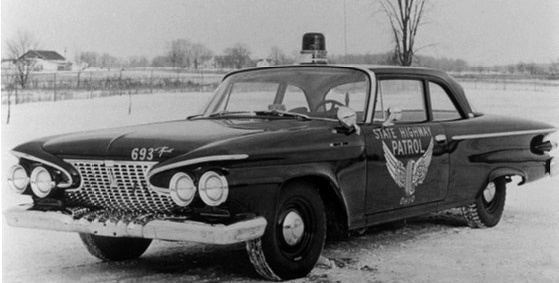 1961 Plymouth. NO LICENSE PLATES. Car number had reflective decals affixed onto car.
1961 Plymouth. NO LICENSE PLATES. Car number had reflective decals affixed onto car.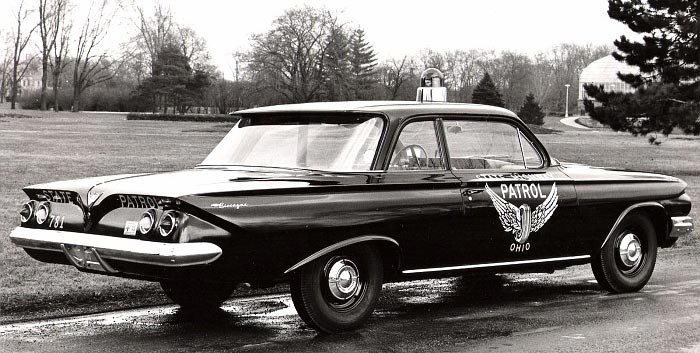 1961 Chevrolet. NO LICENSE PLATES. Car number had reflective decals affixed onto car.
1961 Chevrolet. NO LICENSE PLATES. Car number had reflective decals affixed onto car.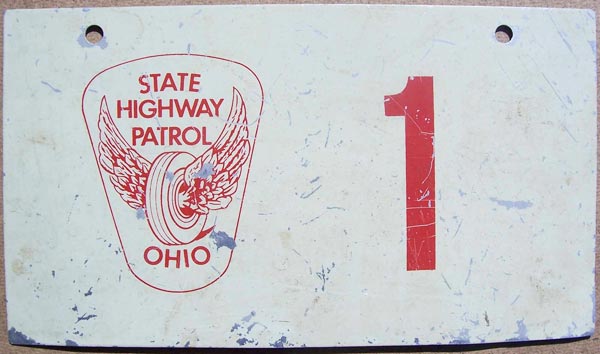 Thinly painted aluminum plate.
Thinly painted aluminum plate.
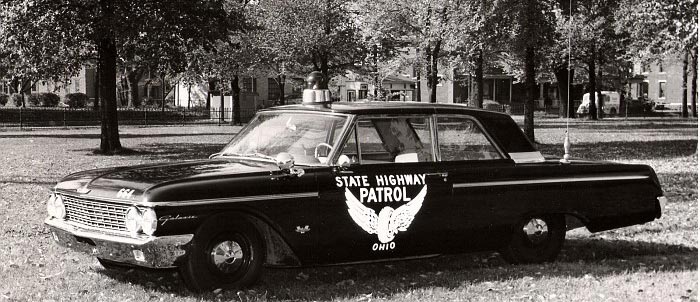 1962 Ford. NO LICENSE PLATES. Car number had reflective decals affixed onto car.
1962 Ford. NO LICENSE PLATES. Car number had reflective decals affixed onto car. 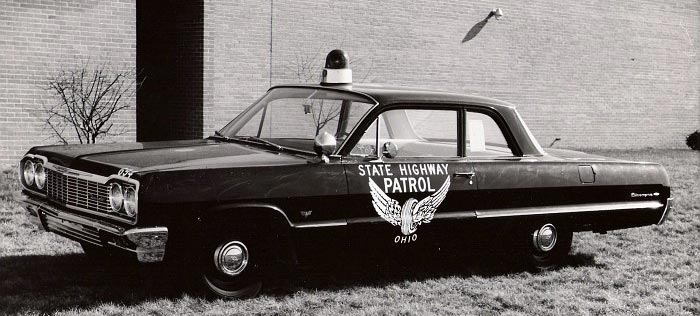 1964 Chevrolet. NO LICENSE PLATES. Car number had reflective decals affixed onto car.
1964 Chevrolet. NO LICENSE PLATES. Car number had reflective decals affixed onto car.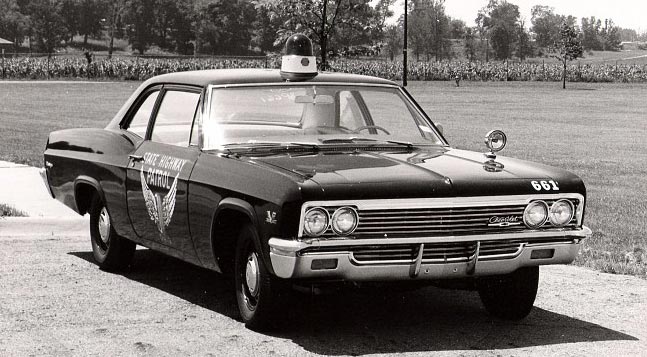 1966 Chevrolet. NO LICENSE PLATES. Car number had reflective decals affixed onto car.
1966 Chevrolet. NO LICENSE PLATES. Car number had reflective decals affixed onto car.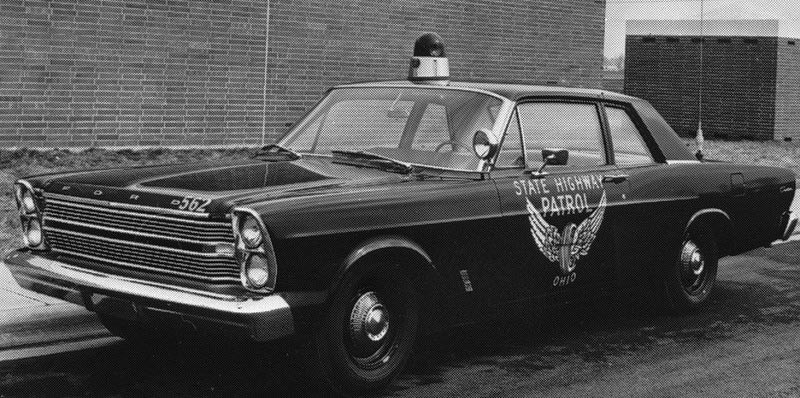 1966 Ford. NO LICENSE PLATES. Car number had reflective decals affixed onto car.
1966 Ford. NO LICENSE PLATES. Car number had reflective decals affixed onto car.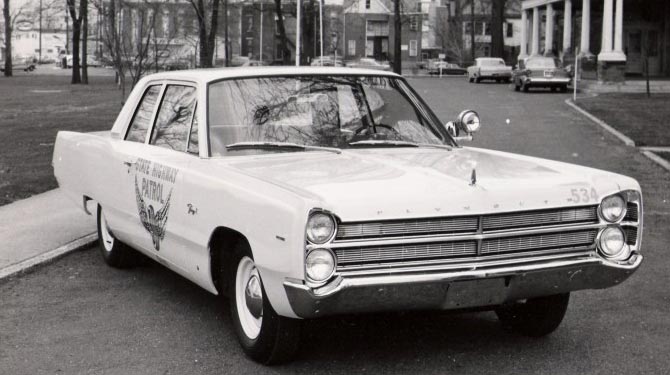 1967 Plymouth. NO LICENSE PLATES. Car number had reflective decals affixed onto car.
1967 Plymouth. NO LICENSE PLATES. Car number had reflective decals affixed onto car.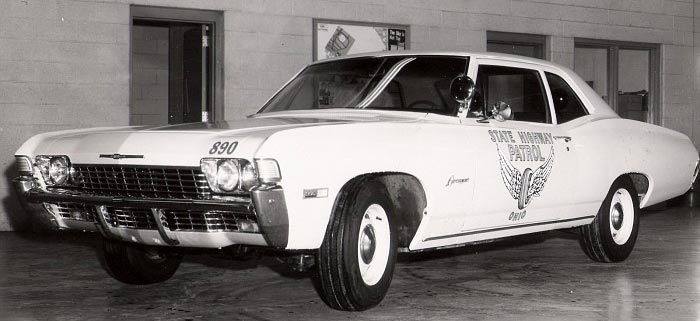 1968 Chevrolet. NO LICENSE PLATES. Car number had reflective decals affixed onto car.
1968 Chevrolet. NO LICENSE PLATES. Car number had reflective decals affixed onto car.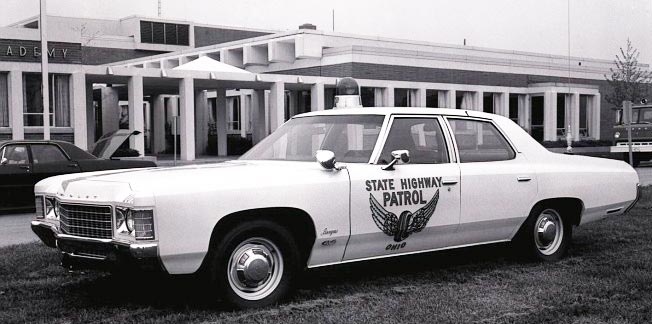 1971 Chevrolet. NO LICENSE PLATES. Car number had reflective decals affixed onto car.
1971 Chevrolet. NO LICENSE PLATES. Car number had reflective decals affixed onto car.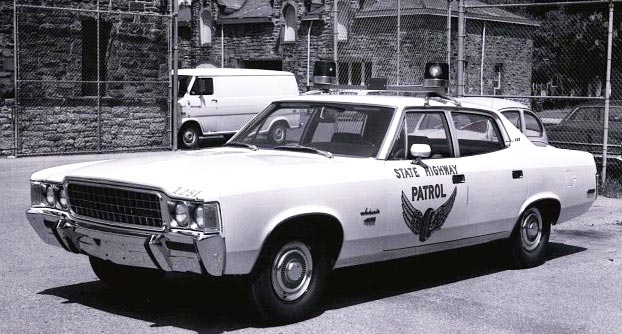 1972 AMC Ambassador. NO LICENSE PLATES. Car number had reflective decals affixed onto car.
1972 AMC Ambassador. NO LICENSE PLATES. Car number had reflective decals affixed onto car.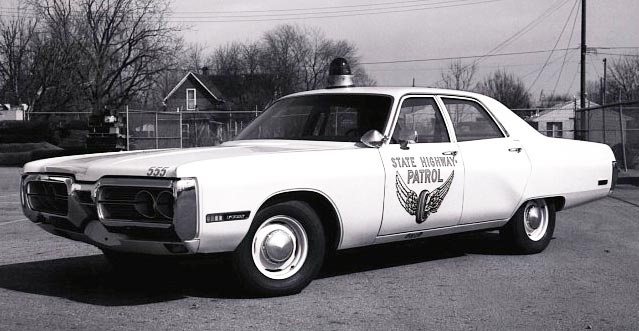 1972 Plymouth. NO LICENSE PLATES. Car number had reflective decals affixed onto car.
1972 Plymouth. NO LICENSE PLATES. Car number had reflective decals affixed onto car.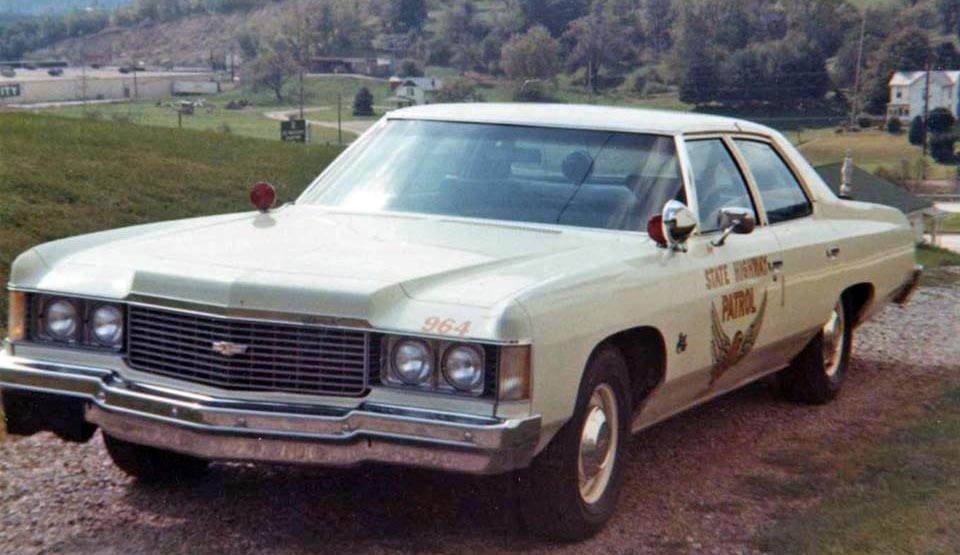 1973 Chevrolet slicktop. NO LICENSE PLATES. Car number had reflective decals affixed onto car.
1973 Chevrolet slicktop. NO LICENSE PLATES. Car number had reflective decals affixed onto car.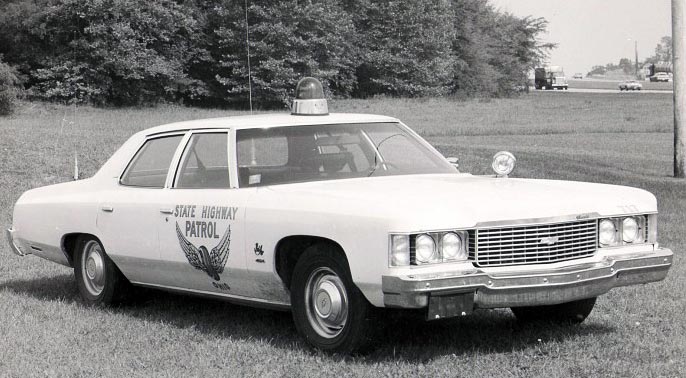 1974 Chevrolet. NO LICENSE PLATES. Car number had reflective decals affixed onto car.
1974 Chevrolet. NO LICENSE PLATES. Car number had reflective decals affixed onto car.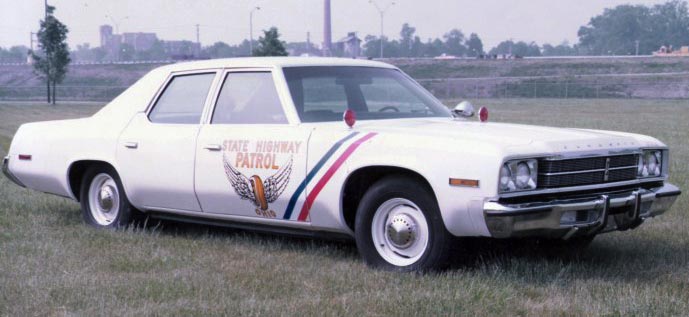 1975 Plymouth with US Bicentennial stripes. NO LICENSE PLATES. Car number had reflective decals affixed onto car.
1975 Plymouth with US Bicentennial stripes. NO LICENSE PLATES. Car number had reflective decals affixed onto car.In January of 1977, the Ohio State Highway Patrol launched a special project license plate for all of its marked fleet. The plate was a standard Ohio passenger car base plate which was made of embossed aluminum and painted red over reflective white. The state name OHIO was embossed in small font at the bottom center of the plate and the center field of the plate had the embossed characters CB CH9.
The 1970's saw a surge in popularity of Citizen's Band or CB radios. Everyone from truckers to courier drivers to teenagers at home were using this form of instant communication through the airwaves. CB Channel 9 was monitored by the OSHP, so Colonel Reiss saw the value of advising the motoring public in Ohio that any calls for service could be broadcast to and received by the OSHP on Channel 9.
These special plates were run only on the rear of marked OSHP cars until November of 1982 when the plates were ordered removed and returned to headquarters in Columbus.
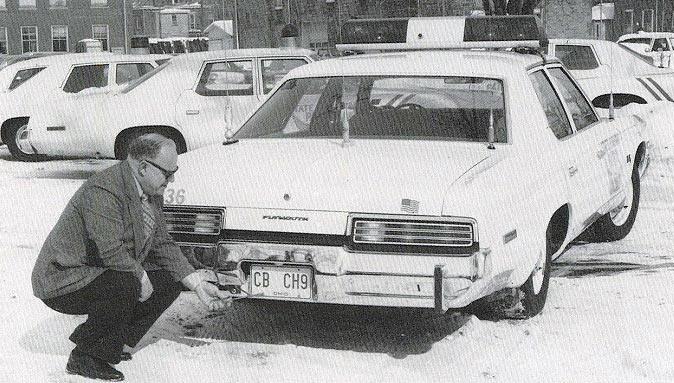 Colonel Adam Reiss attaches the first CB Channel 9 license plate to a marked OSHP cruiser in January of 1977. This advised motorists in the Buckeye State that the OSHP monitored Citizen's Band Radio channel 9 for any calls for service.
Colonel Adam Reiss attaches the first CB Channel 9 license plate to a marked OSHP cruiser in January of 1977. This advised motorists in the Buckeye State that the OSHP monitored Citizen's Band Radio channel 9 for any calls for service. 1977-1982 issue.
1977-1982 issue. 
 (Courtesy Ohio State Highway Patrol)
(Courtesy Ohio State Highway Patrol)
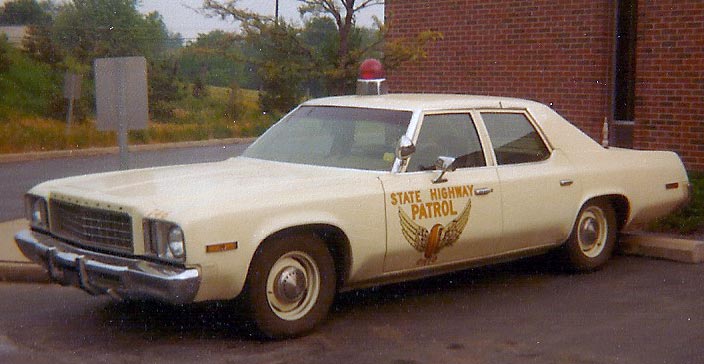
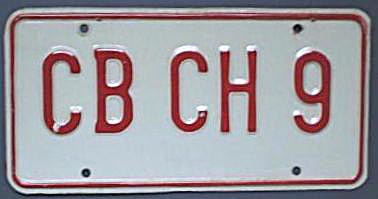 1977-1982 issue. Possible error.
1977-1982 issue. Possible error.
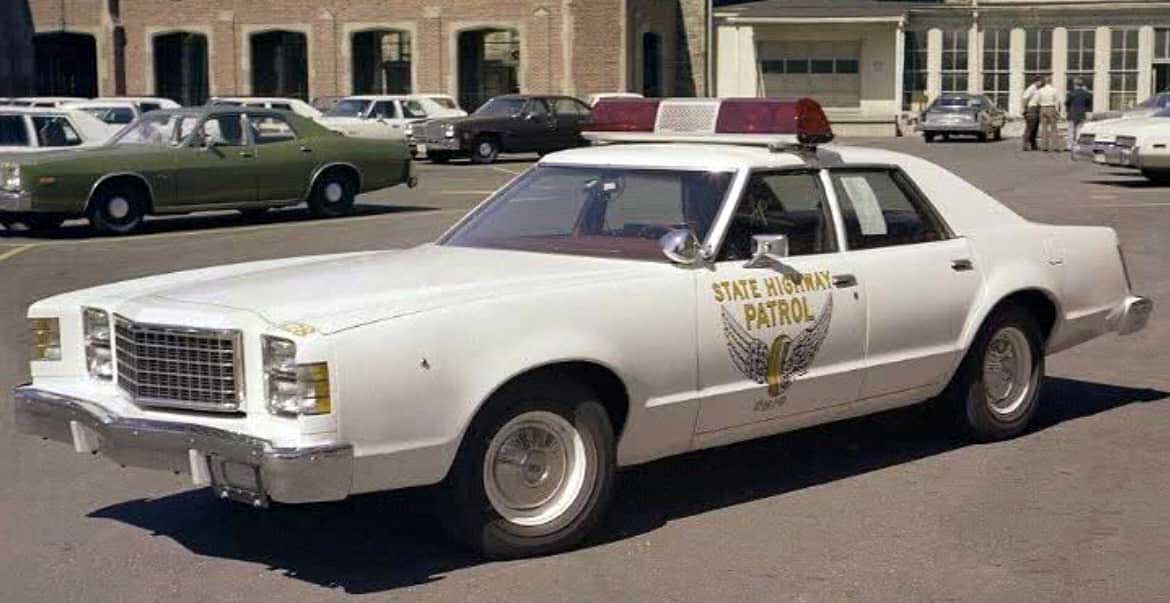
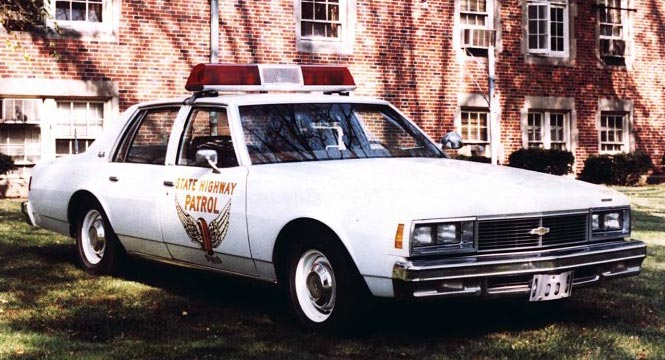
In November of 1982, the Ohio State Highway Patrol was gearing-up for its 50th Anniversary the following year. As part of that milestone commemoration, the agency unveiled a Golden Anniversary license plate to be run on all of the marked OSHP fleet, which by this time had transitioned from an all-white colored fleet to silver.
The new plate was made of flat highway sign grade aluminum and had a solid reflective gold background with black silkscreened characters. The center of the plate featured the emblem of the OSHP over an outline of the state. A circular motif with GOLDEN at the top and ANNIVERSARY at the bottom was flanked by laurels to complete the circle. 1933 occupied the center left part of the plate and 1983 the center right.
The plates were issued as one per car and to be mounted on the rear only much like the previous CB CH9 plate. By early 1983, a teletype message went out to all OSHP personnel that they could purchase a package of two OSHP Golden Anniversary license plates for $5.00 per package. Singles were sold for $3.50 and later $2.50 each.
These plates were run until January 1 1984 when a teleptype order directed that all OSHP Golden Anniversary license plates were to be removed and retained at the respective Posts until further notice.
On the morning of January 4th 1984, a new teletype directive was sent out to all Posts directing that each Trooper was to be given one of the Golden Anniversary license plates as a souvenir.
The previous CB CH9 plates that had been sent back to Columbus were to be re-issued after the 50th Anniversary.
 50th Anniversary issue.
50th Anniversary issue.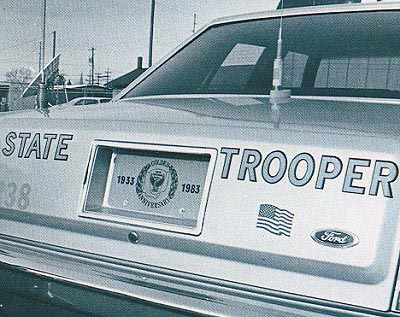
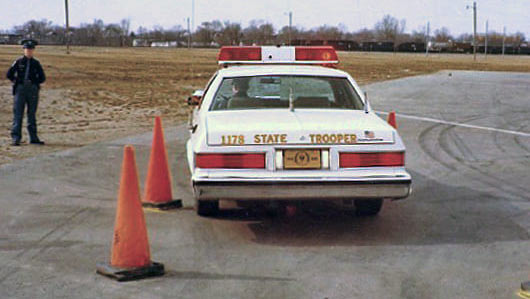 (Courtesy Willie Brown)
(Courtesy Willie Brown)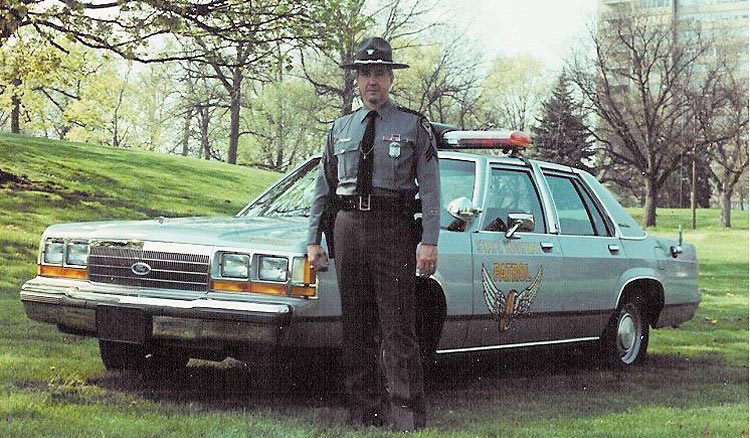
When the order was given to remove all the Golden Anniversary license plates, it was then directed that all the 1977-1982 CB CH9 plates that were stored in Columbus for the past year were to be redistributed to the Posts to be re-affixed to the marked patrol vehicles. While this worked for some plates that were in good condition, others were too worn to look proper on what was in some cases, to be mounted on brand new patrol cars.
The second issue CB CH9 license plate was made and distributed from 1984 until the early 1990's. The plate was similar to the 1977 first issue in color and format, but with the only differences being that the new version did not have a red border (step border instead), the state name OHIO was embossed in a larger font, and a rectangular recess for validation decals occupied the lower right and left corner of the plate.
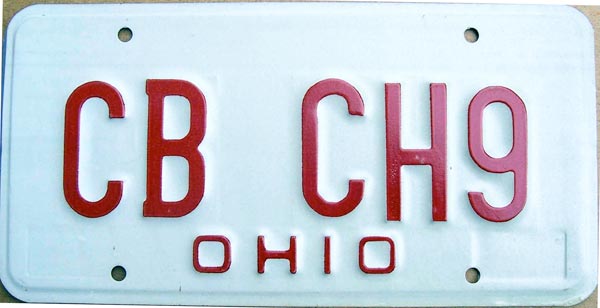 1984-circa 1990 issue.
1984-circa 1990 issue.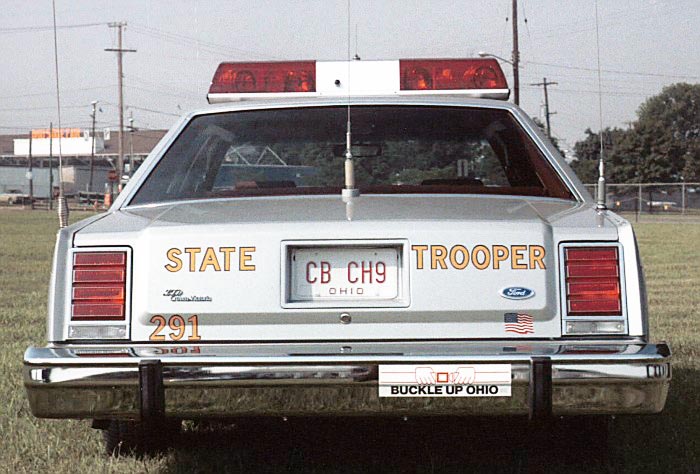 Second issue CB CH9 plate on 1985 Ford
Second issue CB CH9 plate on 1985 Ford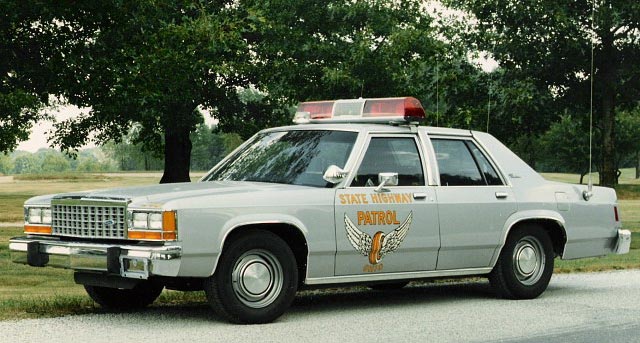
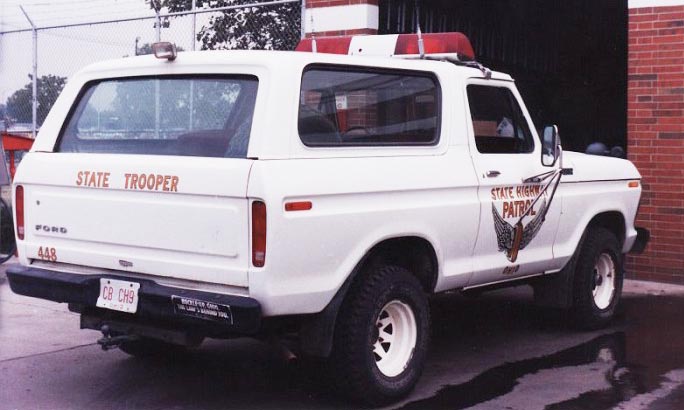
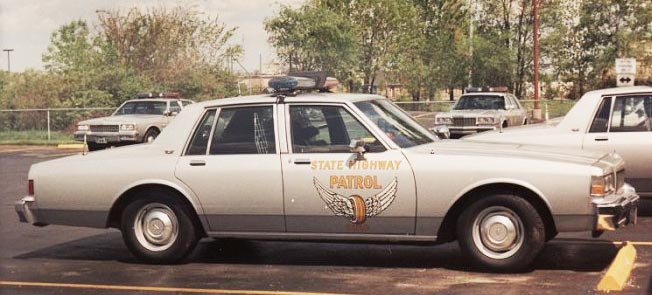
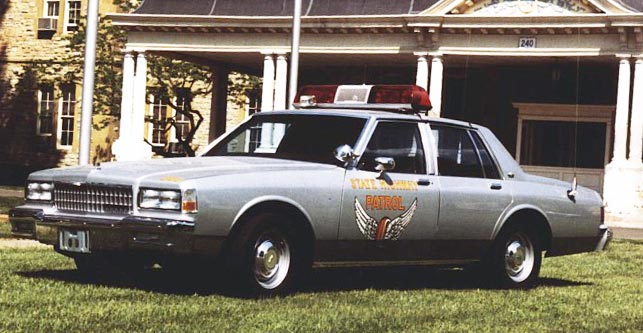
In 1990, the Ohio Bureau of Motor Vehicles introduced a new license plate which had the validation sticker recesses on the bottom corners of the plate incorporated into the border itself. The plate was made of embossed steel. The color scheme once again was red over reflective white. The state name OHIO was embossed in the top center of the plate and CB CH9 was embossed in the center leaving space on the far left and far right side of the plate.
It was during the early 1990's and through the rest of the decade that OSHP ran different variations of this plate where the CB CH9 was positioned differently on the plate and in some cases colored blue over reflective white.
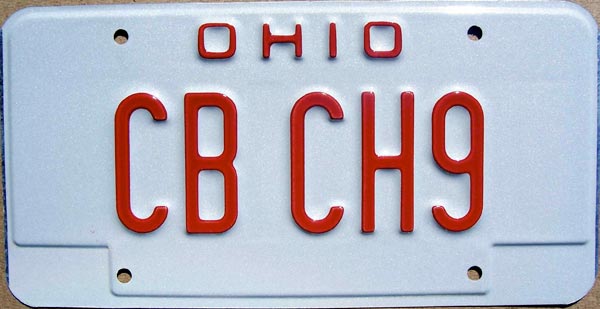 Circa 1993 issue.
Circa 1993 issue. 
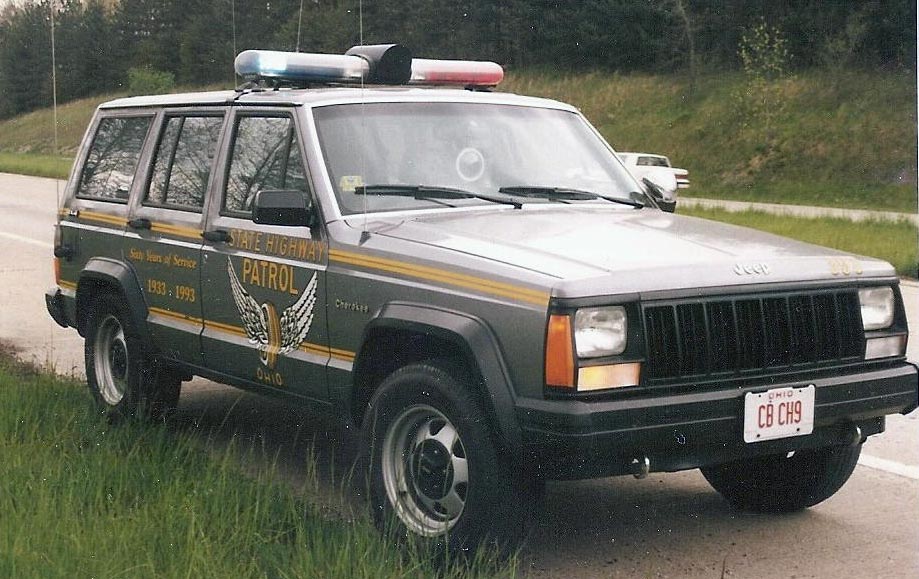
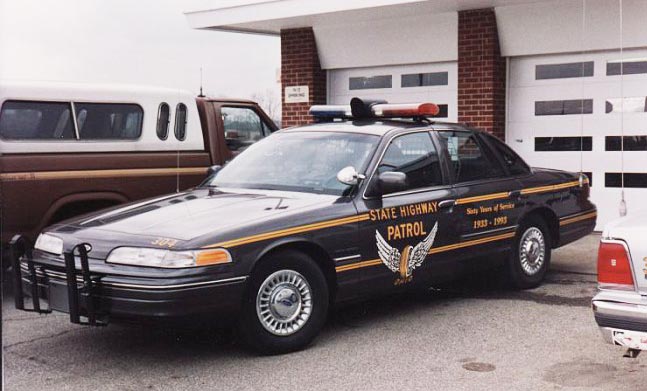
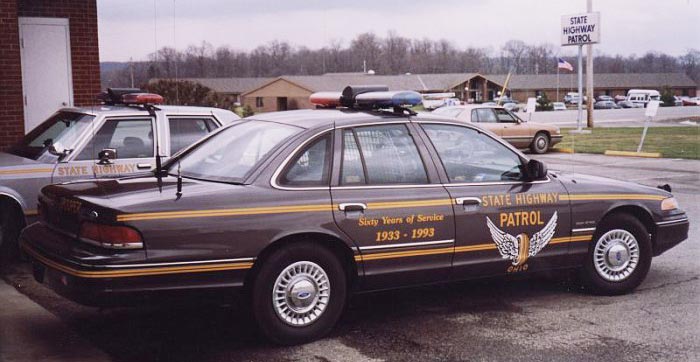
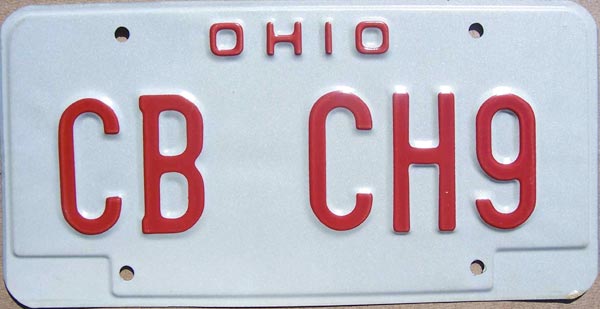 1990's issue.
1990's issue. 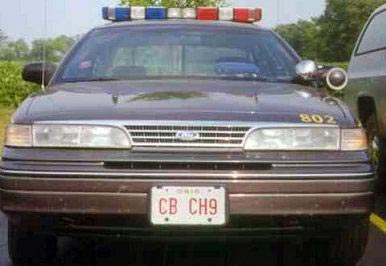
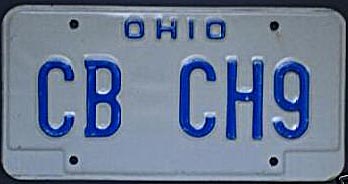 Late 1990's-Early 2000's issue.
Late 1990's-Early 2000's issue. 
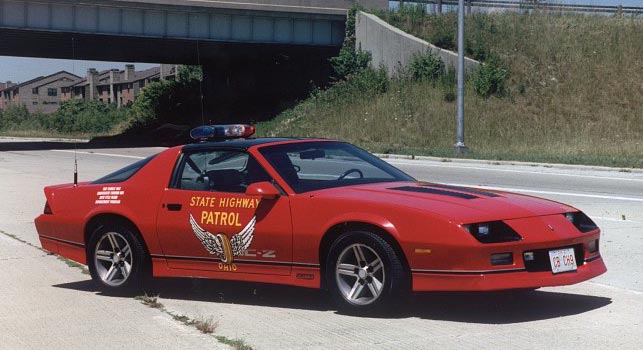
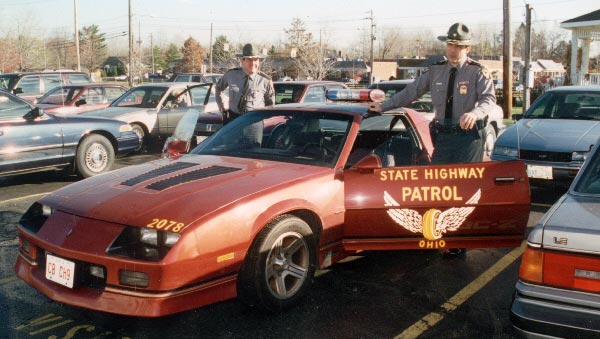 1985 Camaro Z-28: One of 28 cars confiscated in a sting operation late 1980's-Medina Post-
1985 Camaro Z-28: One of 28 cars confiscated in a sting operation late 1980's-Medina Post- 
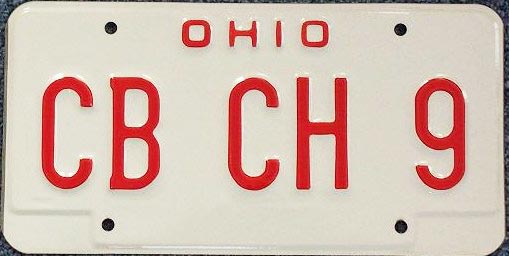 Late 1990's-Early 2000's issue.
Late 1990's-Early 2000's issue. 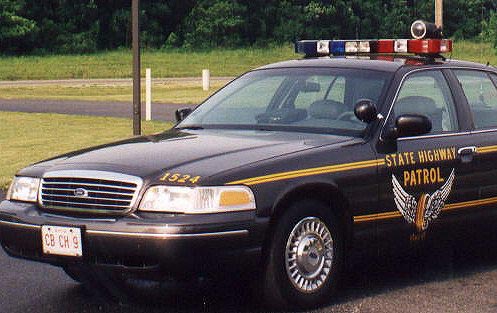
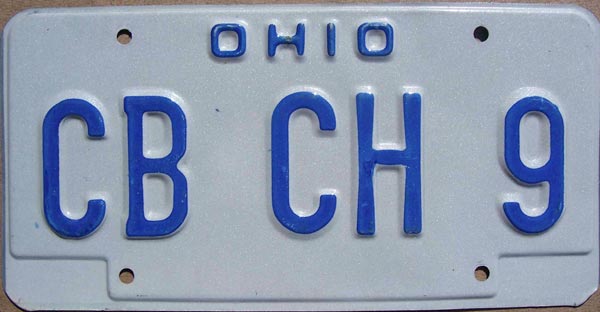 Late 1990's-Early 2000's issue.
Late 1990's-Early 2000's issue.
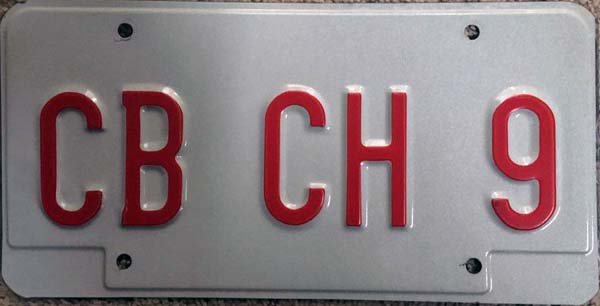 1990's issue.
1990's issue. 
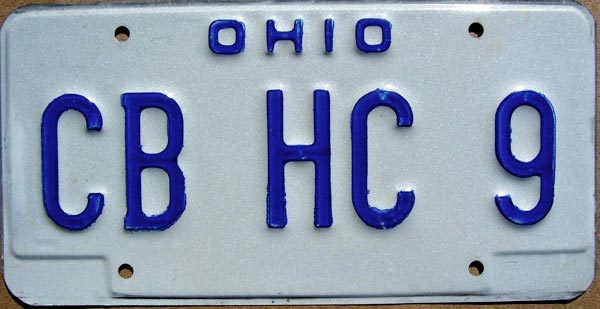 Late 1990's-Early 2000's ERROR.
Late 1990's-Early 2000's ERROR. 
In August of 1991, the Ohio State Highway Patrol with the support of MADD (Mothers Against Drunk Driving) launched the 1-800-GRAB-DUI program. All OSHP marked patrol cars bore these special license plates that directed citizens who observed a potential drunk driving offender to call the toll free number to report the observation.
From August 1 1991 to August 30 2003, over 56,000 calls were placed to the toll free number resulting in 14,435 arrests of habitual offenders (5 or more previous drunk driving charges) according to MADD. This license plate program was eventually extended to county sheriff and municipal police forces throughout Ohio as well.
The plates were made on the new "Heart of it All!" base plate introduced to all Ohio motorists in late 1990. The plate's characters were entirely silkscreened. OHIO was screened in blue at the top center of the plate with a cursive script in red reading "the heart of it all" scrolled below and over the state name. The center of the plate had the toll free telephone number 1-800-GRAB-DUI emblazoned in red across the center of the plate. The bottom center of the plate had REPORT over DRUNK DRIVERS silkscreened in dark blue. There were medium blue rectangles screened in the validation decal recesses in the bottom corners of the plate.
These plates were often run concurrent with the CB CH 9 plates of the era.
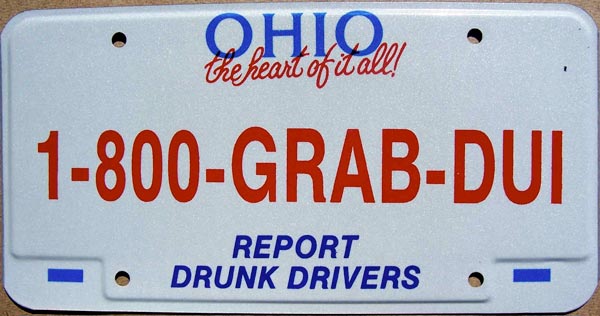 1991-1996 issue.
1991-1996 issue.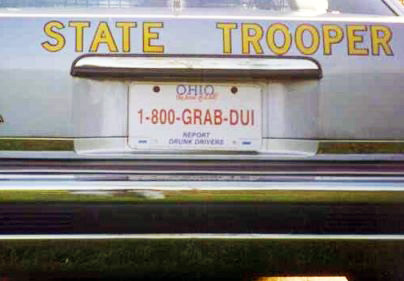
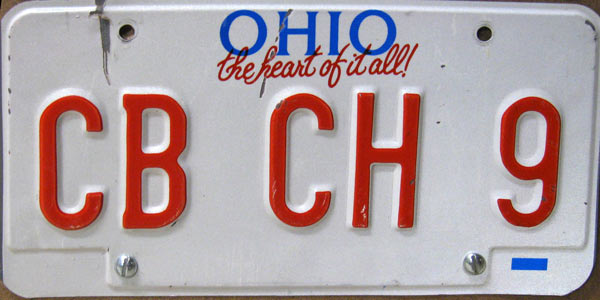 1992-1996 CB CH 9 issue.
1992-1996 CB CH 9 issue.
In 1997, the state of Ohio re-plated for all of the state's motorists. The new plates payed hommage to Ohio's pioneers of aviation, Dayton's Orville and Wilbur Wright by using the slogan BIRTHPLACE OF AVIATION on these new aluminum plates.
This was launched at a time while the 1-800-GRAB-DUI program was still ongoing. The plates had a reflective white background which at the horizontal mid-point, began to fade into a gradient of reflective gold which intensified towards the bottom of the plate. The state name OHIO was silkscreened in dark blue at the top center of the plate. The news slogan BIRTHPLACE OF AVIATION was silkscreened in red below the state name. The center of the plate had the toll free telephone number 1-800-GRAB-DUI emblazoned in red across the center of the plate. The bottom center of the plate had REPORT over DRUNK DRIVERS silkscreened in dark blue. There were dark blue rectangles screened in the validation decal recesses in the bottom corners of the plate.
These plates were often run concurrent with the CB CH 9 plates that were also manufactured on the same base plate.
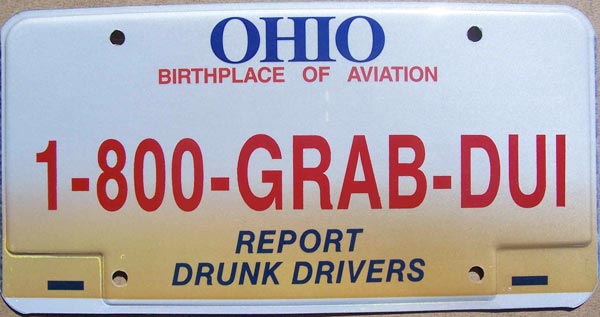 1997-circa 2003.
1997-circa 2003.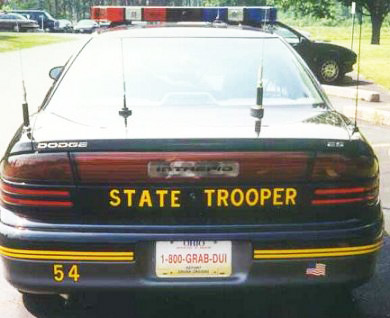
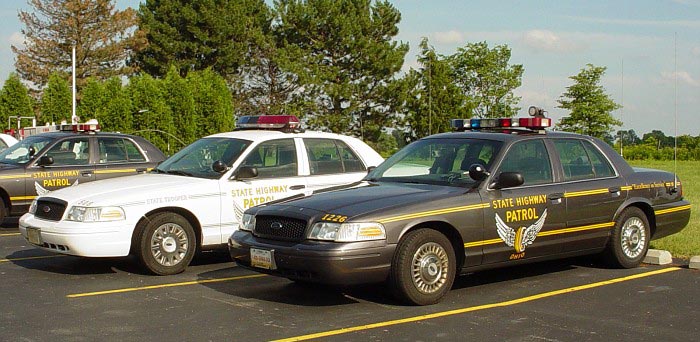
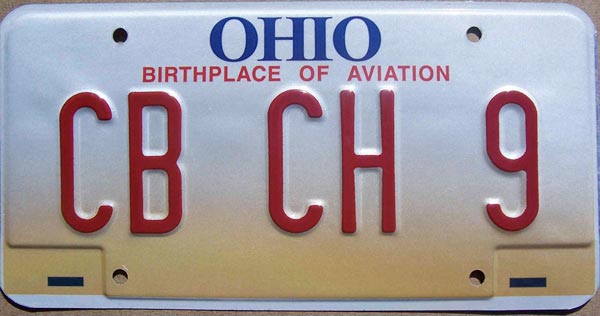 1997-circa 2003 CB CH 9 issue.
1997-circa 2003 CB CH 9 issue.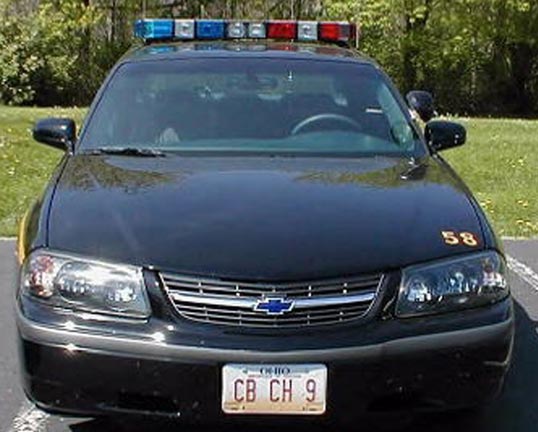
It is not known for 100% certainty, but well-assumed that around 2001, the Ohio State Highway Patrol launched a new license plate to be displayed on all its marked patrol vehicles. The same BIRTHPLACE OF AVIATION base plate was used, however this time, the center field of the plate had the trademark winged-wheel motif of the OSHP silkscreened in grey. The horizontal center span had the words Need Help? which was silkscreened in dark blue over 1-877-7-PATROL in red. These plates were used while the 1-800-GRAB-DUI and CB CH 9 plates continued to be displayed on OSHP vehicles as well.
The usage of this type continued until approximately 2008.
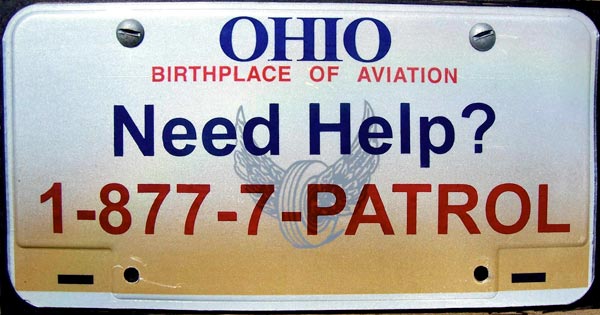 Circa 2001-2008 issue.
Circa 2001-2008 issue.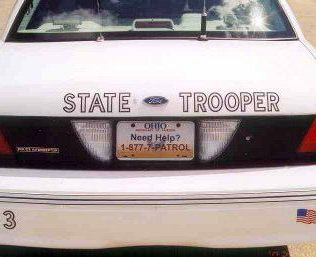

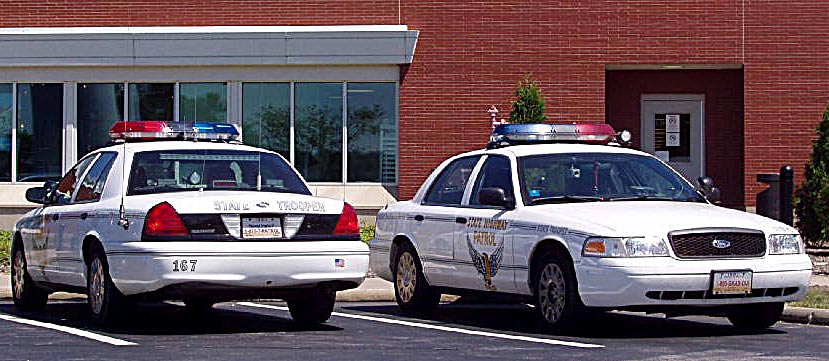
In 2008, the Ohio State Highway Patrol celebrated its Diamond Anniversary. Once again the milestone was marked with an Anniversary issue license plate to mark the occasion. This time the aluminum plate had a reflective white background with a black strip that spanned horizontally across the top of the plate just above and just below the upper mounting holes. In the center of this strip was an elongated oval in gold with the words OHIO STATE HIGHWAY PATROL and an outline in black. Below that, a space followed by a thin horizontal line in gold. The center field of the plate featured a large diamond shaped motif in black and trimmed in gold. The number 75 in gold and trimmed in black occupied the center of the diamond with a small emblem of the OSHP imposed over top. The lower part of the diamond had 1933 to the left and 2008 to the right in gold. A scroll banner in gold with ANNIVERSARY in black spanned the lower segment of the diamond. The gold and black horizontal strip pattern from the top of the plate was reversed for the bottom. The plates were run rear only for the duration of the Anniversary until their removal from service in January of 2009.
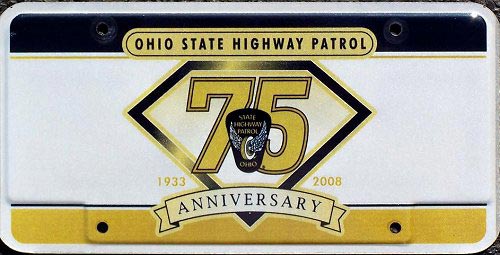 2008-2009 Diamond Anniversary issue.
2008-2009 Diamond Anniversary issue.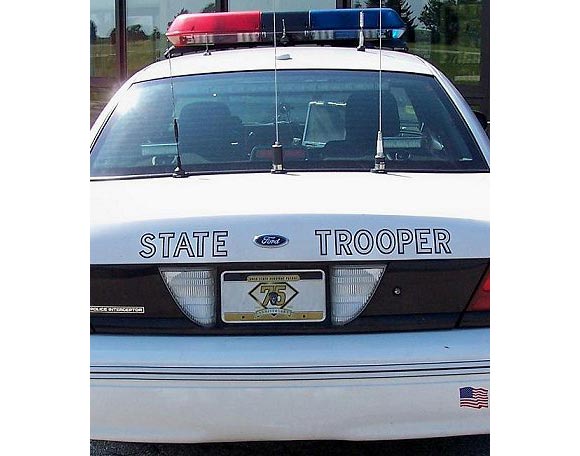
In 2004, the state of Ohio once again re-plated for the Buckeye State's motor vehicles. Once again the aluminum plate featured a reflective white background but with a red strip that spanned horizontally across the top of the plate just above and just below the upper mounting holes. In the center of this strip was a stylized cursive script for the state name Ohio in medium blue and the slogan Birthplace of Aviation once again. Below that, a space followed by a thin horizontal line in blue. The center horizontal span had the 1-800-GRAB-DUI screened in red. The bottom center of the plate had REPORT over DRUNK DRIVERS silkscreened in dark blue. There was one medium blue rectangle screened in the validation decal recess in the bottom right corner of the plate.
It's been stated that some of these 1-800-GRAB-DUI plates also featured the OSHP winged wheel silkscreened in light grey in the center background, but no example has been seen or provided yet. These base plates were also used with the Need Help? 1-877-7-PATROL script and OSHP winged wheel subdued in grey in the center background.
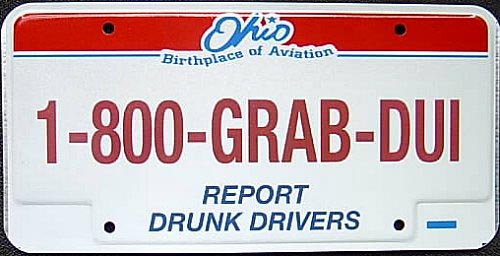 2004-2009 GRAB DUI issue.
2004-2009 GRAB DUI issue.
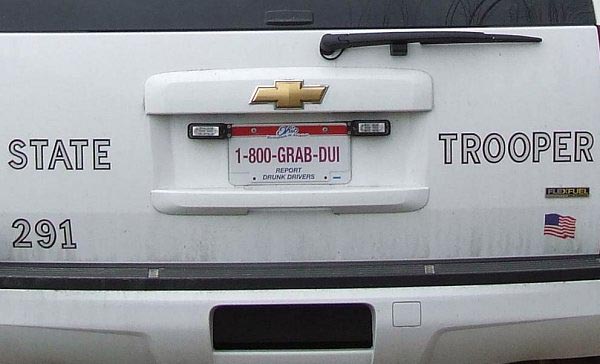
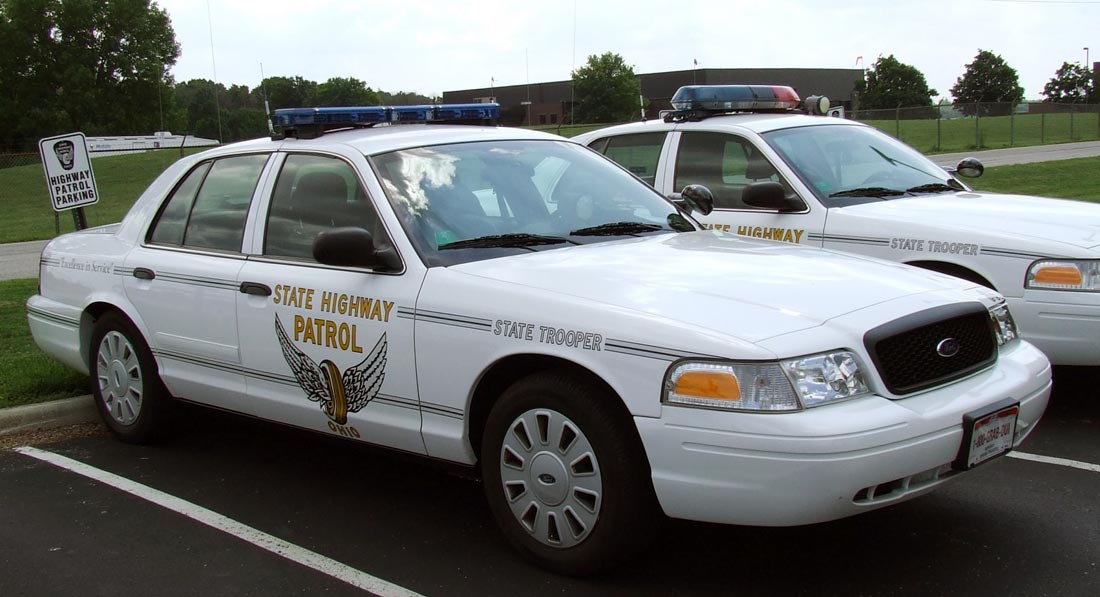
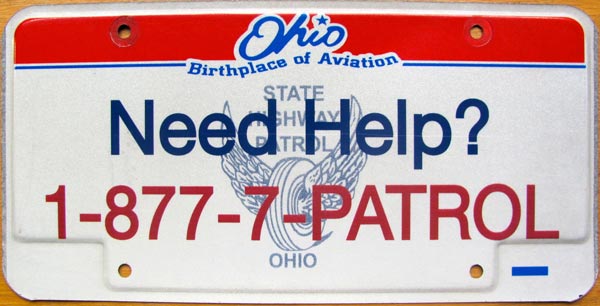 2004-2009 Need Help? issue.
2004-2009 Need Help? issue.
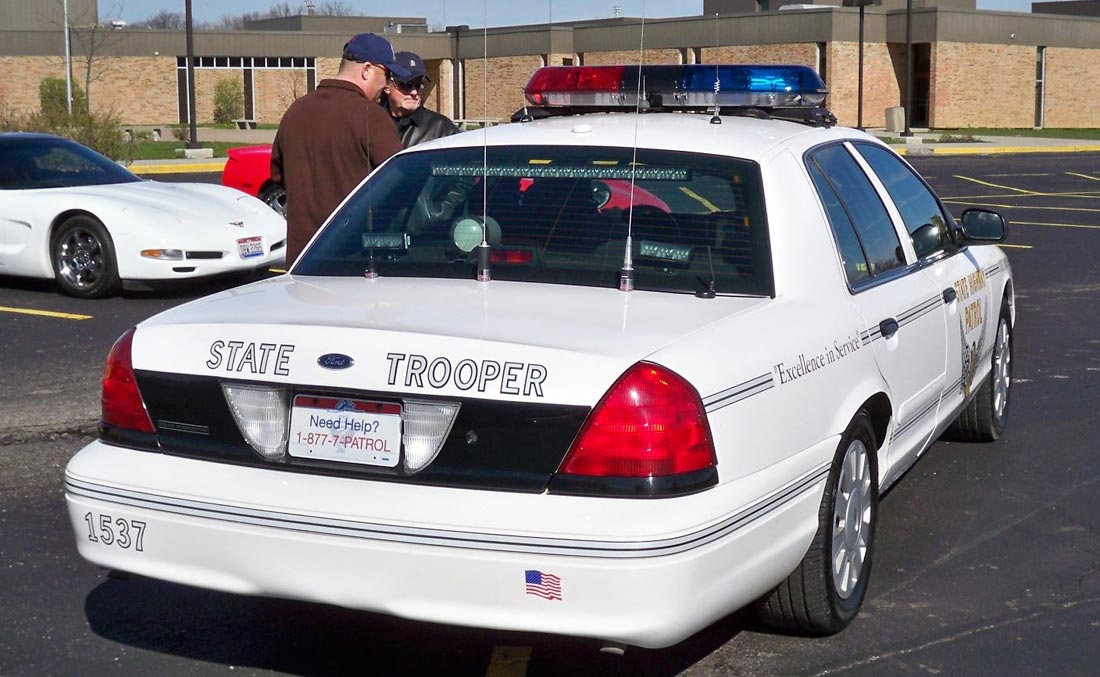
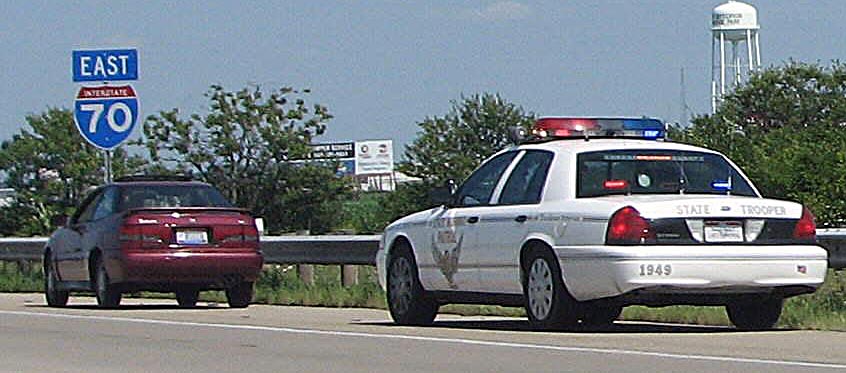
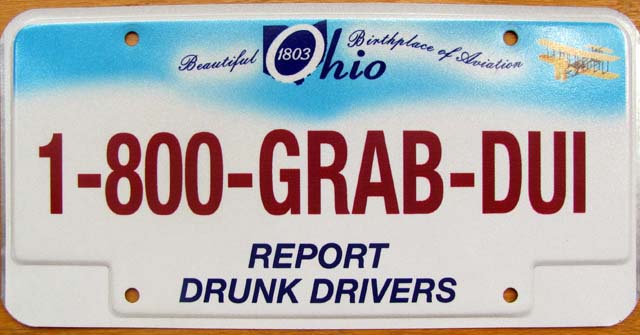 2009-2012 issue.
2009-2012 issue. 
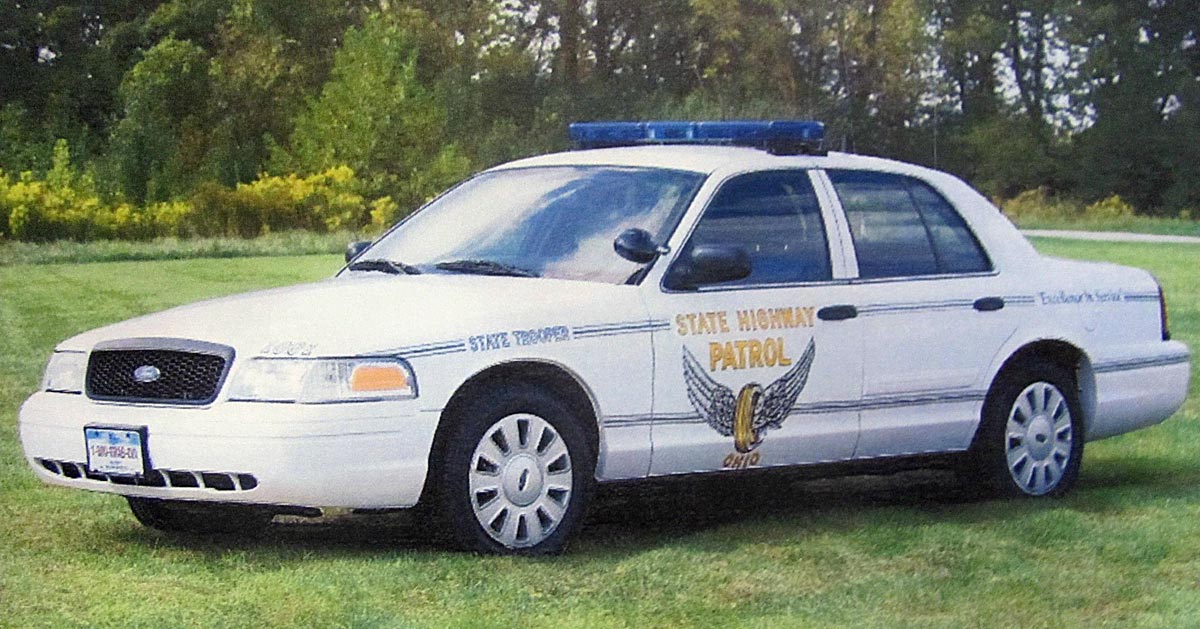

Around late 2011, the Ohio State Highway Patrol unveiled another design for their agency's license plates. Still reflective white, but this time with a large subdued image of the OSHP winged wheel in grey and yellow occupying much of the plate's background. At the top center of the plate is a small OSHP emblem. Below that along the horizontal span are the words DRUG ACTIVITY/IMPAIRED DRIVERS silkscreened in black. Below that and emblazoned across the horizontal center of the plate is CALL silkscreened in black followed by #677 silkscreened in gold with black trim. # 677 is the OSHP's contact number via the cellular phone network. Despite this telephone number replacing 1-800-GRAB-DUI and 1-877-7-PATROL on the license plates, it is stated as of this writing in 2014, both of those numbers are still in service.
Early versions of this #677 license plate have a "reflection" of the Call #677 characters mirroring downwards and to the right of the plate as the colors fade towards the bottom. This reflection feature was dropped around 2012 as it posed an unnecessary distraction from the legibility of the message.
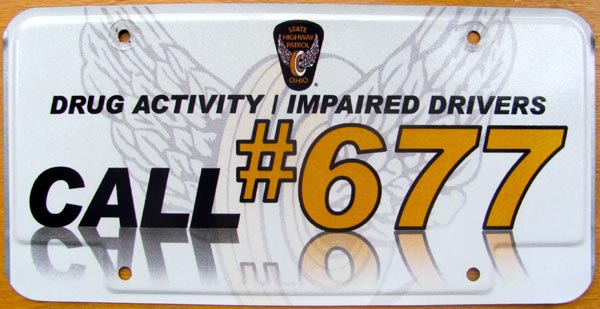 2011-Current Call #677 issue.
2011-Current Call #677 issue.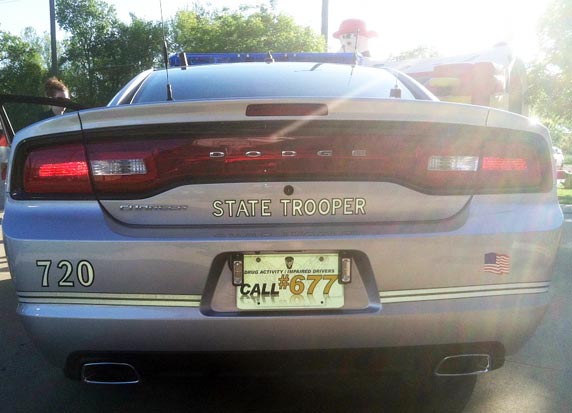
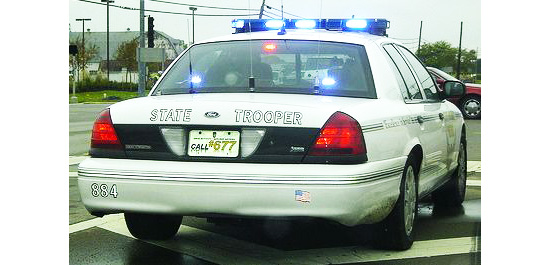
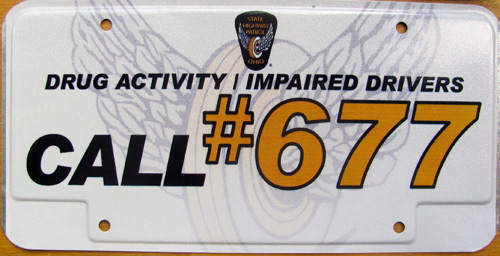 2011-Current Call #677 issue.
2011-Current Call #677 issue.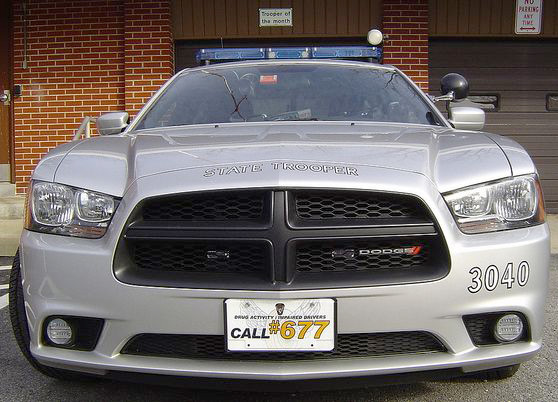
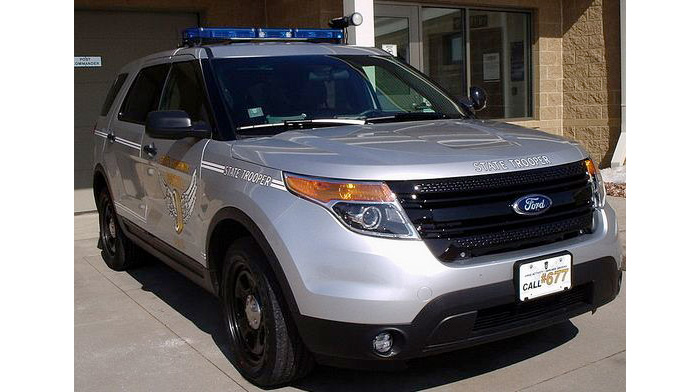
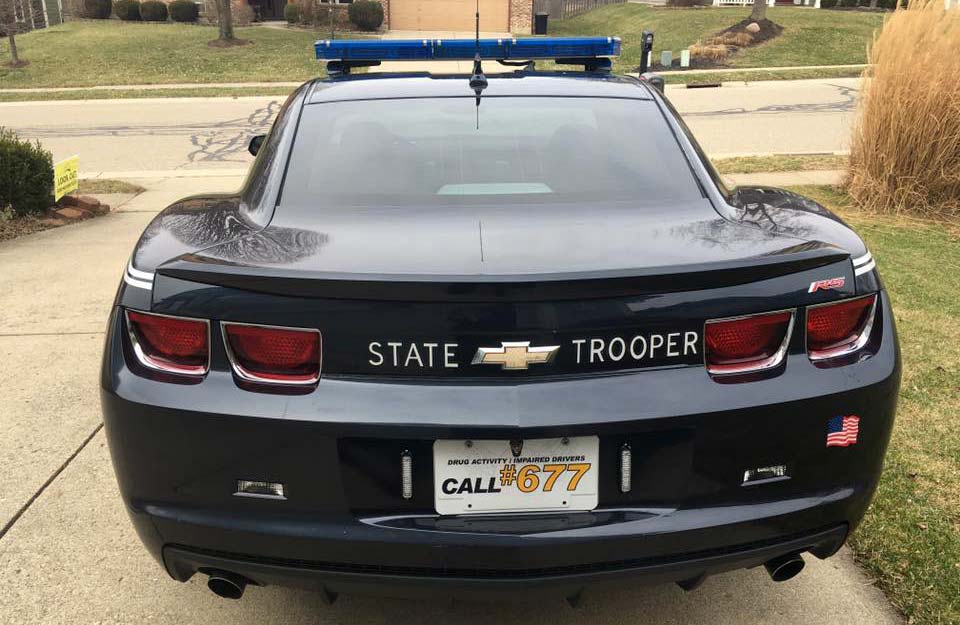 (Courtesy Steven Ilo)
(Courtesy Steven Ilo)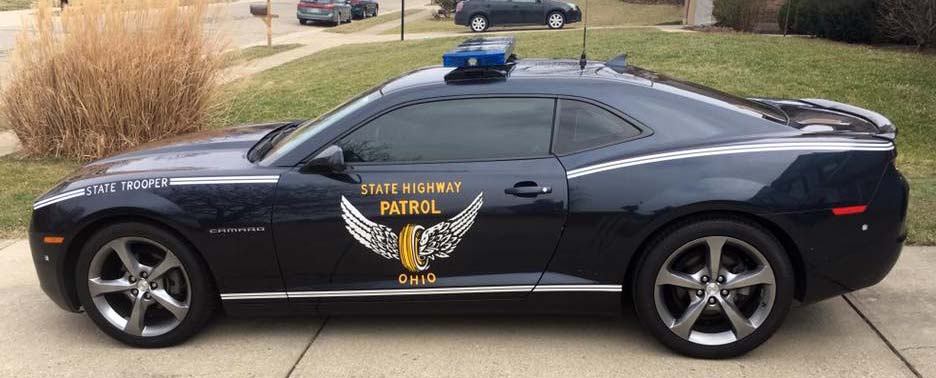
In mid-2016, and for the first time since 1942, the Ohio State Highway Patrol began to run numbered license plates on the marked OSHP fleet. The new plate is an entirely silkscreened license plate with a reflective white background. The plate has a thin gold stripe outline that covers the embossed perimeter of the plate. IMPAIRED DRIVERS/DRUG ACTIVITY is silkscreened in black between the upper mounting holes. The OSHP color emblem occupies the left center field of the plate follwed by the trooper's assignment number in black silkscreened numerals. CALL #677 is silkscreened in black in the bottom center of the plate. The number is associated to the Trooper's radio number and is not the actual car number.
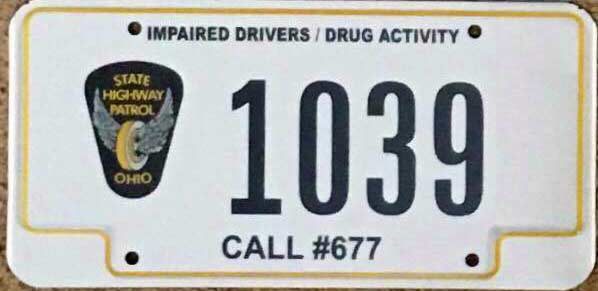 2016-Current issue.
2016-Current issue. 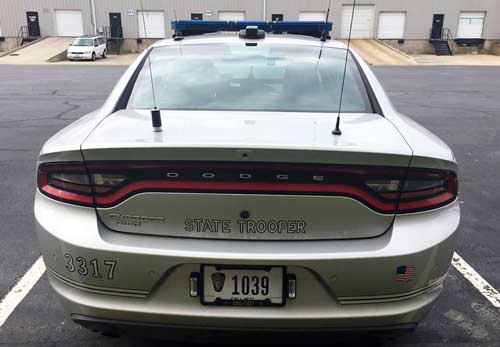 (Courtesy Steven Ilo).
(Courtesy Steven Ilo).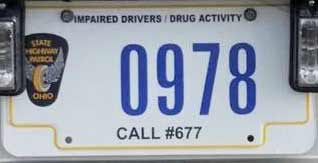 2016-Current ERROR- Blue numerals instead of black.
2016-Current ERROR- Blue numerals instead of black.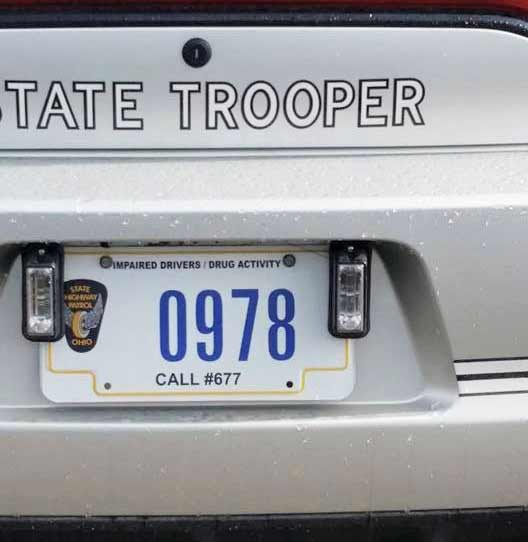
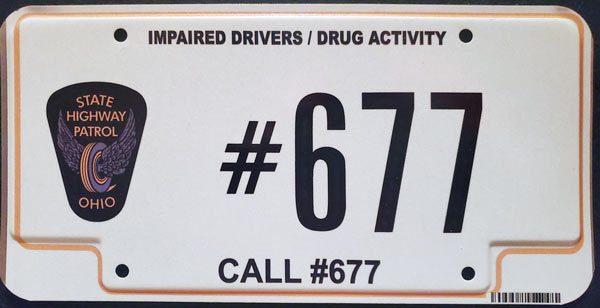 2016 prototype using #677 as assignment number.
2016 prototype using #677 as assignment number.
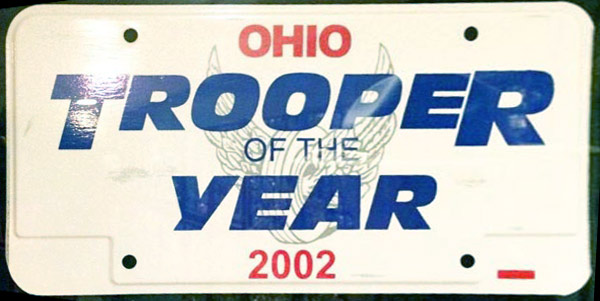 2002 OSHP TROOPER OF THE YEAR plate. Silkscreened steel
2002 OSHP TROOPER OF THE YEAR plate. Silkscreened steel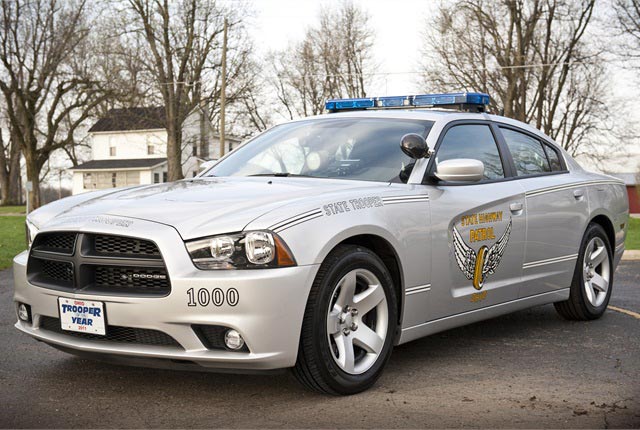
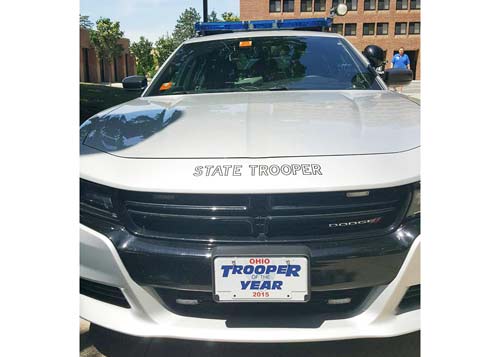 2015 Trooper of the Year-
2015 Trooper of the Year- 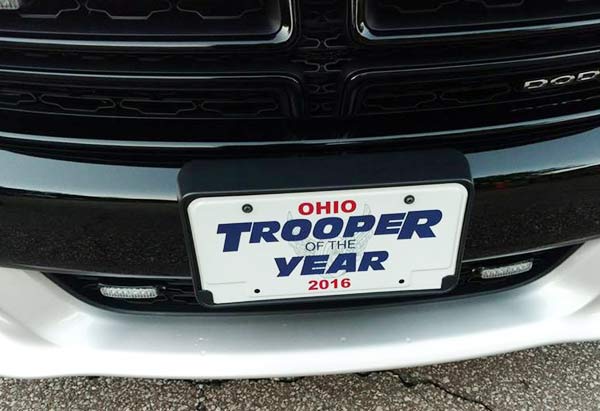 Trooper of the Year 2016.
Trooper of the Year 2016.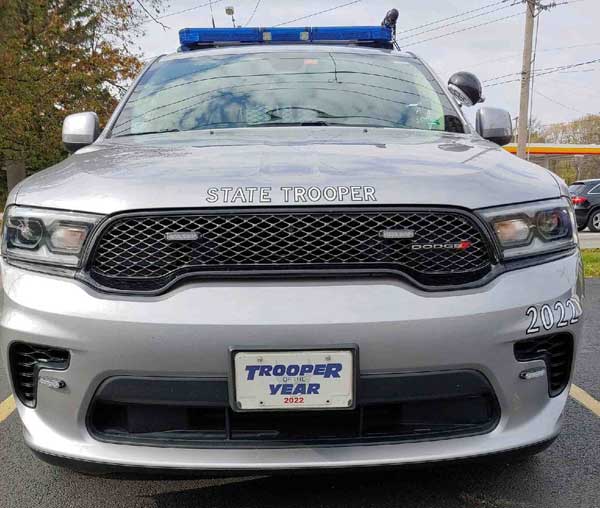 2022 Trooper of the Year
2022 Trooper of the Year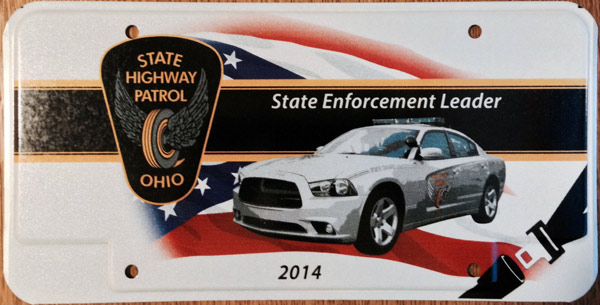 2014 Seatbelt Enforcement Leadership Award plate. Silkscreened steel.
2014 Seatbelt Enforcement Leadership Award plate. Silkscreened steel.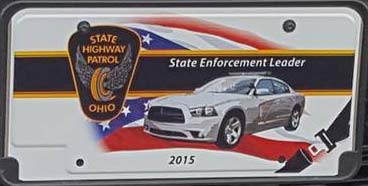 2015 Seatbelt Enforcement Leadership Award plate. Silkscreened steel
2015 Seatbelt Enforcement Leadership Award plate. Silkscreened steel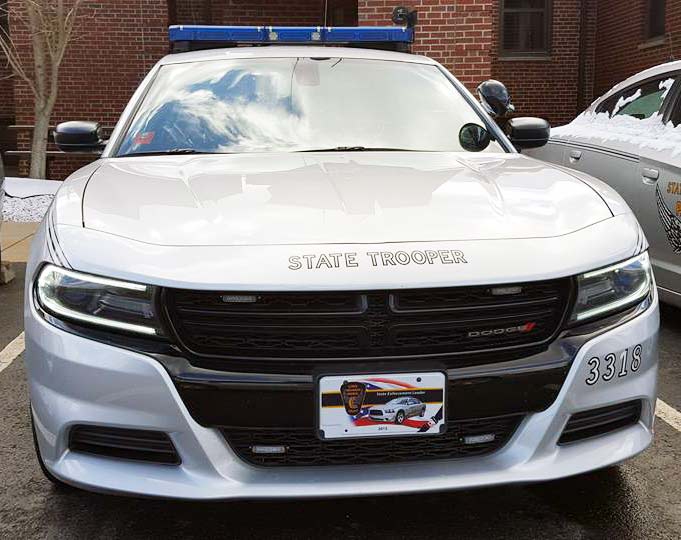
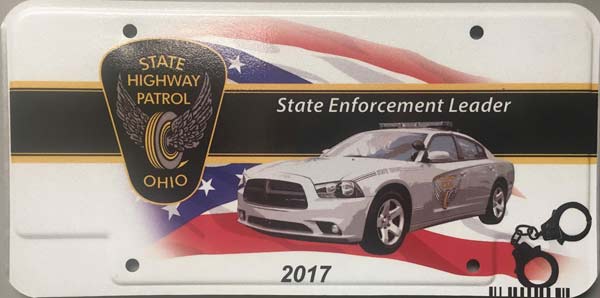 2017 State Enforcement Leadership Award plate. Silkscreened steel
2017 State Enforcement Leadership Award plate. Silkscreened steel
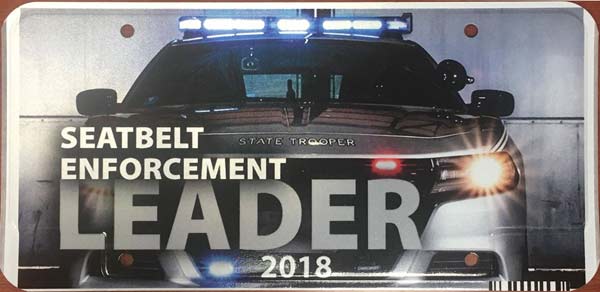 2018 Seatbelt Enforcement Leadership Award plate. Silkscreened steel
2018 Seatbelt Enforcement Leadership Award plate. Silkscreened steel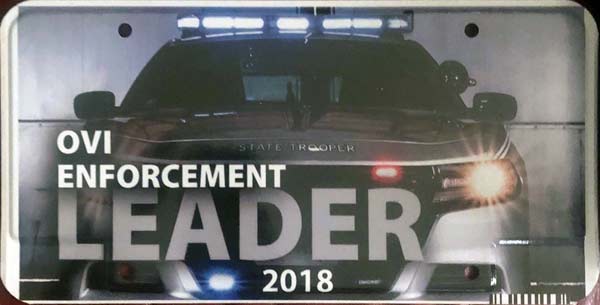 2018 State Enforcement Leadership Award plate. Silkscreened steel
2018 State Enforcement Leadership Award plate. Silkscreened steel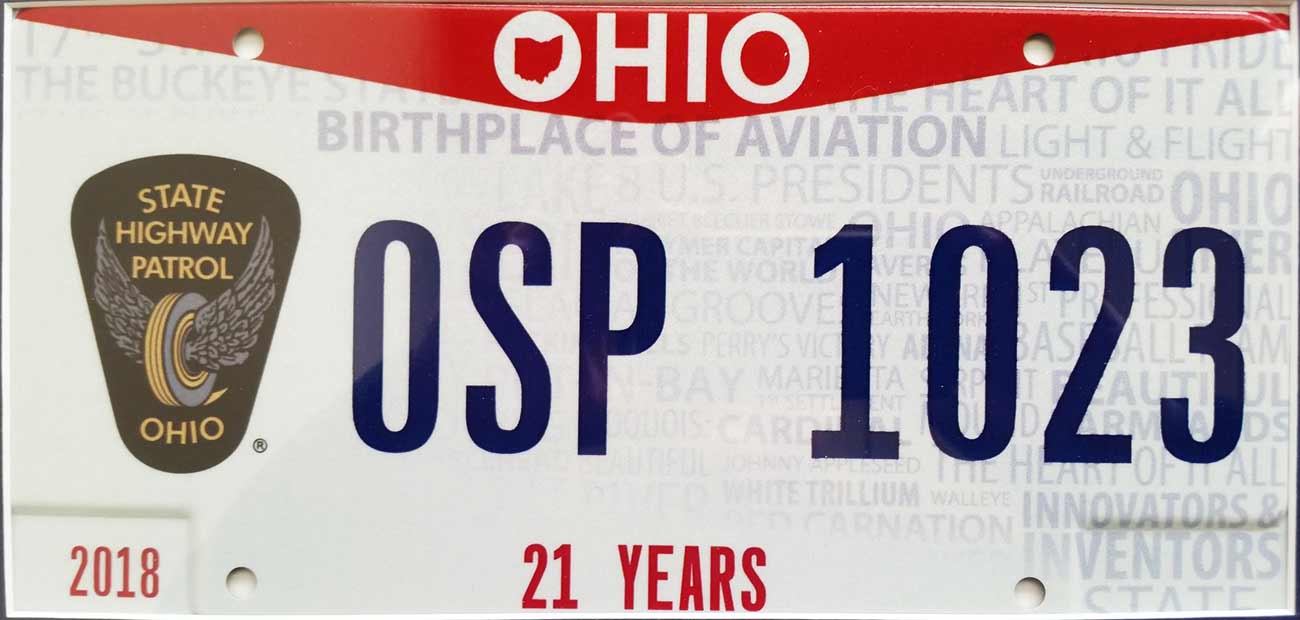 2018 Retirement Presentation Plate to Badge # 1023 after 21 years of service.
2018 Retirement Presentation Plate to Badge # 1023 after 21 years of service.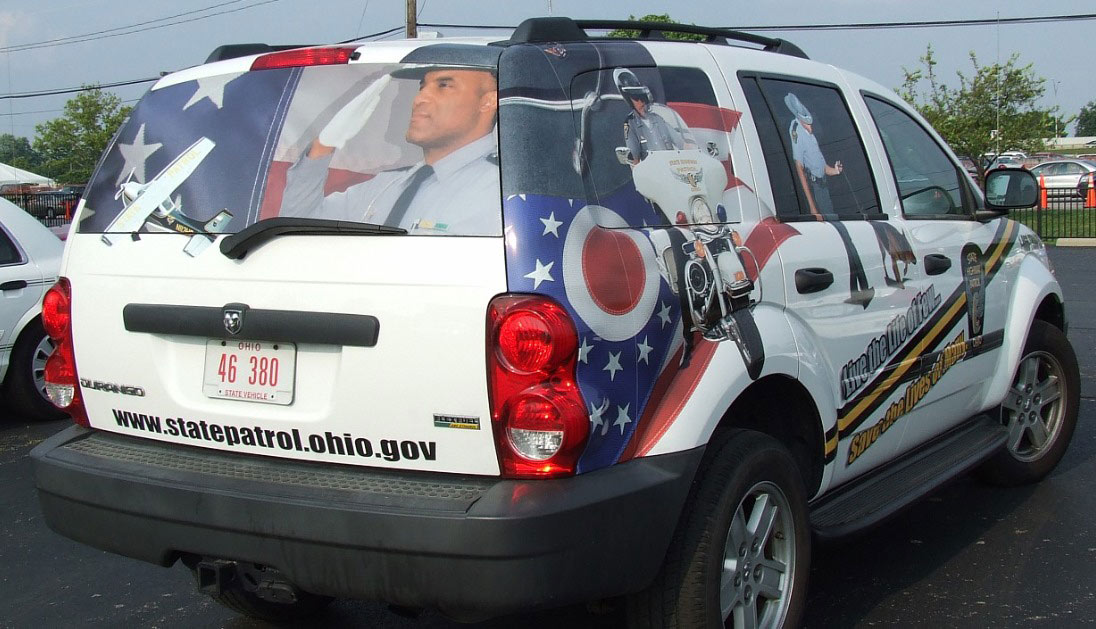 Ohio State Highway Patrol recruitment vehicle using the 46 code State Vehicle Code plates.
Ohio State Highway Patrol recruitment vehicle using the 46 code State Vehicle Code plates.
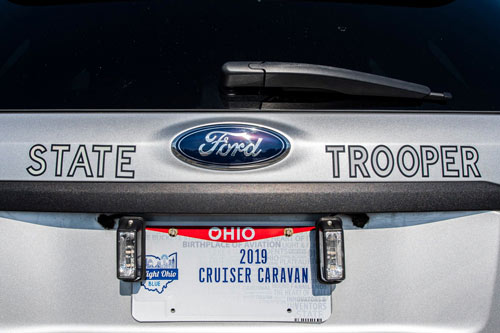 2019 Cruiser Caravan event issue.
2019 Cruiser Caravan event issue.2023 marked the 90th Anniversary of the Ohio State Highway Patrol. To nobody's surprise, the OSHP created and deployed an attractive new license plate to commemmorate the occasion.
The BMV-made silkscreened steel license plate on first glance is predominantly gray with a white border on the perimeter of the plate. The gray background is divided horizontally by a black line in the center of a wider white band. A roundel in the center of the plate has its top half in black with SERVICE WITH in white and the bottom half in gray with A PURPOSE in black.
The center of the roundel features the full color OSHP emblem with Est. 1933 dividing the roundel at the center.
A pale orange scroll unfurls below the lower half of the roundel with 90th ANNIVERSARY inscribed in black.
There is a black UPC barcode in the far bottom right corner.
These 90th Anniversary plates were run rear only on the marked OSHP fleet including motorcycles for 2023.
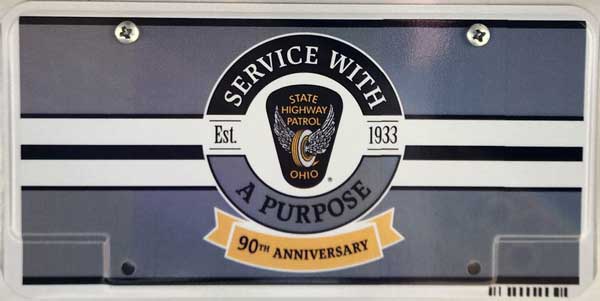 2023 90th Anniversary issue.
2023 90th Anniversary issue.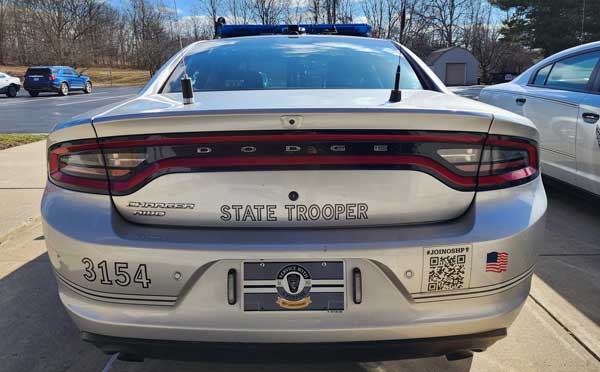 (Courtesy Tricia Schirtz)
(Courtesy Tricia Schirtz) The Ohio State Highway Patrol's ACE/Blue Max program is an incentive recognition system which rewards troopers who recover stolen vehicles with on-the-spot suspect apprehension by presenting lightning bolt decals for display on their patrol cars, much as ACE World War I and II air force pilots marked their aircraft's fuselage with the symbol of each downed enemy aircraft.
Five stolen vehicle recoveries with on- the-spot suspect apprehensions in one calendar year earn the ACE Award, with the officer recovering the most stolen vehicles and on-the-spot arrests within the year, designated as the Blue Max winner. Each ACE Award winner receives a certificate, special ACE license plates for display on the patrol car, and a uniform ribbon.
The Blue Max winner (Ace of ACEs) receives a certificate, the Blue Max medal, Blue Max license plates, a uniform ribbon, a Superintendent's Citation of Merit, and exclusive use of a patrol car for a year.
Since its inception in 1972 as the Vehicle Larceny Enforcement Program, the ACE/Blue Max program has produced over 550 ACEs. To date, there have been over 40 OSHP Blue Max plates issued. There have been many variations on the style and format of OSHP ACE and Blue Max license plates.
This successful program has been emulated by many law enforcement agencies throughout the United States. Since the program began, it has played an important role in helping Ohio maintain a vehicle theft rate well below the national average. From program inception through the end of 2001, a total of 598 Ohio Highway Patrol officers earned ACE status. In that time, troopers recovered 37,631 stolen vehicles valued at $177,773,032.
These ACE and Blue Max license plates were the ONLY license plates run on Ohio State Highway Patrol vehicles between 1972 to 1976 as "regular" OSHP vehicles ran no license plates at all during that time.
Since 1978, the plates had red lightning bolts for even years and blue lightning bolts for odd years. The practice of alternating red and blue ended sometime in the 2000's it is believed. All current ACE license plates display blue lightning bolts.
A great deal of thanks goes to the late George McDuffie who had the good sense to place dates on the backs of these license plates in order to differentiate one issue from the next when they made up part of his collection.
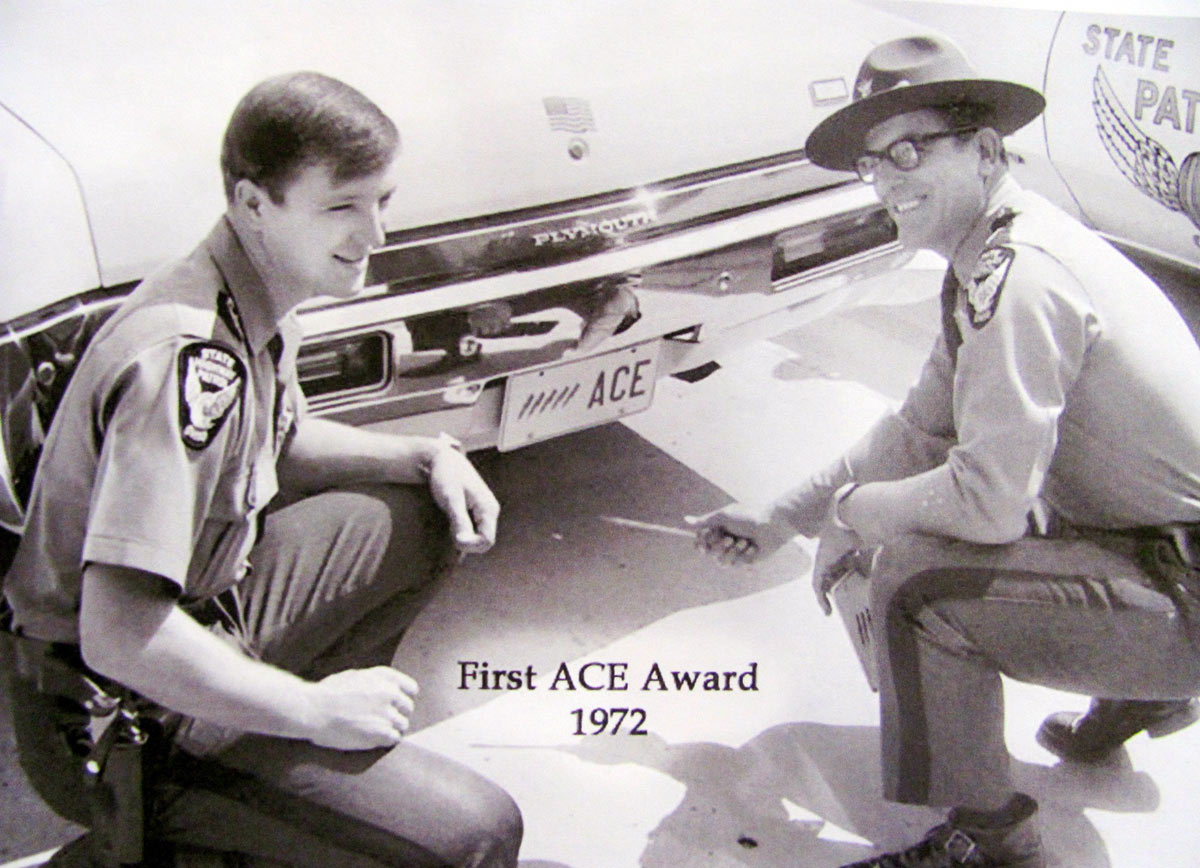
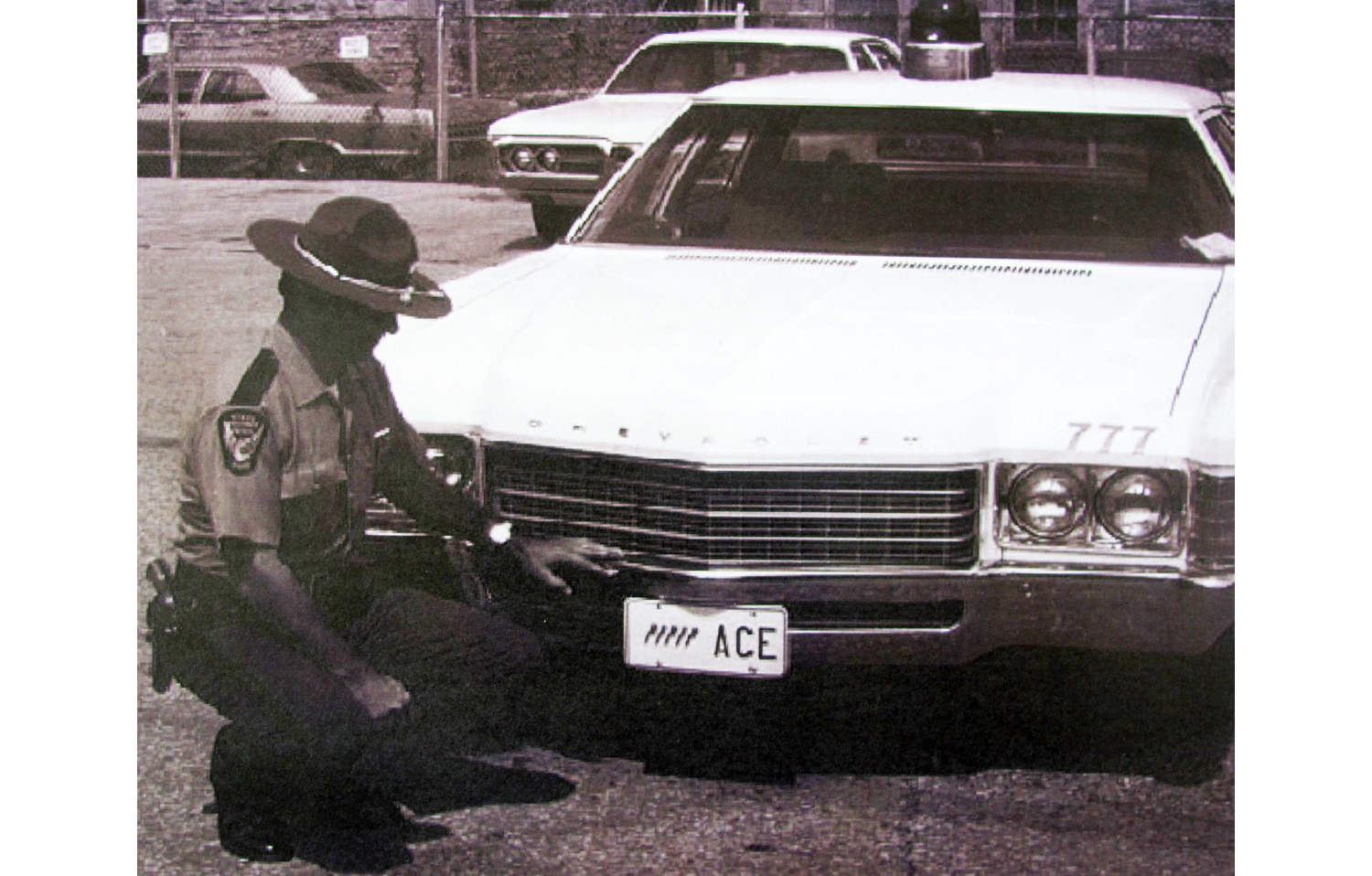
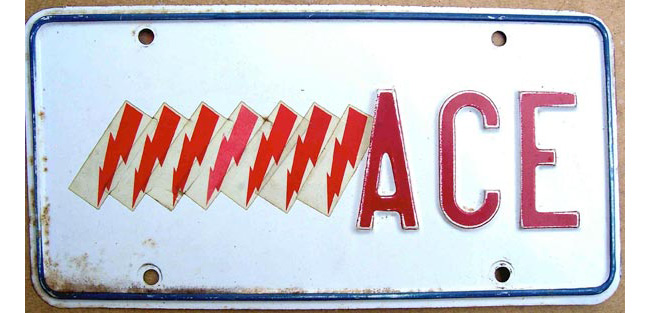 1972 issue
ACE award- First Issue Embossed steel. Red Bolts.
1972 issue
ACE award- First Issue Embossed steel. Red Bolts.
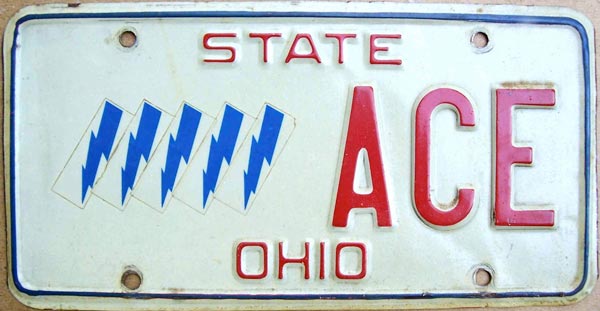 1973 issue ACE award- First reflective issue. Embossed steel.
1973 issue ACE award- First reflective issue. Embossed steel.
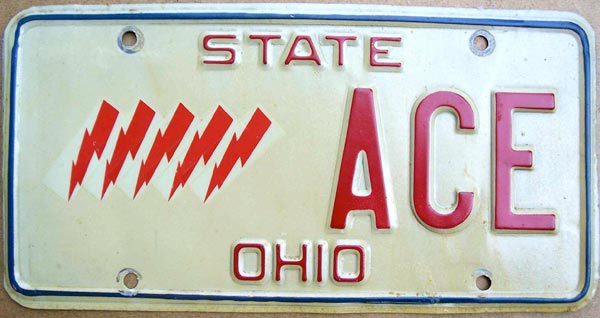 Early 1974 issue. Embossed steel.
Early 1974 issue. Embossed steel. 
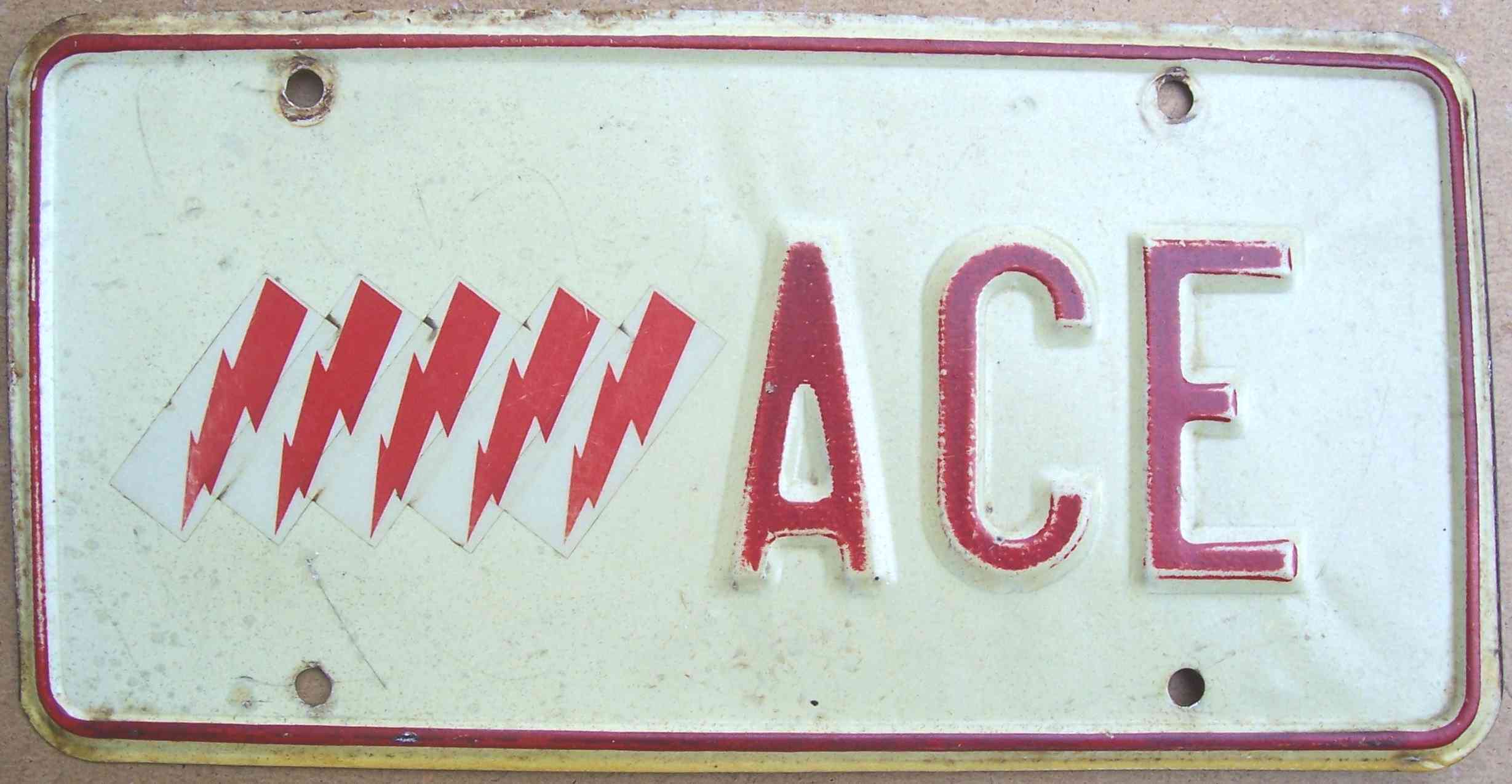 Late 1974 issue. Embossed steel.
Late 1974 issue. Embossed steel. 
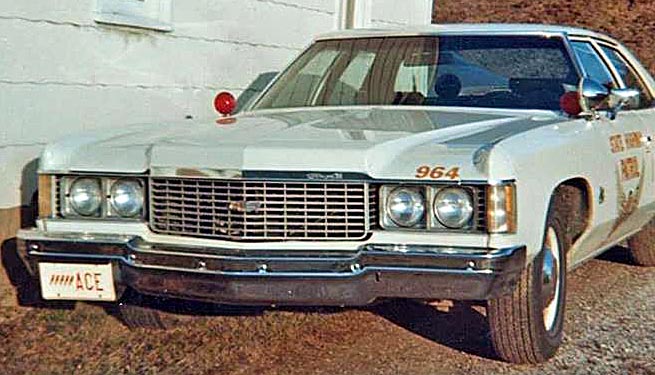 1974 ACE plate on patrol car of Ptlm. Ron Teare.
1974 ACE plate on patrol car of Ptlm. Ron Teare. 1975 issue. Embossed steel.
1975 issue. Embossed steel. 
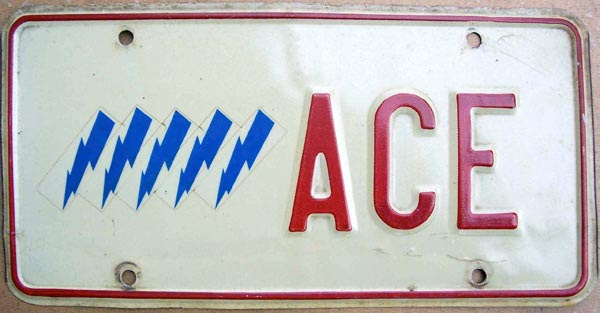 1976 issue. Embossed steel.
1976 issue. Embossed steel. 
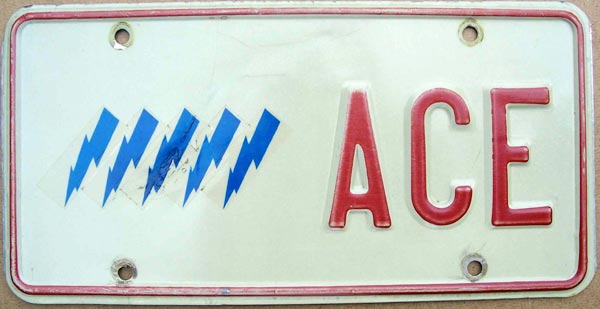 1977 issue. Embossed aluminum.
1977 issue. Embossed aluminum. 
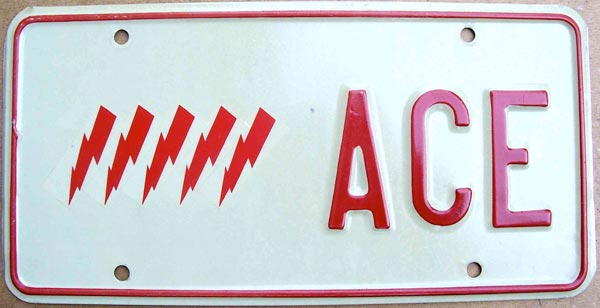 1978 issue. Embossed aluminum.
1978 issue. Embossed aluminum. 
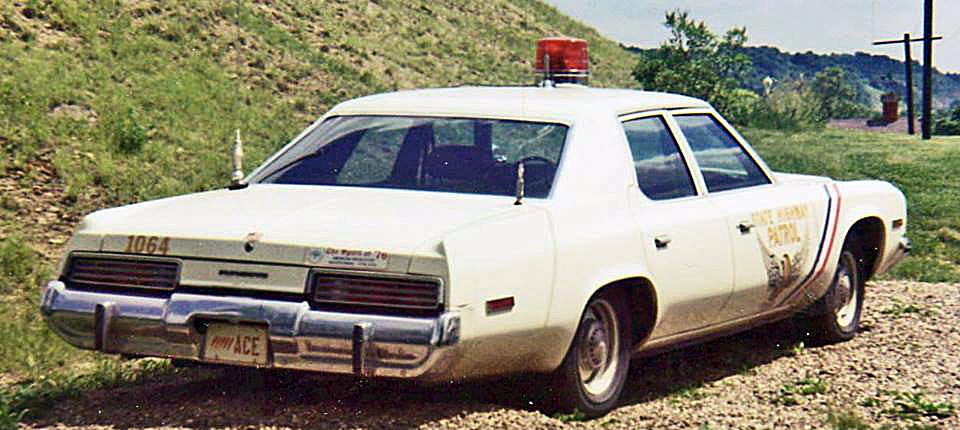
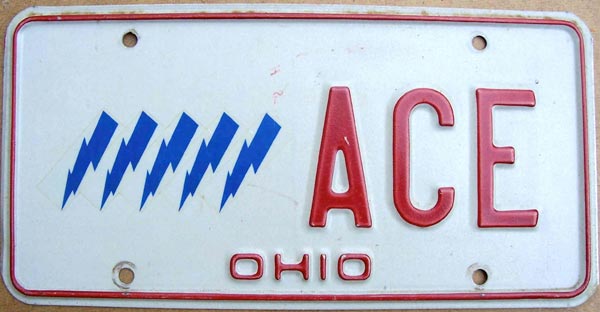 1979 issue. Embossed aluminum.
1979 issue. Embossed aluminum. 
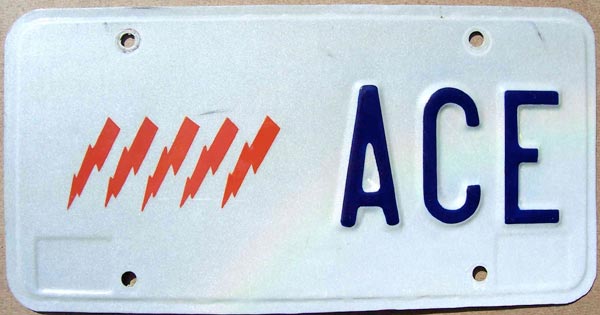 Early 1980 issue. Embossed aluminum. Red bolts- Blue ACE.
Early 1980 issue. Embossed aluminum. Red bolts- Blue ACE.
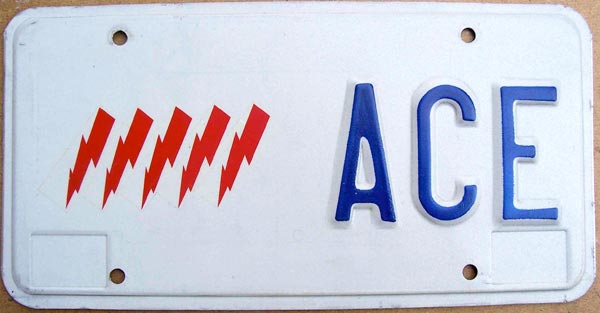 Late 1980 issue. Embossed aluminum. Red bolts- Blue ACE.
Late 1980 issue. Embossed aluminum. Red bolts- Blue ACE.
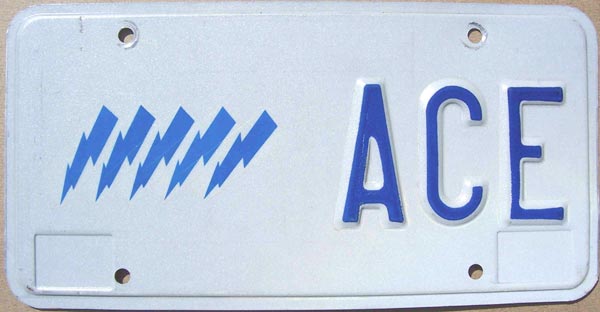 1981 issue.
Embossed aluminum.
1981 issue.
Embossed aluminum. 
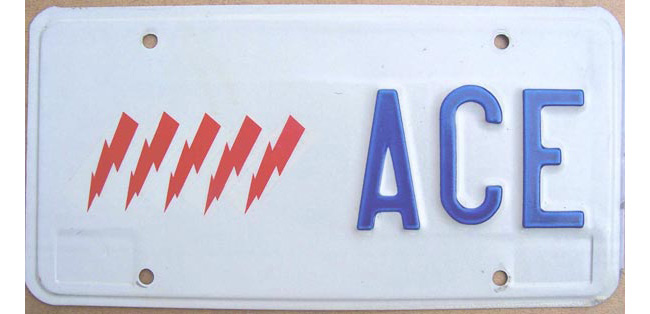 1982 issue. Embossed steel.
1982 issue. Embossed steel. 
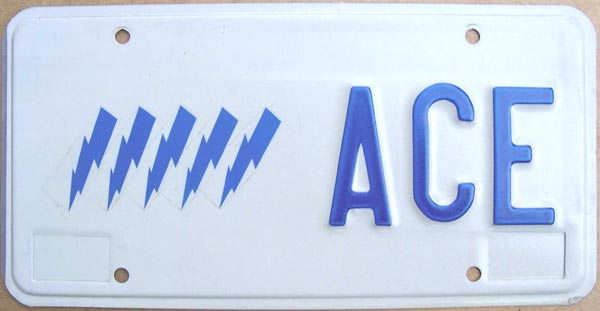 1983 issue. Embossed steel.
1983 issue. Embossed steel. 
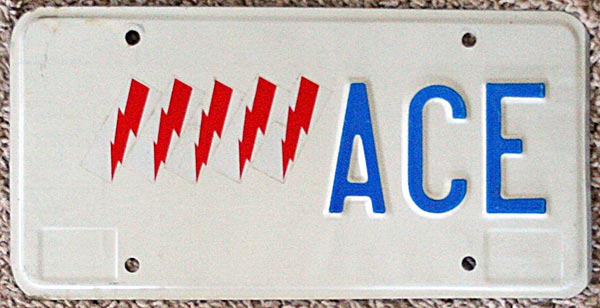 1984 issue. Embossed steel.
1984 issue. Embossed steel. 
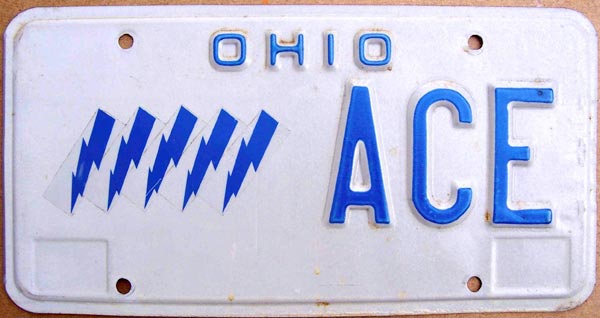 1985 issue. Embossed steel.
1985 issue. Embossed steel. 
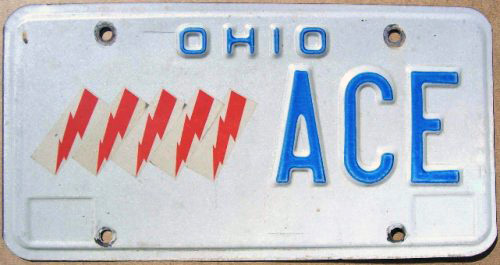 1986 issue. Embossed steel.
1986 issue. Embossed steel. 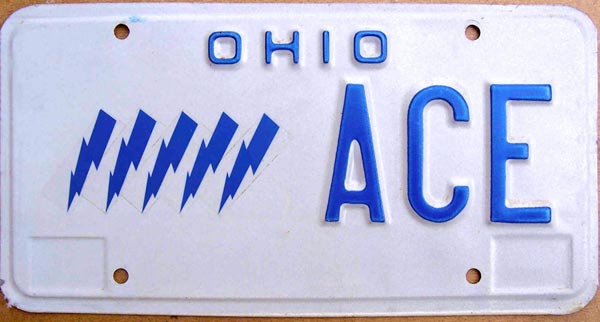 1987 issue. Embossed steel.
1987 issue. Embossed steel. 
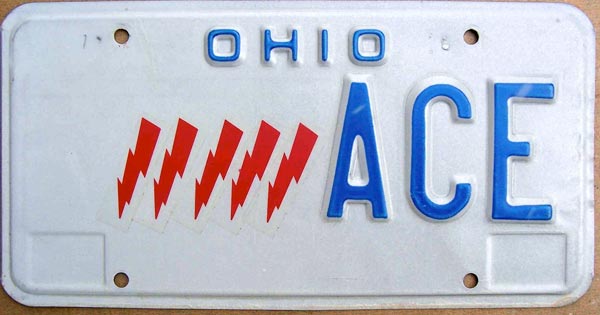 1988 issue. Embossed steel.
1988 issue. Embossed steel. 
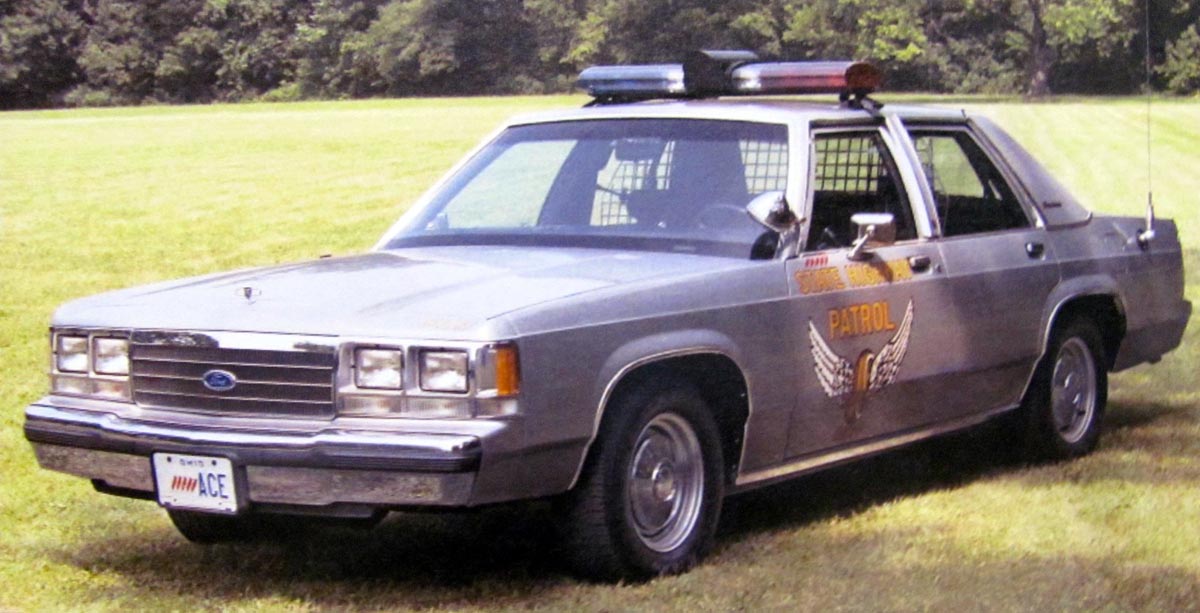
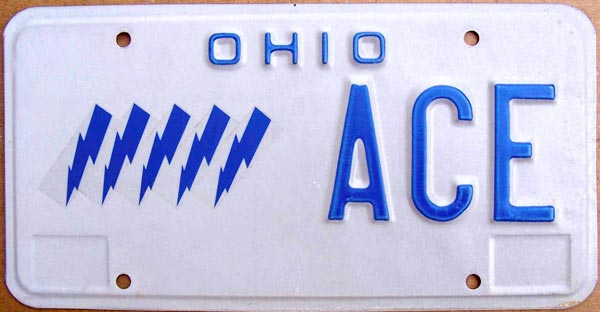 1989 issue. Embossed steel.
1989 issue. Embossed steel. 
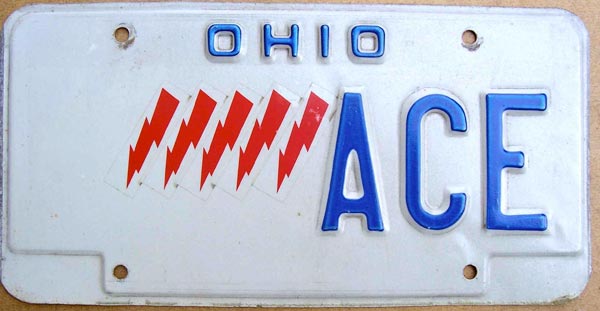 1990 issue. Embossed galvanized steel. Red bolts- Blue ACE.
1990 issue. Embossed galvanized steel. Red bolts- Blue ACE.
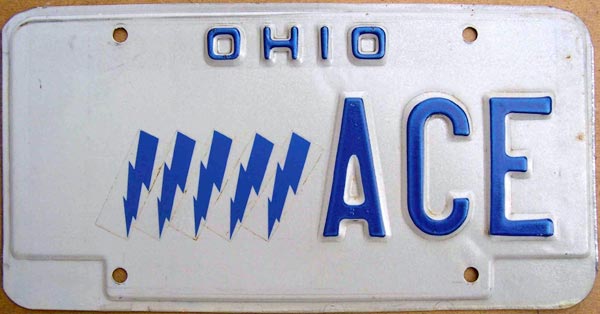 1991 issue. Embossed galvanized steel. Blue bolts- Blue ACE.
1991 issue. Embossed galvanized steel. Blue bolts- Blue ACE.
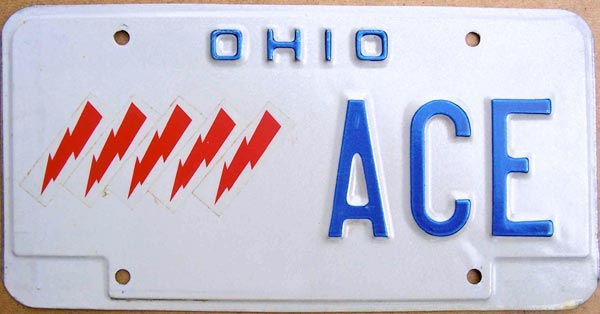 1992 issue. Embossed galvanized steel. Red bolts- Blue ACE.
1992 issue. Embossed galvanized steel. Red bolts- Blue ACE.
 1993 issue. Embossed steel.
1993 issue. Embossed steel. 
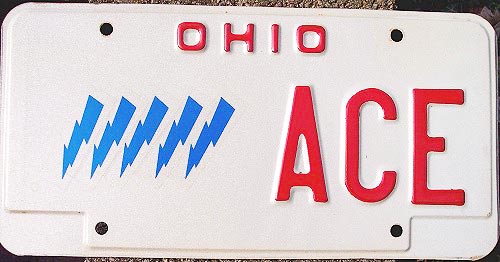 Late 1990's issue-
Late 1990's issue- 
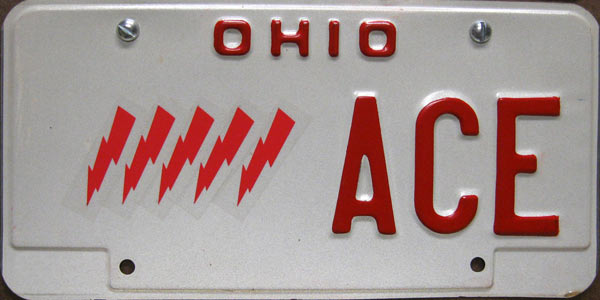 Late 1990's "All Red" issue.
Late 1990's "All Red" issue.
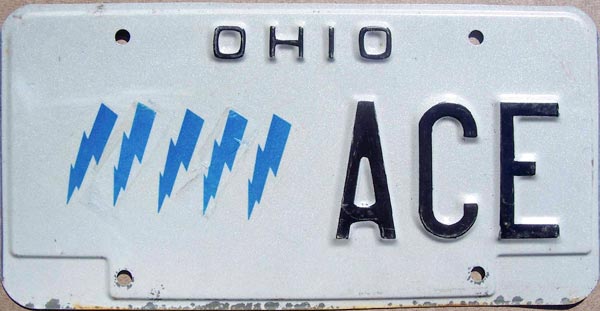 1990's issue-
1990's issue- 

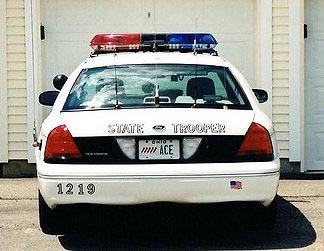
 Early to mid 2000's issue.
Early to mid 2000's issue. 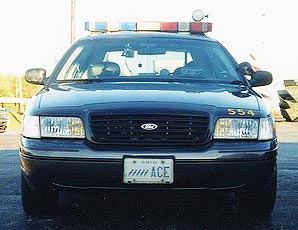
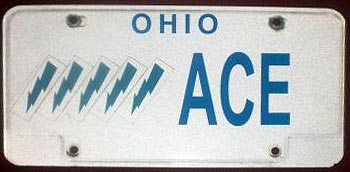 Circa 2005 issue.
Circa 2005 issue. 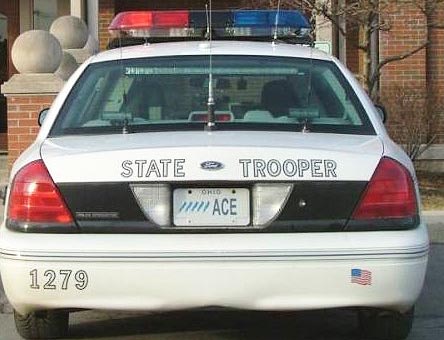
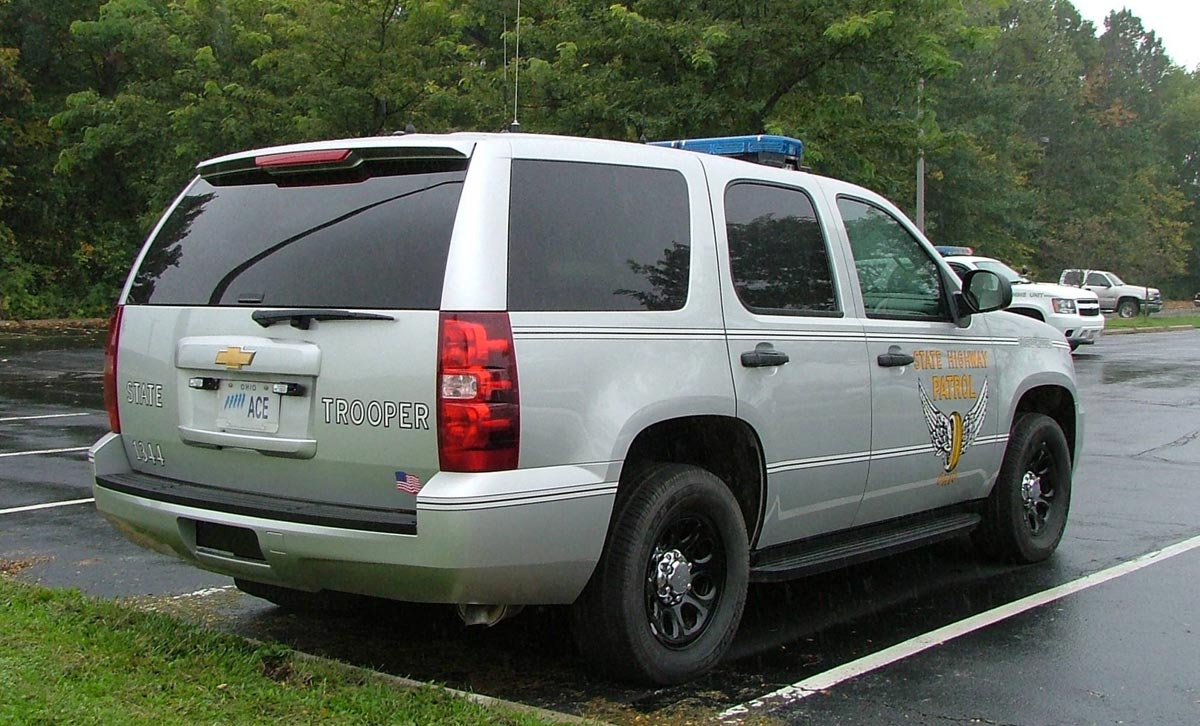
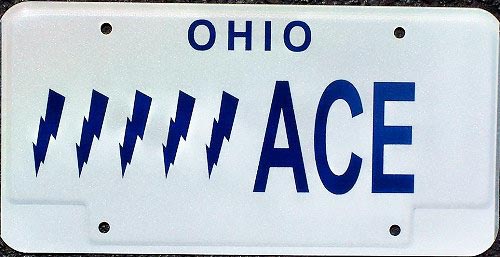 Late 2000's- current issue.
Late 2000's- current issue.
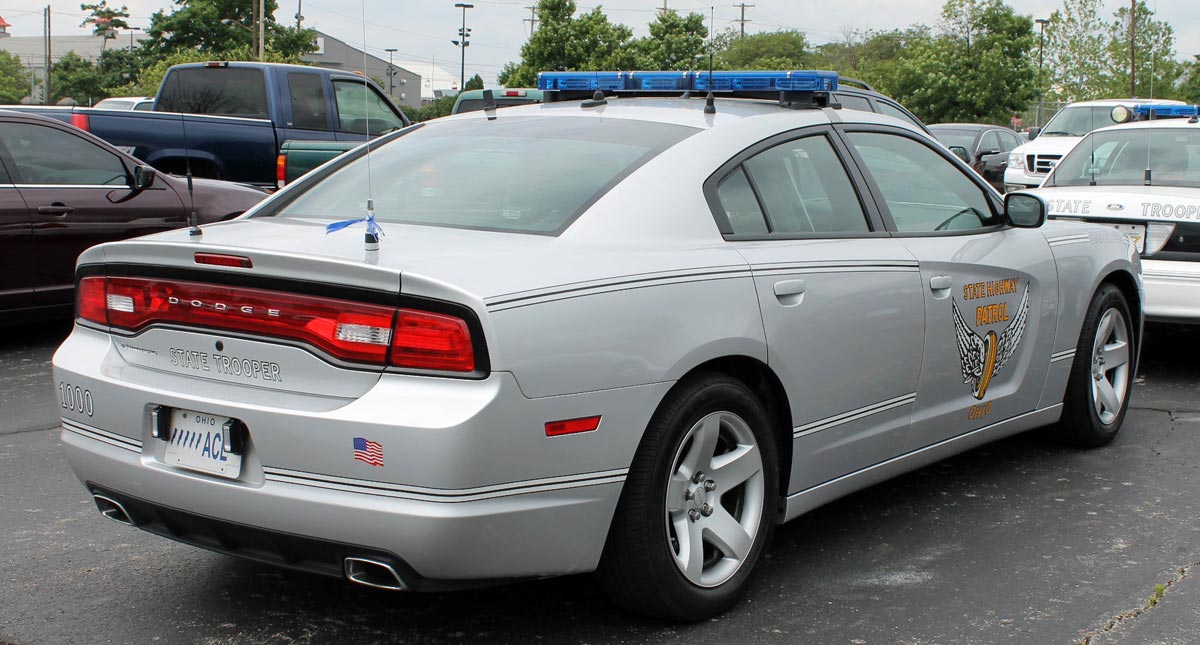
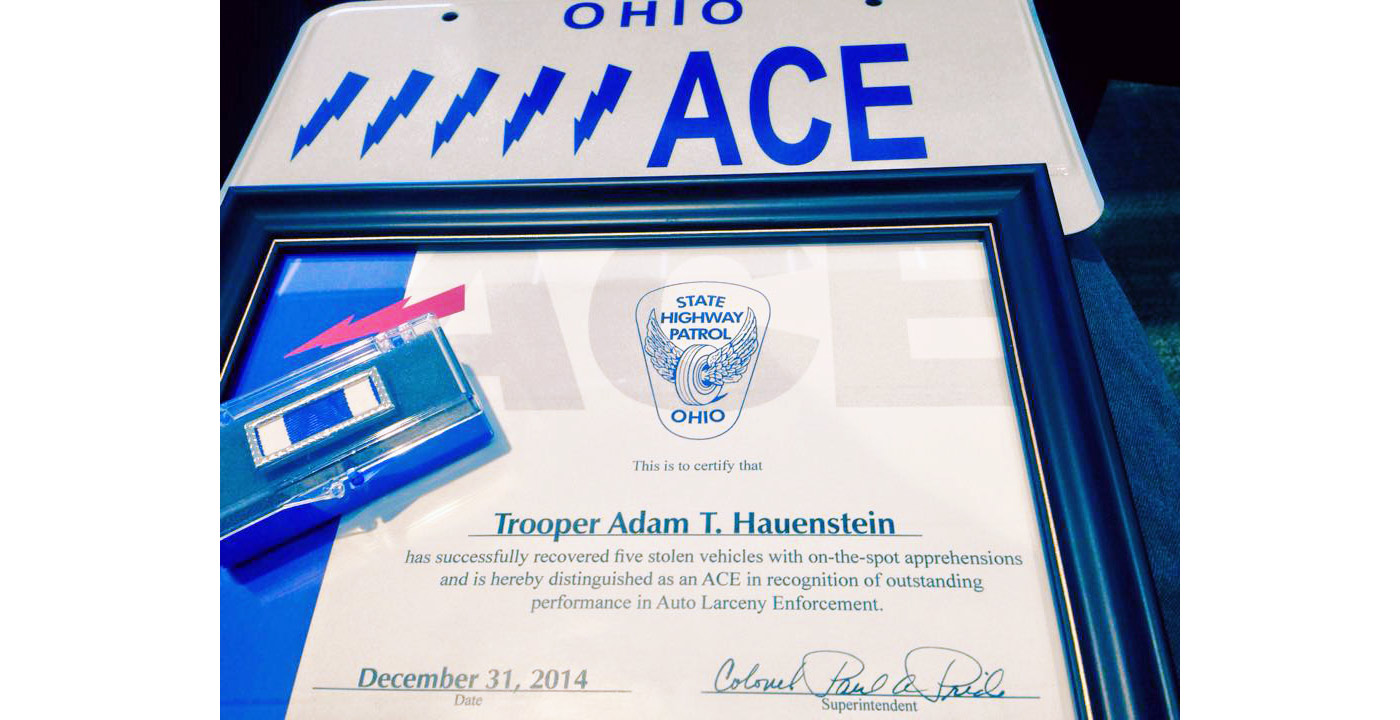 ACE Award plate, Service Ribbon and Certificate. Courtesy Adam Hauenstein.
ACE Award plate, Service Ribbon and Certificate. Courtesy Adam Hauenstein.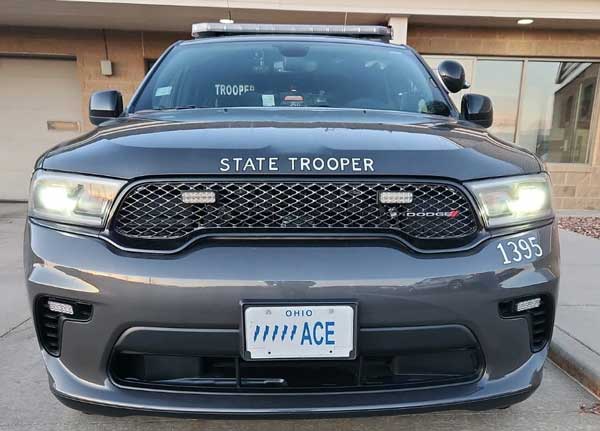 2023
2023In January of 2016, the Ohio State Highway Patrol unveiled the first ACE motorcycle license plate for ACE Award recipients. The 7" x 4" step-bordered reflective white aluminum plate features the state name silkscreened in red at the top center of the plate. Five lightning bolts followed by ACE occupy the center span of the plate and silkscreened in dark blue.
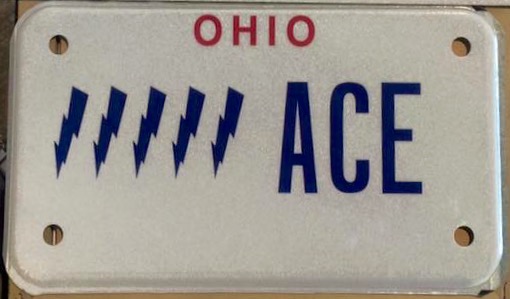 2016-Current ACE motorcycle issue.
2016-Current ACE motorcycle issue.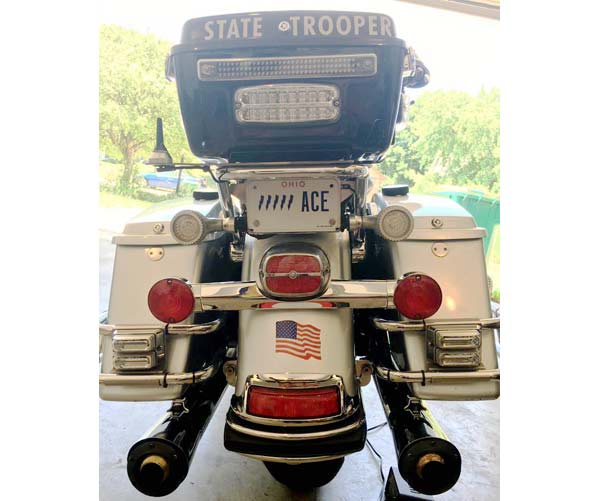
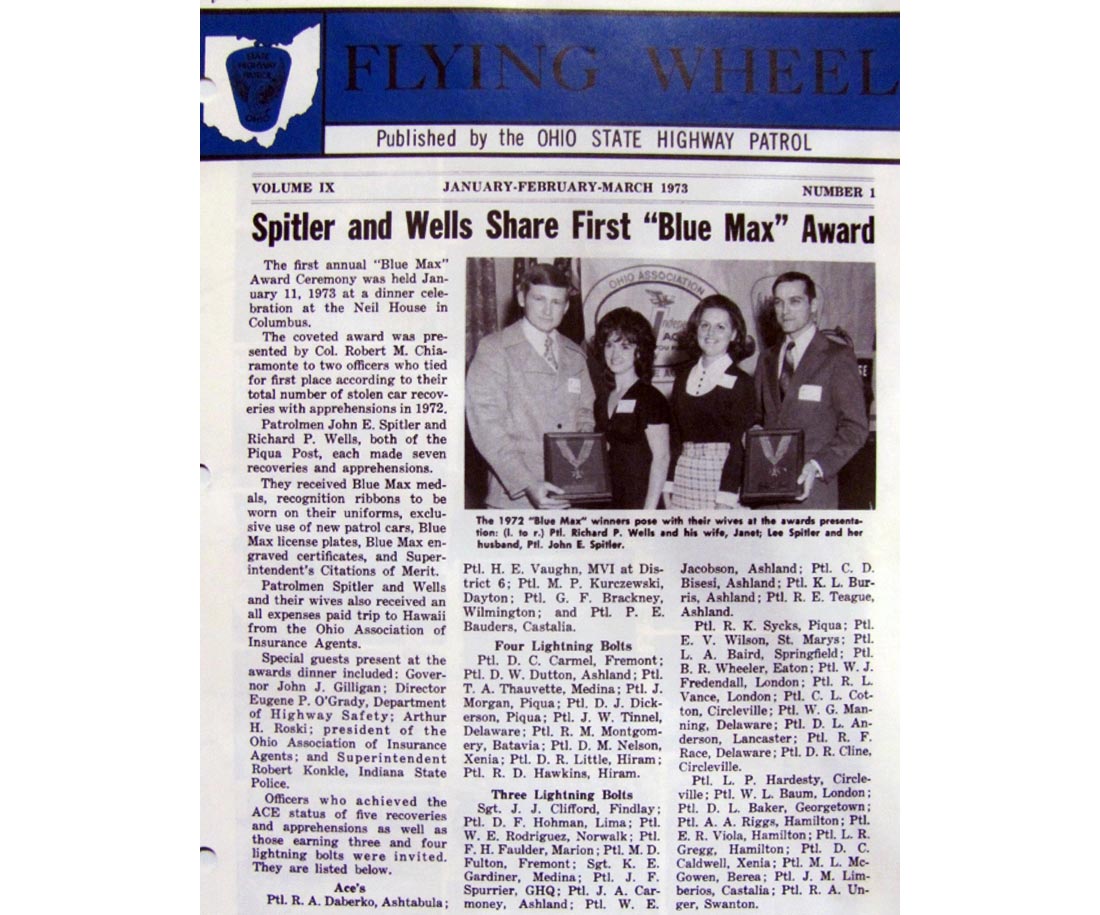
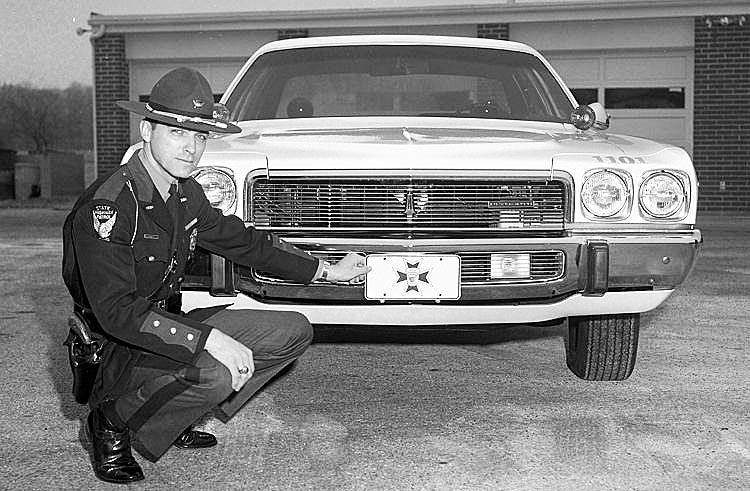
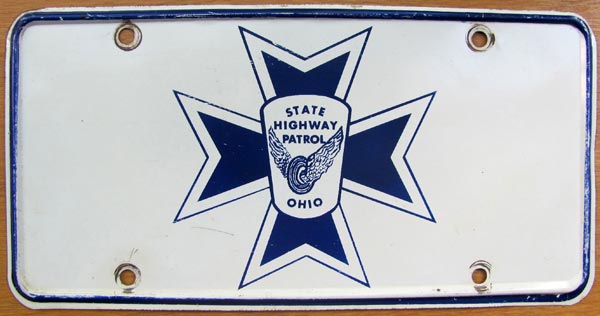 First issue Blue Max. The Ace of ACE's.
First issue Blue Max. The Ace of ACE's.
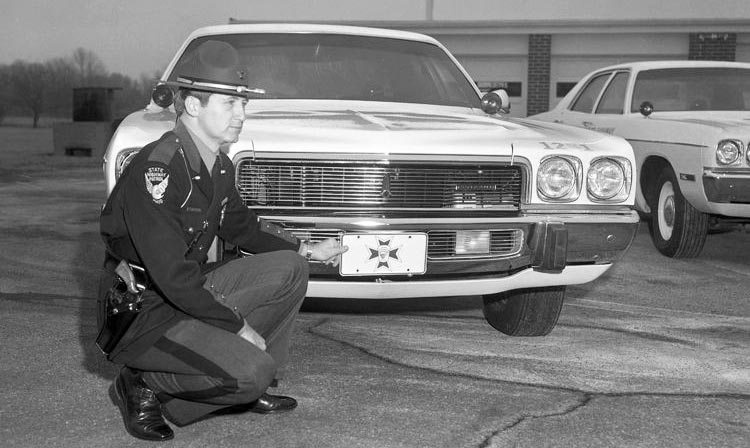
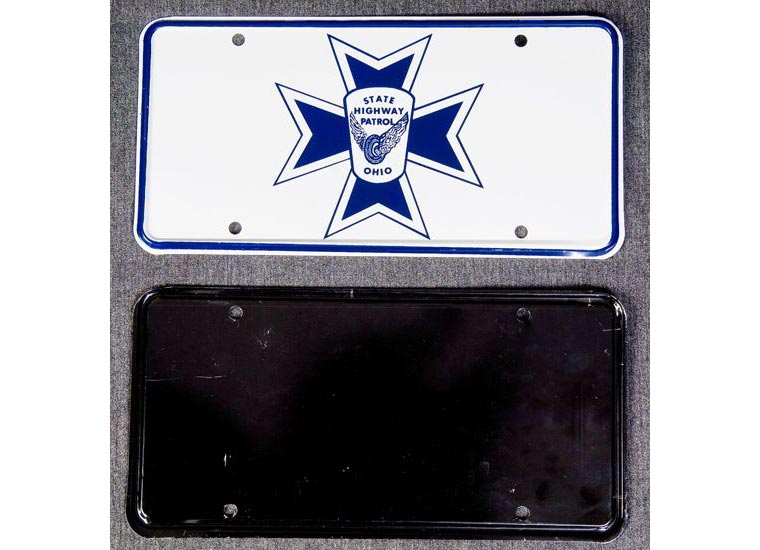 First issue Blue Max (front and back)
First issue Blue Max (front and back)
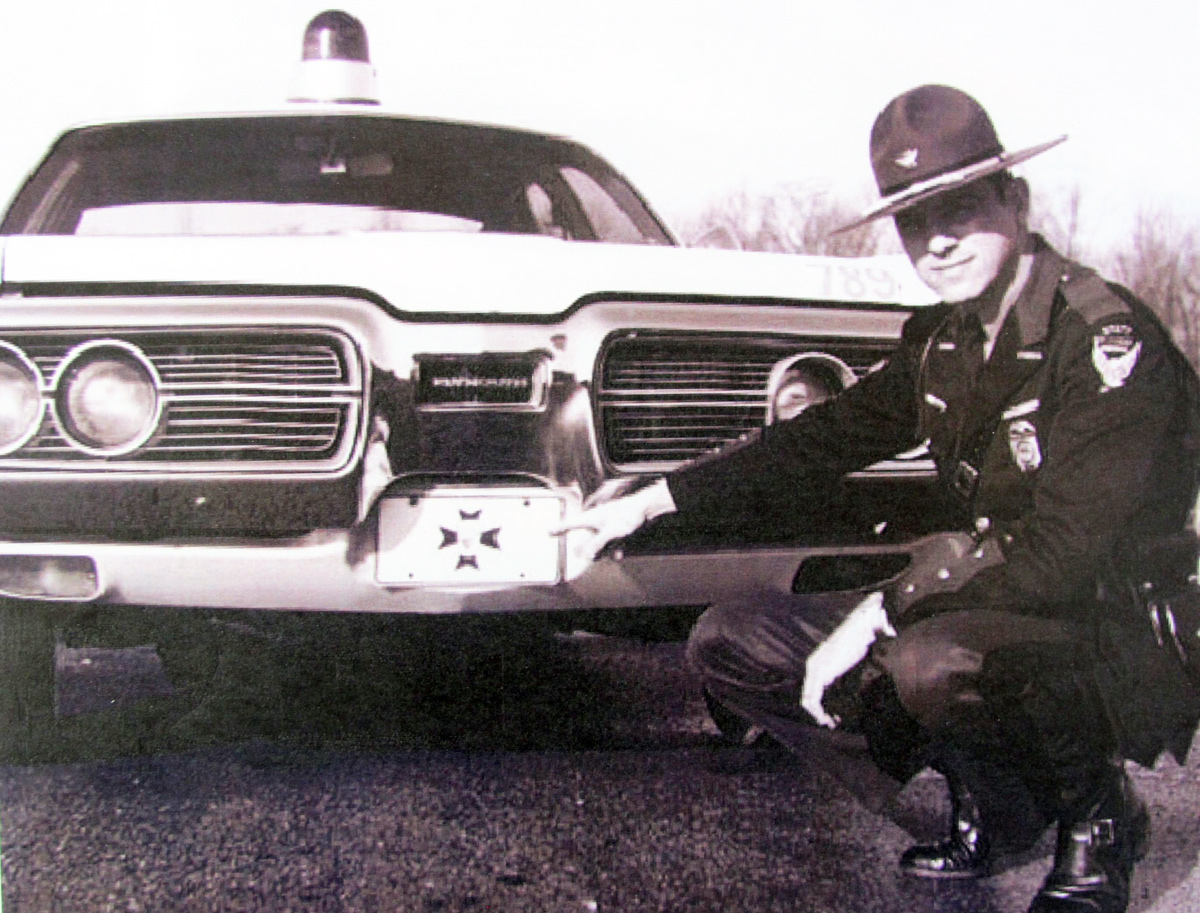
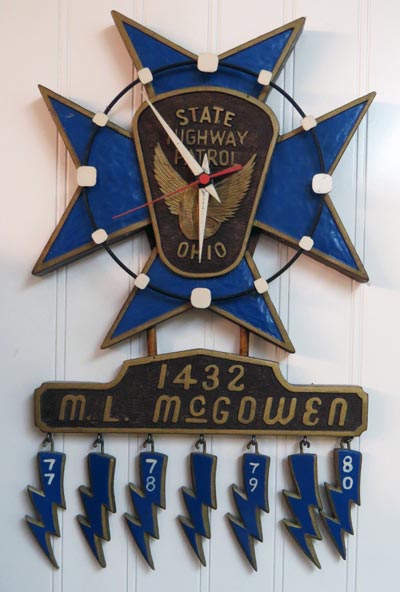
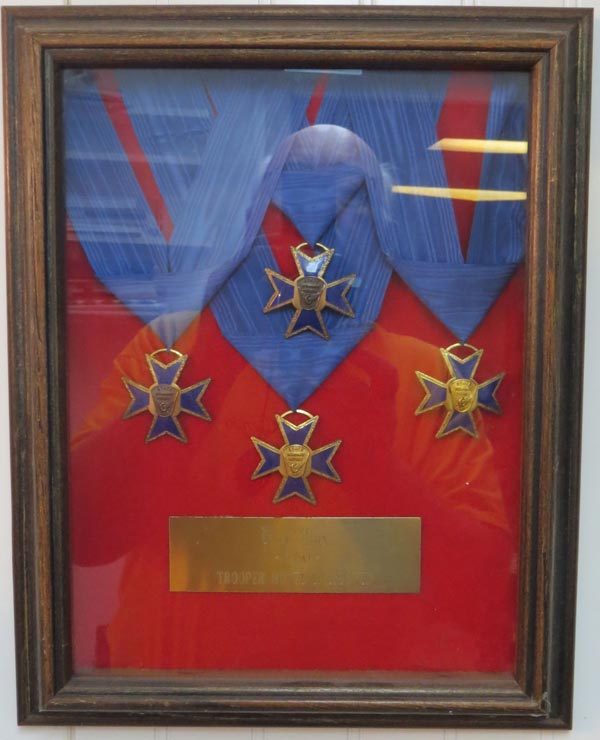 The FOUR Blue Max medals of the legendary Monte McGowen (1977, 1978, 1979 and 1980) OSHP's most prolific Blue Max!
The FOUR Blue Max medals of the legendary Monte McGowen (1977, 1978, 1979 and 1980) OSHP's most prolific Blue Max!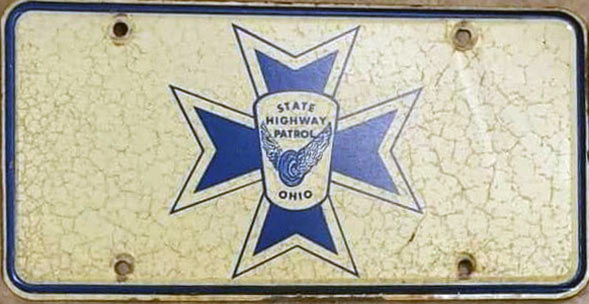 Second issue Blue Max. Late 1970's.
Second issue Blue Max. Late 1970's.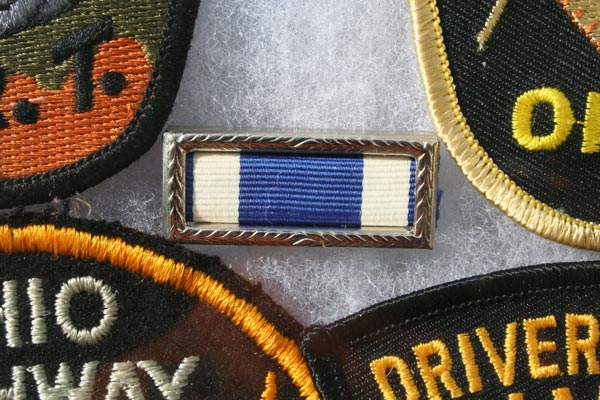 Blue Max service ribbon.
Blue Max service ribbon.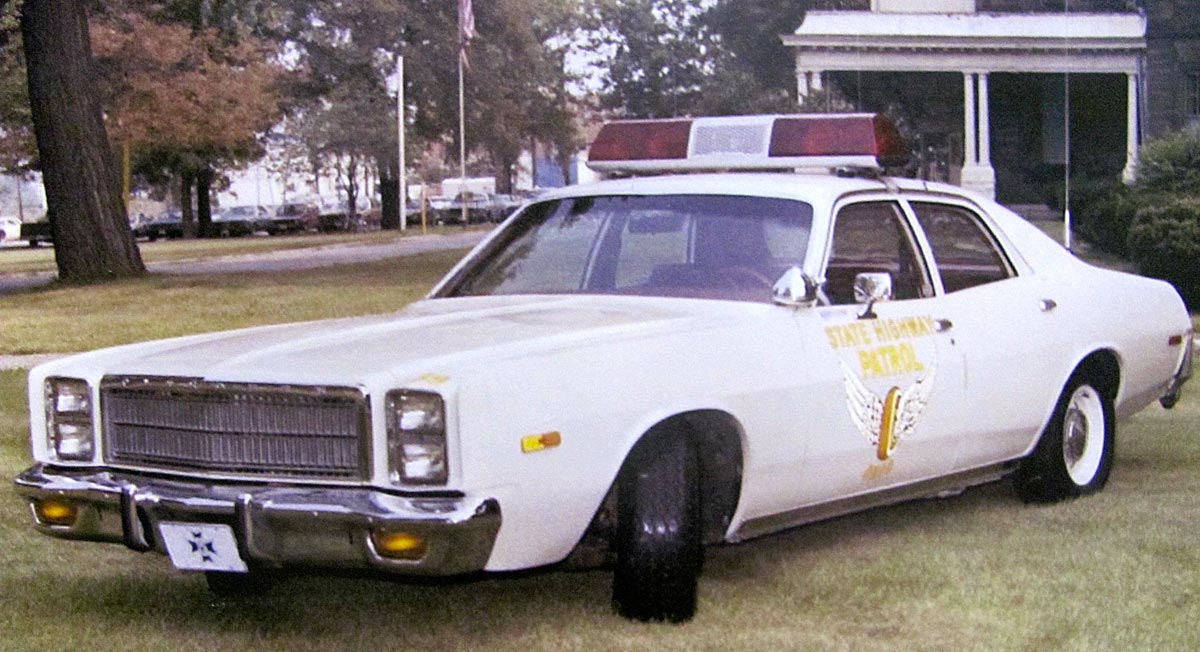
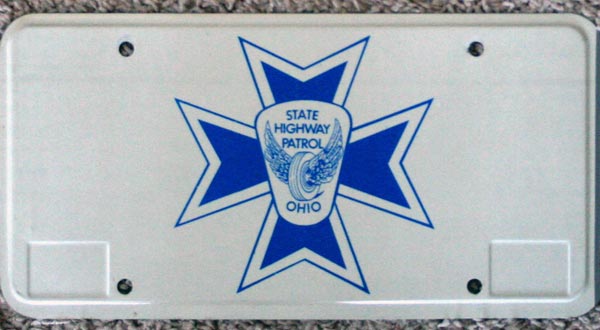 1980's issue Blue Max.
1980's issue Blue Max. 
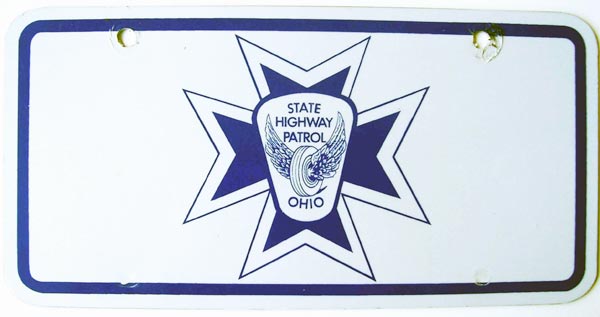 1990's issue Blue Max.
1990's issue Blue Max. 
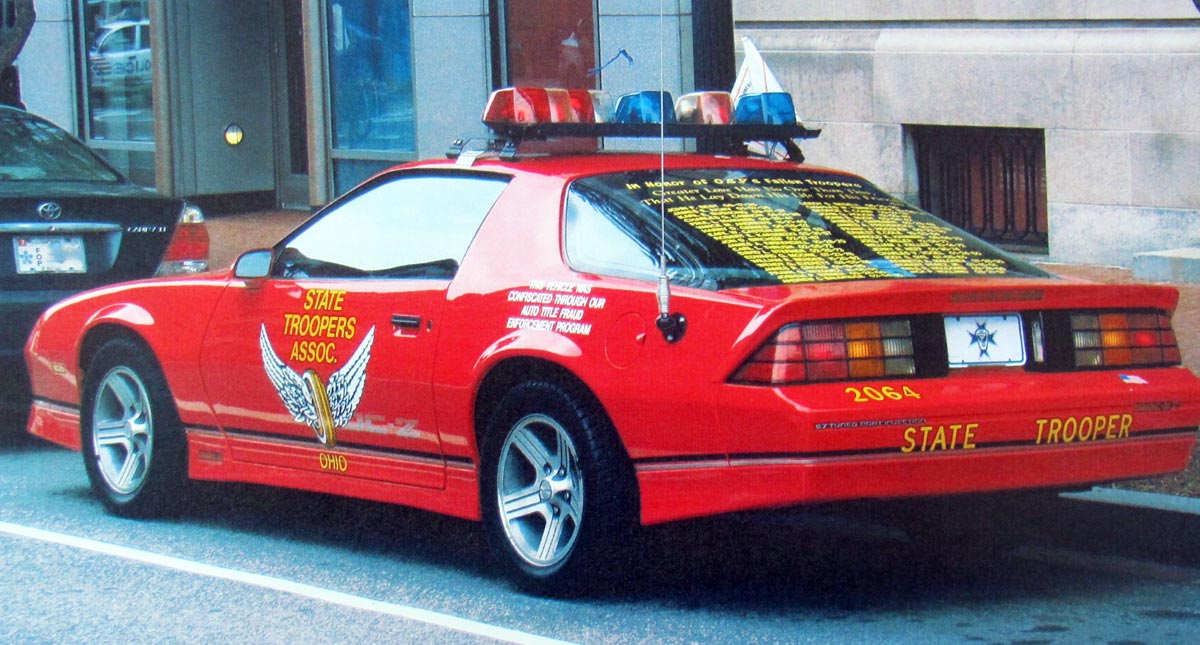
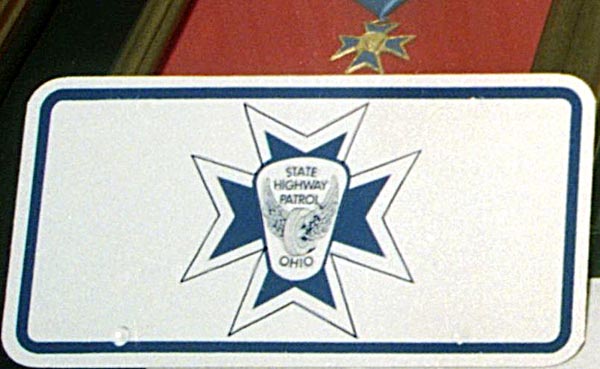 Circa 1995-2000's Blue Max.
Circa 1995-2000's Blue Max.
 C.2010-2016 issue Blue Max.
C.2010-2016 issue Blue Max.
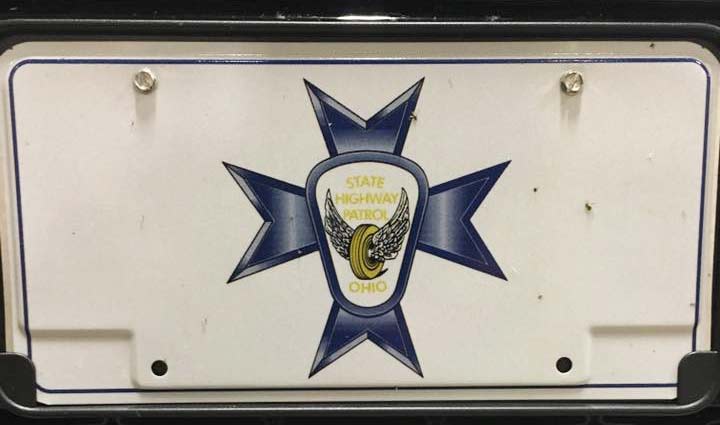 2016-2020 issue Blue Max.
2016-2020 issue Blue Max.
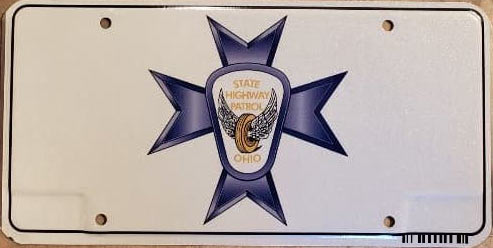 C.2020-Current issue Blue Max.
C.2020-Current issue Blue Max. 
Since the inception of the Ohio State Highway Patrol in 1933, motorcycles were part of its deployed fleet, however no photos from 1933 exist so far of any motorcycles used by the OSHP.
1934, however proved not only the usage of motorcycles for patrol, but clear examples of the license plates used on these cycles at that time.
These early motorcycles mirrored the same color and formatting of the car versions of these plates used by OSHP. They were issued as singles and run on the rear of the bike only.
The 1934 OSHP motorcycle plate was made of embossed steel and measured approximately 4 3/8" x 9 3/8". It was colored white over maroon and had one small circular mounting hole on the far left center of the plate just inside the border embossing, and one on the opposite right side of the plate in the same position. HIGHWAY over PATROL was embossed on the left side of the plate and the assignment number up to two digits was embossed to the right.
OHIO-1934 was embossed along the bottom center of the plate.
This was the first and last time that the title HIGHWAY PATROL was run on OSHP license plates.
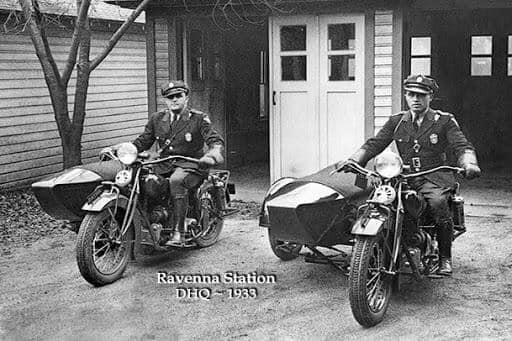 First year- 1933
First year- 1933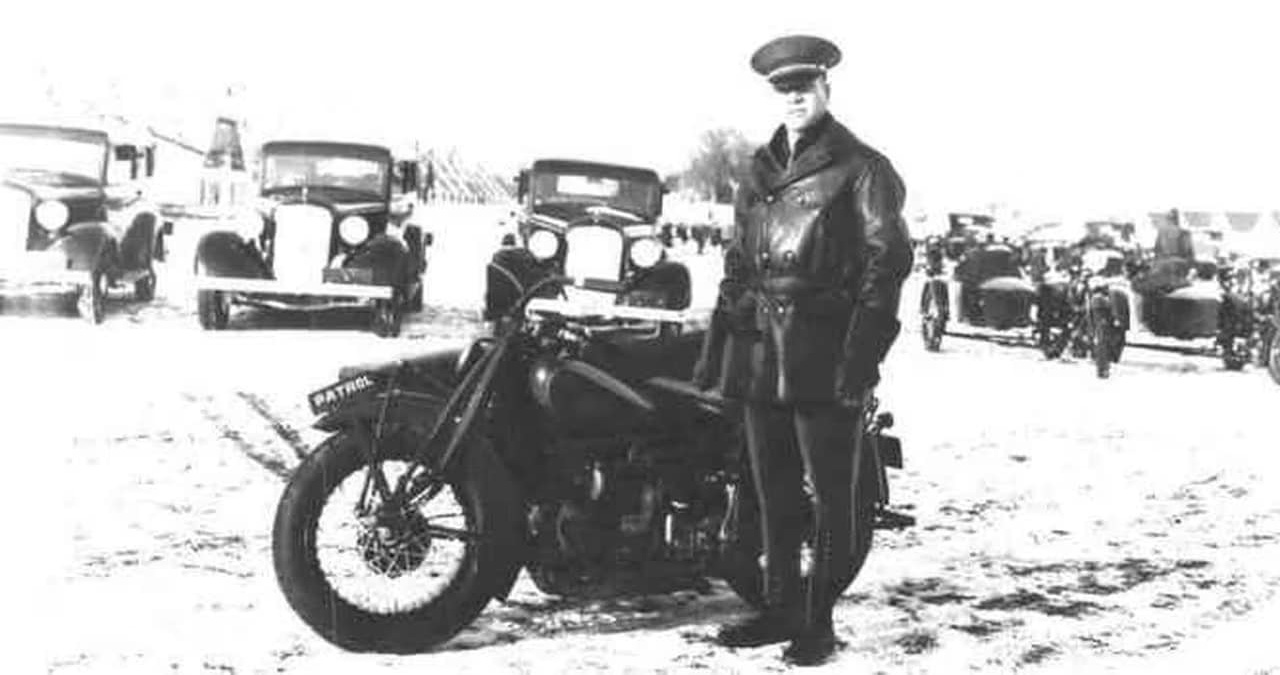 First year- 1933
First year- 1933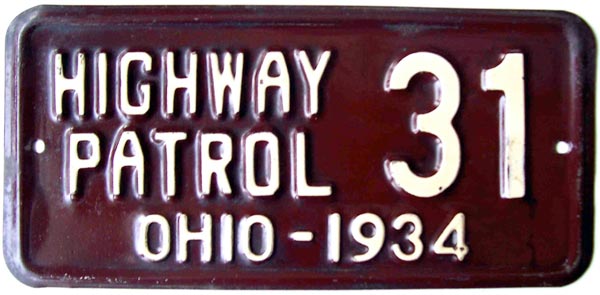 1934 first issue motorcycle.
1934 first issue motorcycle. 
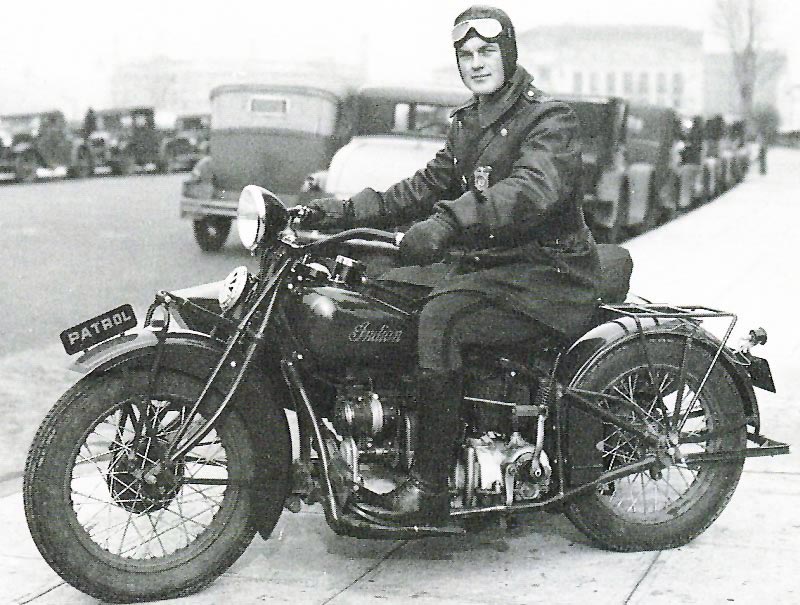
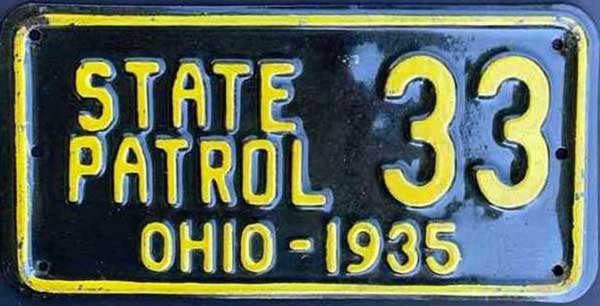 1935 issue motorcycle. STATE PATROL
1935 issue motorcycle. STATE PATROL
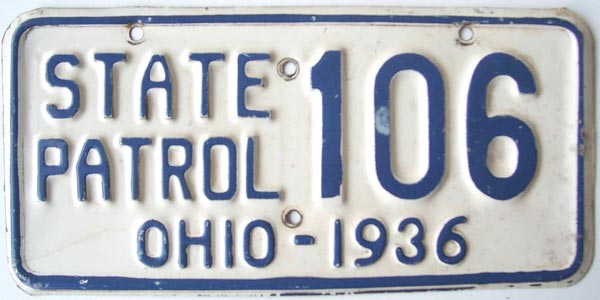 1936 issue motorcycle. STATE PATROL
1936 issue motorcycle. STATE PATROL
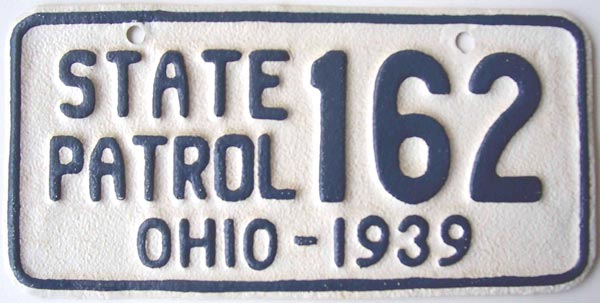 1939 issue motorcycle. STATE PATROL
1939 issue motorcycle. STATE PATROL
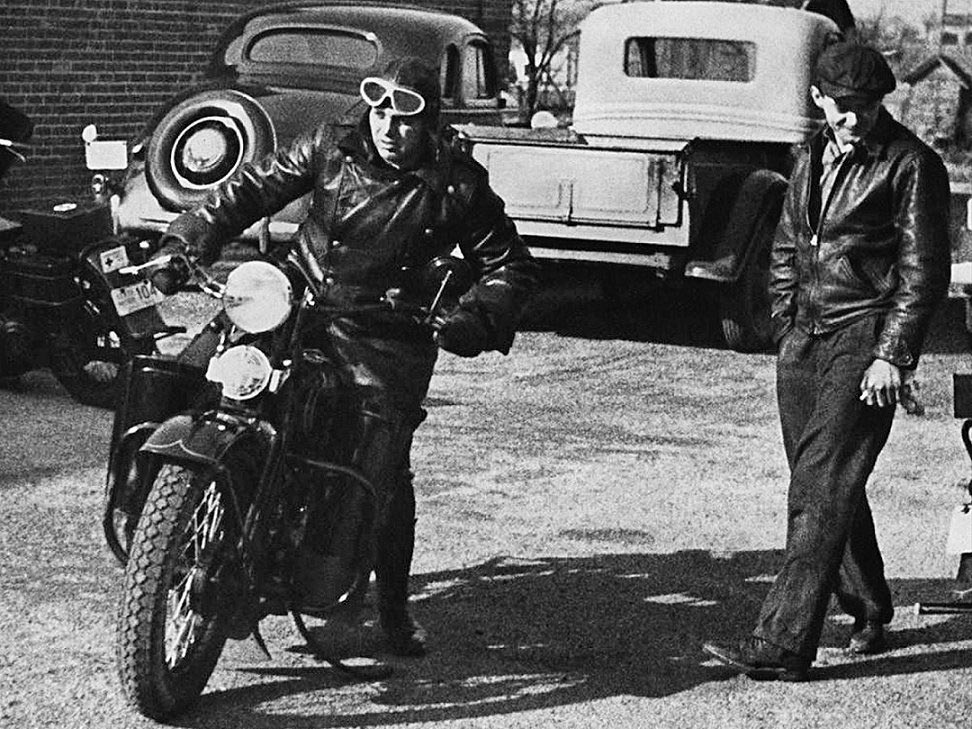
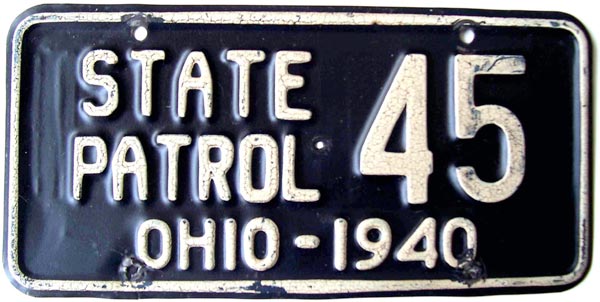 1940 issue motorcycle. STATE PATROL
1940 issue motorcycle. STATE PATROL
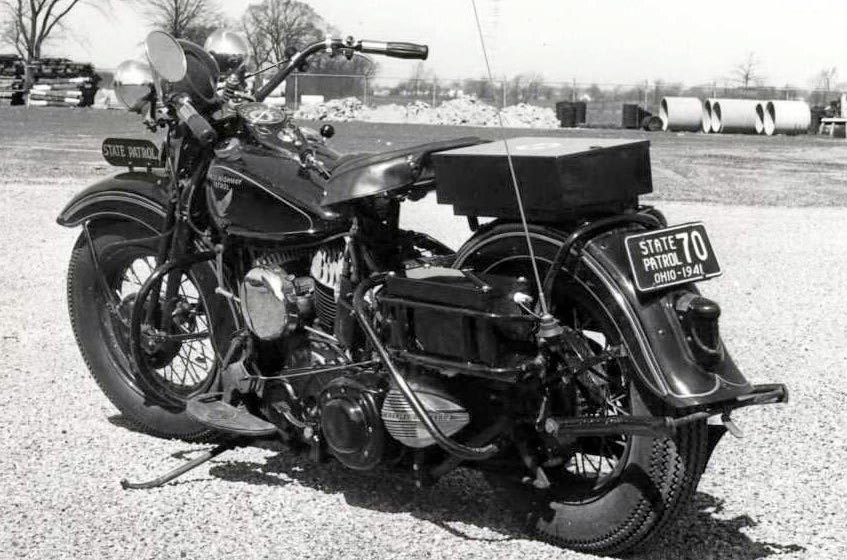
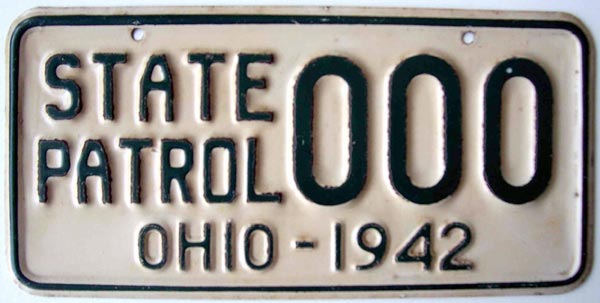 1942 issue motorcycle sample.
1942 issue motorcycle sample.
After a hiatus of over 60 years with none in the OSHP fleet, the motorcycle for patrol made a re-appearance on Ohio highways in 2006. With some planning and training help from the OSHP's northern partners, the Ontario Provincial Police, a fleet of fully-equipped Harley Davidson motorcycles and a group of freshly-trained OSHP Troopers took to the highways and biways of the Buckeye State on two wheels.
The newly reformed motorcycle unit had special license plates made for their rides. The plates were the standard 4" x 7" embossed aluminum plate with a reflective white background. The state name OHIO was embossed at the bottom center of the plate in black. The prefix OSP was embossed in black followed by a number up to 2 digits also embossed in black.
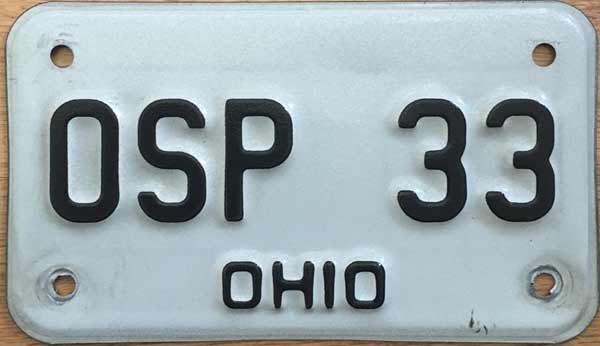 2006-late 2016 current issue motorcycle.
2006-late 2016 current issue motorcycle.
In early 2017, the Ohio State Highway Patrol issued a new graphic license plate for fleet motorcycles.
The reflective white aluminum plate is all silk-screened with black characters with a step border. The words IMPAIRED DRIVERS / DRUG ACTIVITY occupies the top center of the plate. The full color emblem of the OSHP occupies the far left center of the plate. The assignment number occupies the center of the plate. CALL #677 occupies the bottom center of the plate.
There is also a small black bar code on the bottom right corner of the plate.
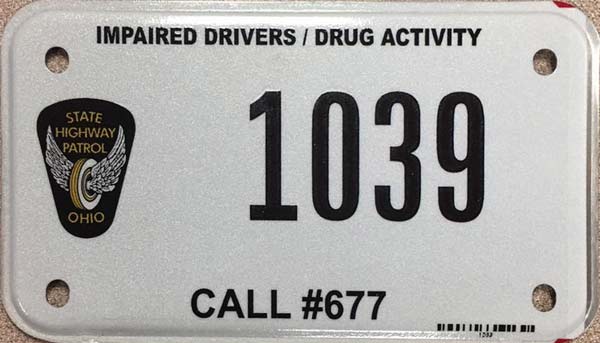 2017- current OSHP motorcycle.
2017- current OSHP motorcycle. 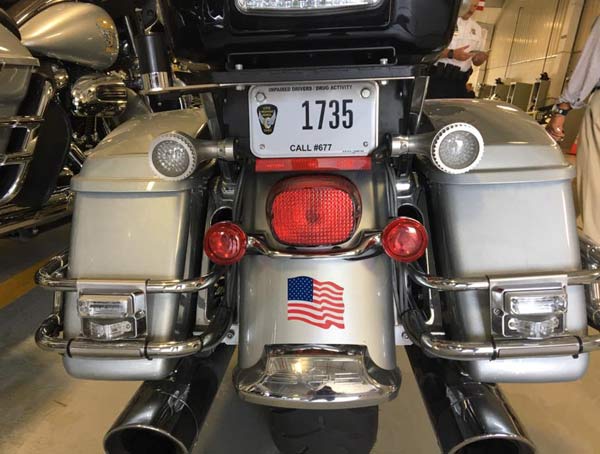
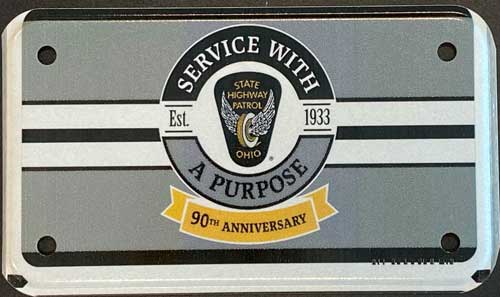 2023- 90th Anniversary motorcycle.
2023- 90th Anniversary motorcycle.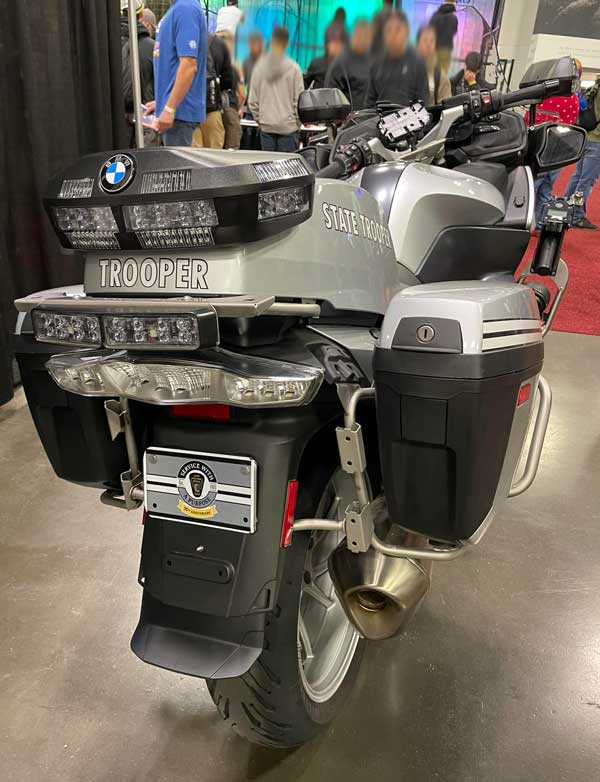
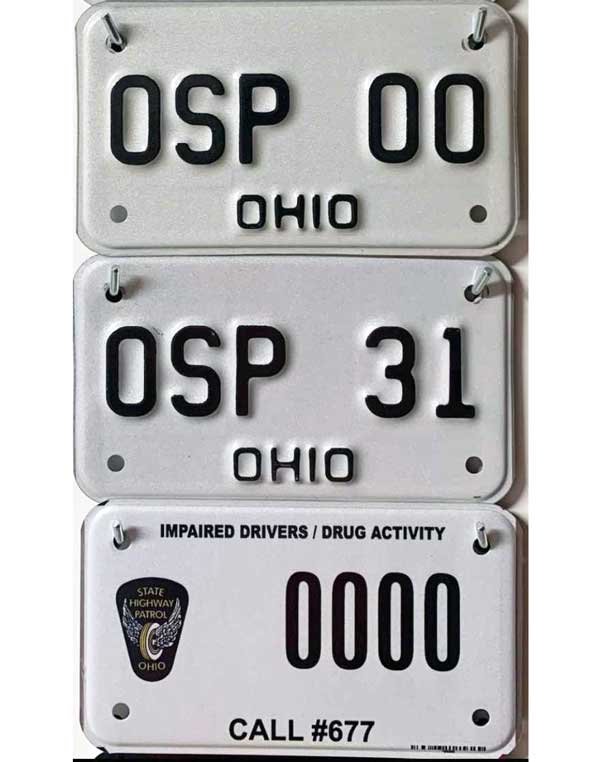 (Courtesy Justin Kleinfelter)
(Courtesy Justin Kleinfelter)The Ohio State Highway Patrol's Motor Carrier Enforcement Unit's primary function is to ensure the safe operation of commercial motor vehicles within the state of Ohio. This goal is achieved through education and enforcement of the Federal Motor Carrier Safety Regulations and PUCO (Public Utility Commission of Ohio) Safety Rules. Commercial motor vehicle troopers and motor carrier enforcement inspectors conduct these inspections.
The unit is also responsible for enforcement of size and weight laws relating to commercial vehicles. The Unit has 10 portable scale teams located throughout the state. A scale team consists of a load limit inspector trooper and two load limit inspectors. There are also 16 fixed scale facilities located throughout the state. All interstate scale facilities are equipped with an electronic clearance system known as "PrePass." Commercial motor vehicles equipped with Prepass will receive an electronic in-cab signal informing the driver whether to pull into the scale or permit the driver to bypass the scale facility. The PrePass signal overrides the posted signs for all trucks including hazardous material placarded vehicles.
Education of law enforcement agencies and trucking companies is a proactive function of the Motor Carrier Enforcement Unit. The unit presents commercial vehicle safety and familiarization education classes. This no cost training is for law enforcement agencies desiring to become more involved in commercial vehicle enforcement.
The Motor Carrier Enforcement Unit partners with several trucking companies to staff static displays around the state. These displays promote highway safety and sharing the road safely with commercial vehicles.
The Motor Carrier Enforcement Unit consists of a Licensing & Commercial Standards Unit Commander, a Commercial Enforcement Coordinator Sergeant and a Motor Carrier Enforcement Supervisor in each district. Commercial Motor Vehicle Troopers and Motor Carrier Enforcement Inspectors are assigned at the district level. The Motor Carrier Enforcement Unit also includes General Headquarters Staff.
License plates displayed on OSHP MCE vehicles are red over reflective white Ohio State Vehicle license plates with a five digit number usually seen in the 46 7## series.
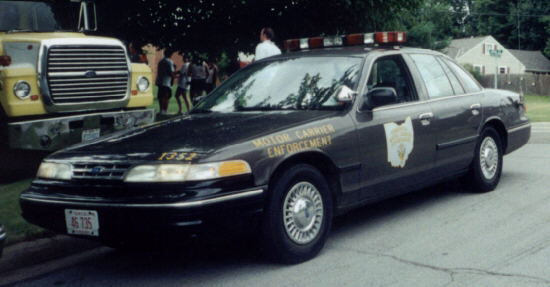
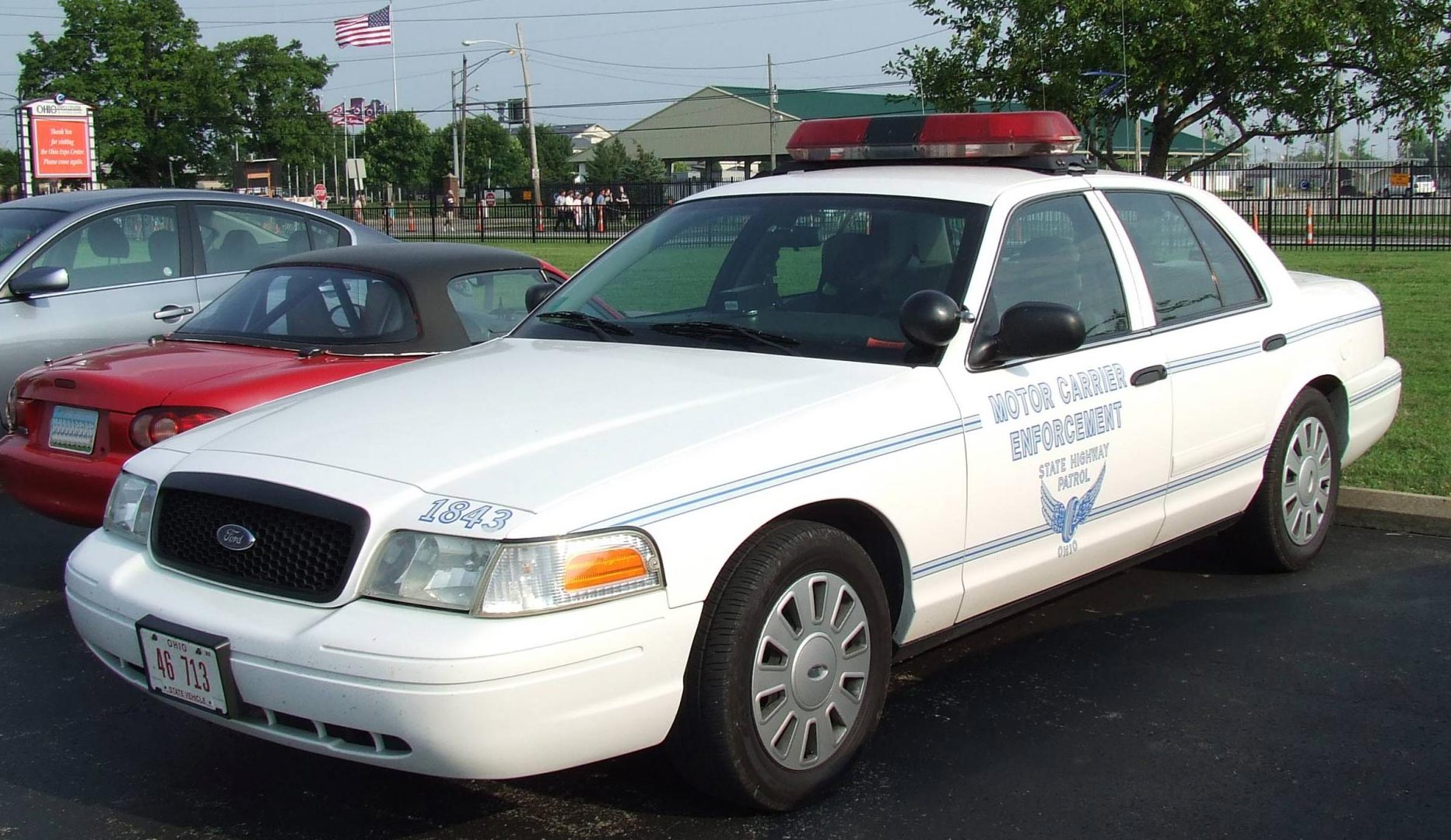
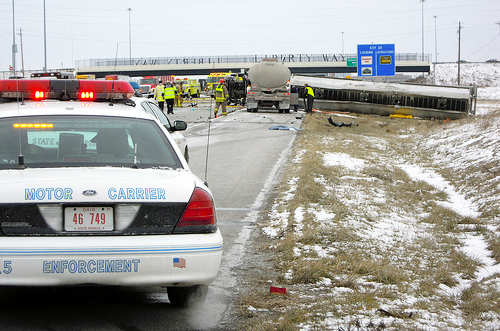
Some time in the 1990's, the Ohio State Highway Patrol was experimenting with a number of different license plate styles in conjunction with the state's Bureau of Motor Vehicles (BMV) in charge of production.
The plates seen below are test samples that were made, some of which appeared to have been used to one degree or another. Most were made on inverted blanks with the validation decal recesses on the top of the plate rather than the bottom. The number 1078 was used on many of them which is a police radio ten code indicating an officer emergency.
The plates you see below are not fakes, they are merely experiments that never made the final cut.
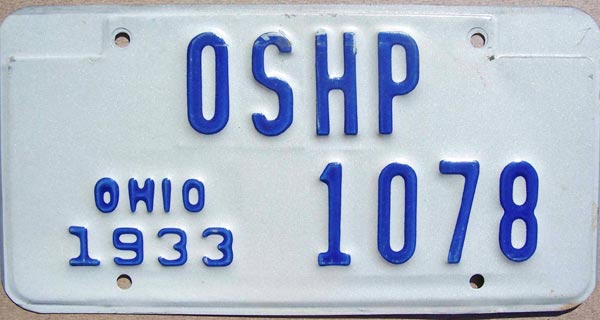 1990's experimental type.
1990's experimental type. 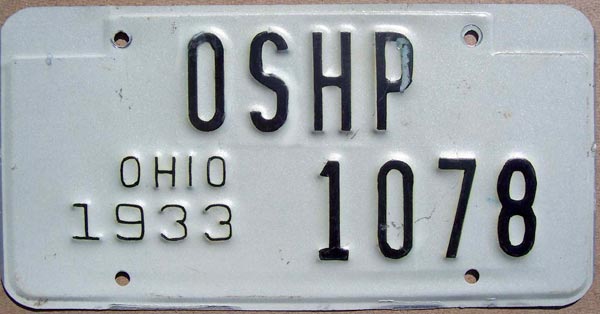 1990's experimental type.
1990's experimental type. 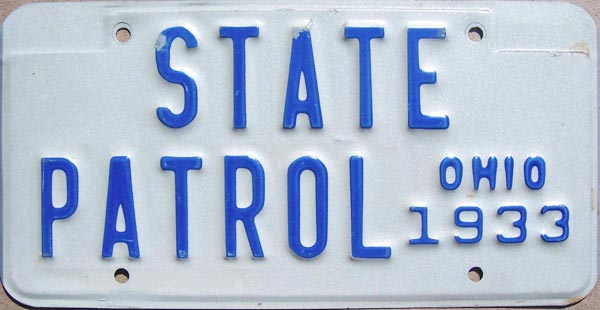 1990's experimental type.
1990's experimental type. 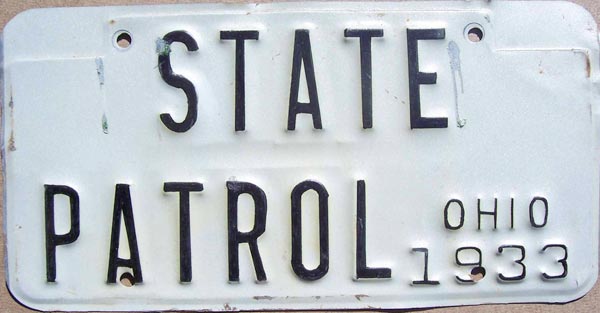 1990's experimental type.
1990's experimental type. 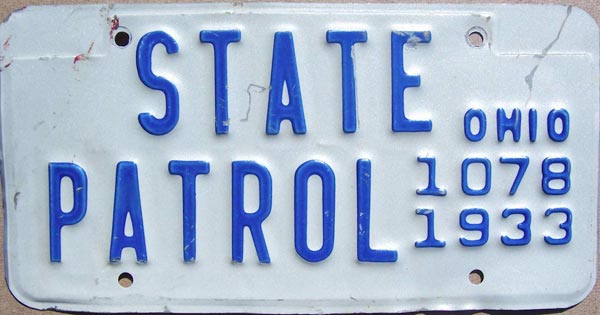 1990's experimental type.
1990's experimental type. 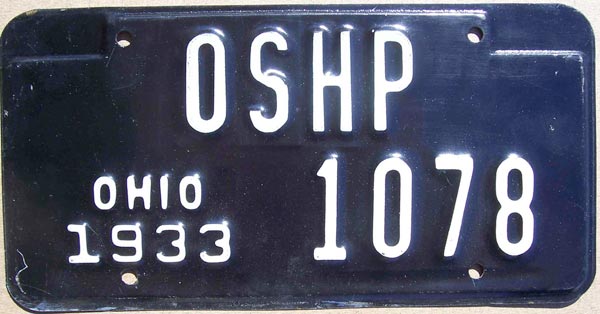 1990's experimental type.
1990's experimental type. 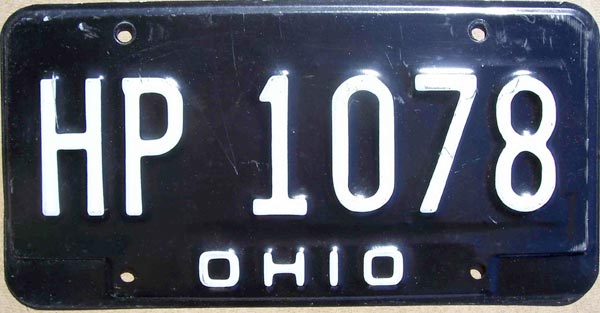 1990's experimental type. HP prefix.
1990's experimental type. HP prefix.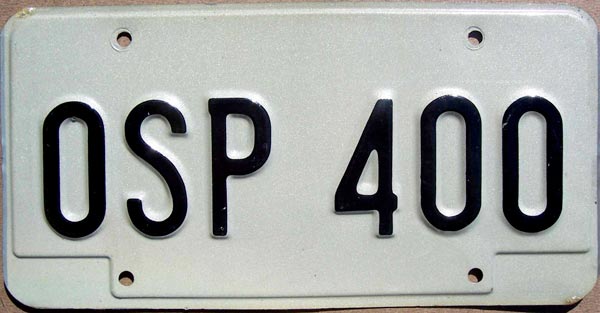 1990's experimental type. OSP prefix.
1990's experimental type. OSP prefix.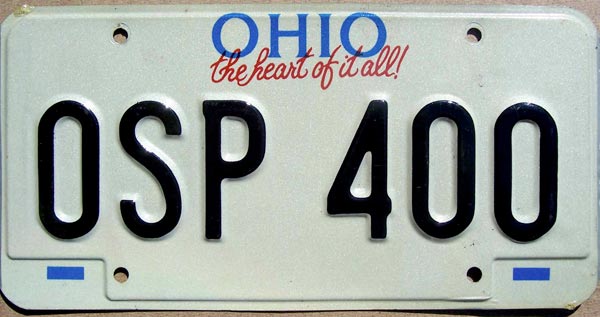 1990's experimental type. OSP prefix.
1990's experimental type. OSP prefix.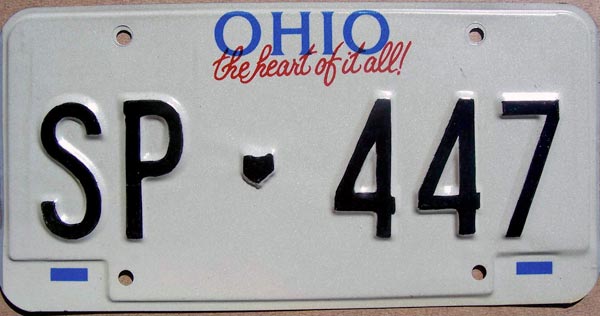 1990's experimental type. SP prefix and state shape hyphen.
1990's experimental type. SP prefix and state shape hyphen.License plate issues not for official use and OSHP license plate frames are shown below:
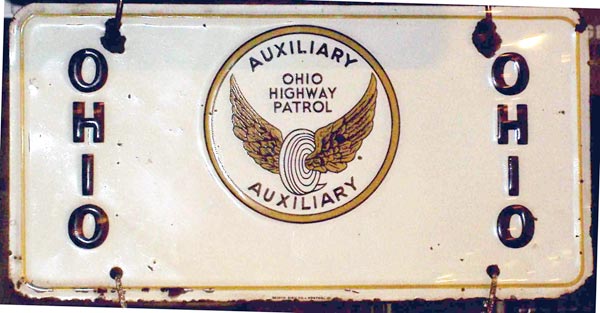 1950's-1960's OSHP Auxiliary booster plate.
1950's-1960's OSHP Auxiliary booster plate.
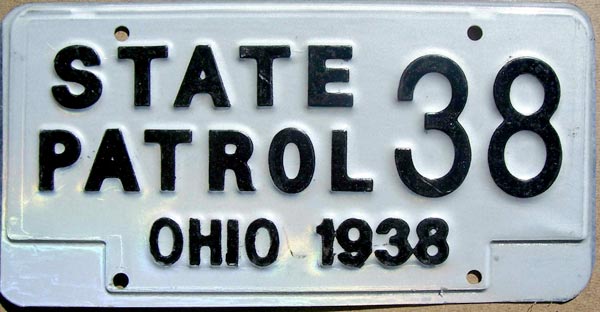 1938 remake for OSHP museum's 1938 patrol car.
1938 remake for OSHP museum's 1938 patrol car.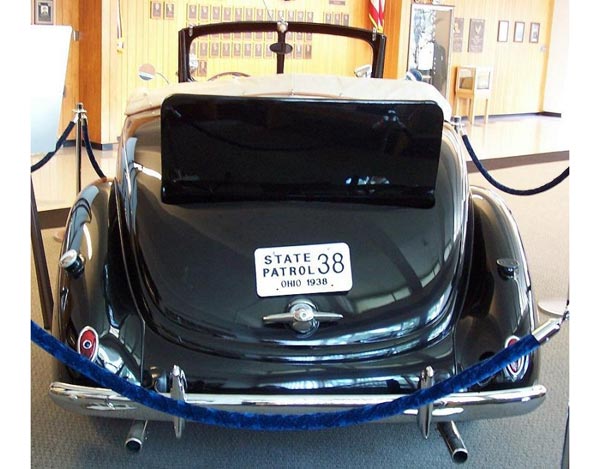
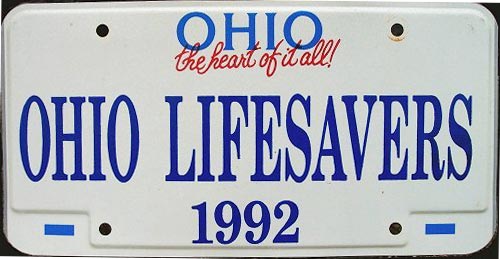 1992 Ohio Lifesavers issue. Issued to OSHP troopers involved in a program where they would ride on trains to observe motorists going through railroad crossings while crossing lights and/or gates were in operation. The trooper would radio another trooper to stop and cite the motorist.
1992 Ohio Lifesavers issue. Issued to OSHP troopers involved in a program where they would ride on trains to observe motorists going through railroad crossings while crossing lights and/or gates were in operation. The trooper would radio another trooper to stop and cite the motorist.
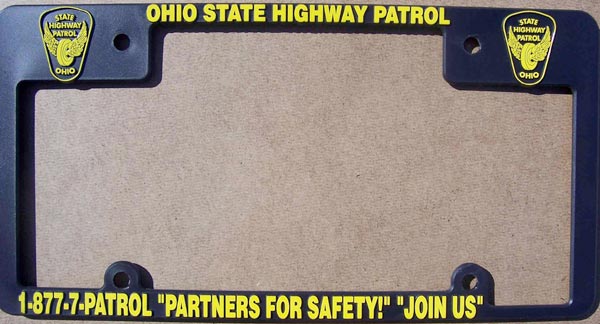 Yellow over black plastic OSHP license plate frame.
Yellow over black plastic OSHP license plate frame.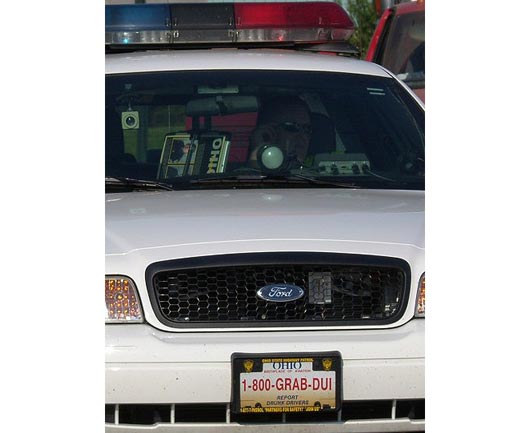
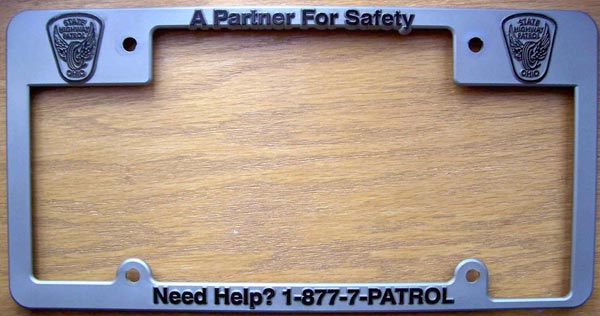 Black over grey plastic OSHP license plate frame.
Black over grey plastic OSHP license plate frame.
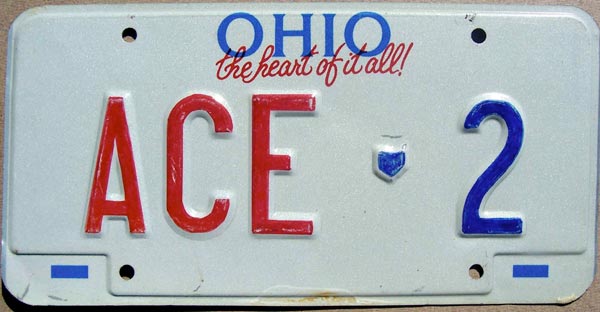 Early 1990's special one-off type.
Early 1990's special one-off type.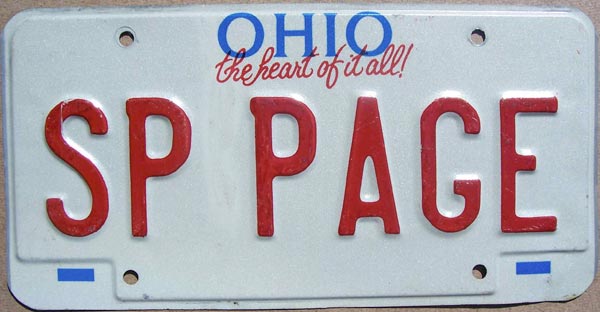 Early 1990's special one-off type.
Early 1990's special one-off type.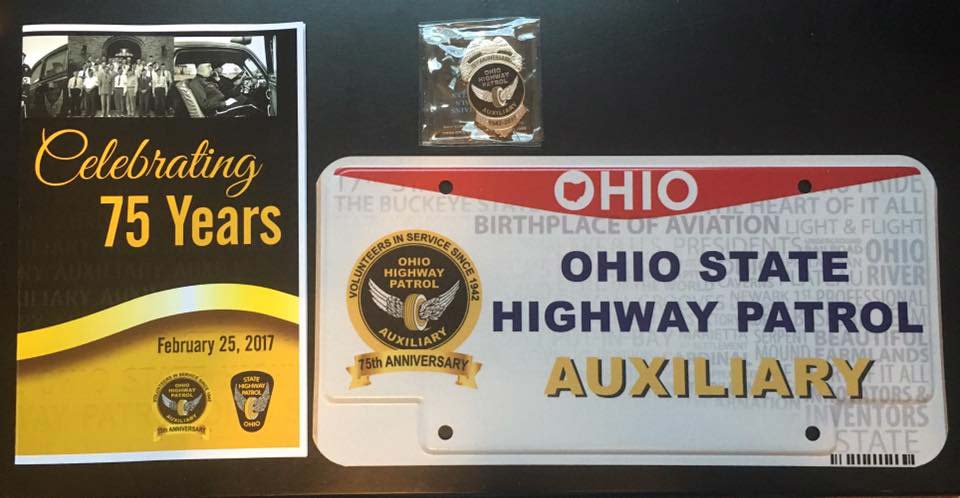 2017 Commemorative issue for the 75th Anniversary of the Ohio State Highway Patrol Auxiliary.
2017 Commemorative issue for the 75th Anniversary of the Ohio State Highway Patrol Auxiliary.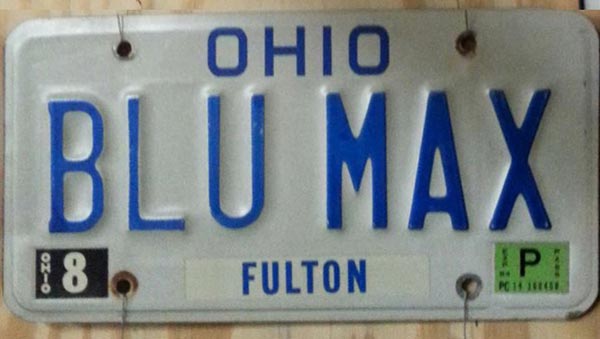 1980's personalized license plate of multiple Blue Max Award recipient, Monte McGowen used on his personal vehicle.
1980's personalized license plate of multiple Blue Max Award recipient, Monte McGowen used on his personal vehicle.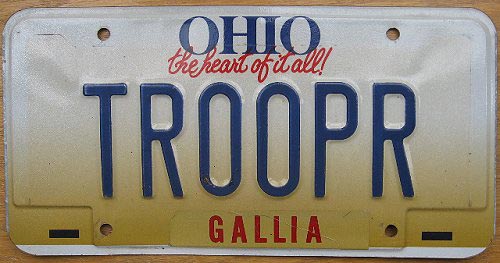 Late 1990's personalized license plate for private vehicle.
Late 1990's personalized license plate for private vehicle. Personalized private issue.
Personalized private issue.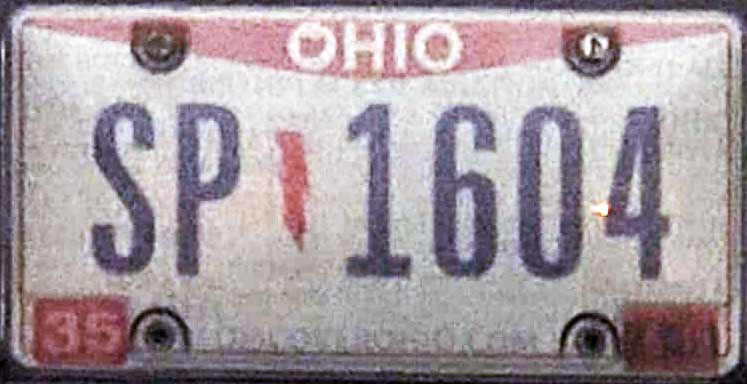 Personalized private issue.
Personalized private issue.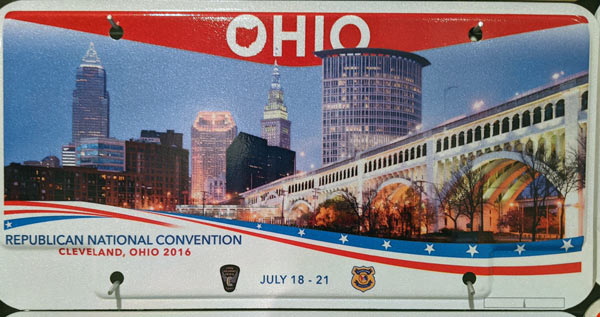 2016 Republican National Convention (Cleveland) Souvenir
2016 Republican National Convention (Cleveland) Souvenir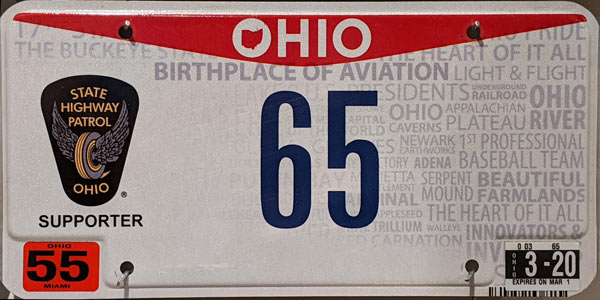 Ohio State Highway Patrol SUPPORTER issue.
Ohio State Highway Patrol SUPPORTER issue.